





EM-380
EM-380

Gooseneck Microphone
Gooseneck Microphone










EM-380
EM-380

Gooseneck Microphone
Gooseneck Microphone





The EM-380 is a uniquely shaped and high quality condenser microphone designed for use in lecture halls, house of worship and paging applications. With power option selectable between battery or phantom power, It can be easily powered up and use.
The EM-380 is a uniquely shaped and high quality condenser microphone designed for use in lecture halls, house of worship and paging applications. With power option selectable between battery or phantom power, It can be easily powered up and use.
Try it now and feel the clarity of your voice.
Try it now and feel the clarity of your voice.











@yamaha_proaudio_official
www.yamaha.com/proaudio








We supply sound, not equipment.
We supply sound, not equipment.
TOAasiapacific www.toa.com.sg
www.toa.com.sg

 Official Yamaha Pro Audio Instagram Account
Official Yamaha Pro Audio Instagram Account
MODERN SOUND PRESERVING TRADITION Renovating Wat Phrayayang temple
A NEW RECIPE FOR BREAD OF LIFE New screens for Jakarta’s Bread of Life
SELF-SERVICE IEM MIXING United Methodist in Leawood gets a Klang solution
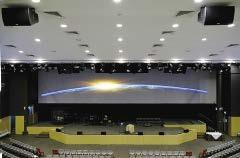



NEW SOUND The Met Church’s new tech director prioritises an audio upgrade


INTERPRETING THE MESSAGE VIA WI-FI Hearing HotSpot aids Tokyo church

BREAKING OUT AT HOLY TRINITY Yamaha solution for a London church
A ROCK SOLID SOLUTION Enhancing the audio at Christ the Rock in Wisconsin


A SOUND RENOVATION The new PA at Gothenburg’s Betlehemskyrkan
A church that is currently under construction in the British village of Isleham provides a good example of how AVL technology can be used in the design phase of new houses of worship. At , The Ark is a significant addition to the worship landscape in the area. As such, it was imperative to ensure that everything was right
When it came to the lighting, the church turned to Jonny Billitt from event production and equipment hire company MTS Live, who recommended the use of Cast Software’s Wysiwyg previsualisation tool. ‘Designers and builders from the project initially contacted me for advice regarding the uplighting,’ recalled Mr Billitt. ‘The main design requirements were to uplight the Hammer beams and room extremities, also achieving a good ambient lighting level.’
The software was used to import building CADs and overlay installation schematics for the uplighters while the floor was being laid. This meant that the cabling could be installed in the correct place. The building render and subsequent lighting design expanded on this. ‘Using Wysiwyg I was able to demonstrate the concept using the 360-export feature, exhibiting the suggested fixtures and how they would realistically illuminate the building,’ explained Mr Billitt.
By using previsualisation software, The Ark has been able to see what the end result will be before the building was constructed and make the design changes it wanted early in the process. This presents obvious financial and practical advantages and is something other houses of worship around the world looking at new sites could consider.
Enjoy the magazine!
Telephone: +44 (0)1892 676280 Email: jling@worshipavl.com
Karen Wallace:



T: +44 1892 676280

F: +44 1892 676282
LICENCES
Singapore: MICA (P) 032/07/2017
PPS 1644/05/2013(022954)


‘Mahajak handled the audio systems installation for three rooms at the multipurpose Woralaksanawadee Pavilion, in order to be used by the priest for Buddhist activities and events arranged by the temple,’ she continues. ‘The customer wanted a sound system that was easy to maintain and user friendly.’
chosen suited the end user by focusing on ease of use while meeting their budget. They can set up and configure the system from the Epm12 audio mixer.’
Buddhist temple in Bangkok with a rich history. While it is a place for reflecting on Buddha’s teachings, the temple’s management was looking to the future when commissioning a renovation that would promote new activities and education, as well as worshipper safety, with the installation of modern facilities such as an airconditioning system, an elevator, a fire alarm, new lighting and a high-speed internet connection.
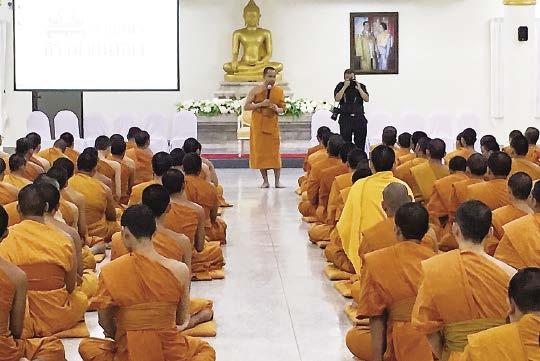
‘The building was worn out without any new facilities constructed since the reign of King Rama III,’ explains Arom Amyaem, sales project manager at A/V systems integration company, Mahajak Development. ‘The purpose of the renovation was to provide modern equipment while preserving and maintaining the religious and historical significance of the Thai architecture.’
Due to its previous work at Wat Pathum Wanaram temple, Mahajak
‘As the audio system was to be installed in an ancient building with certain preservation requirements, there were limitations in where we could position loudspeakers, as specified by the architect from the Fine Arts Department,’ recalls Ms Amyaem. ‘The idea was for sound to cover all areas, but to keep the loudspeakers hidden.
To keep the loudspeaker setup as discrete as possible, Mahajak equipped each of the three rooms with 16 compact JBL CSS-1S/T speakers with three JBL CSMA 112A mixer/ amplifiers and a Soundcraft Epm12 mixing console at FOH. At the start of the signal chain, speakers can choose between three Shure PG48 wired microphones and three Shure SVX24/ PG58 wireless vocal systems.
‘We explained the pros and cons of each system we presented to the client for their consideration,’ explains Ms Amyaem. ‘The system
Reverberation presented the challenge typical of many houses of worship; however, the Mahajak team was able to overcome this by adjusting the sound levels accordingly while training the users at the temple. The new sound system subsequently passed its first true test during Wat Phrayayang’s official re-opening.
‘The customer was very satisfied after the official opening by the Supreme Patriarch of Thailand,’ Ms Amyaem confirms. ‘We were glad that they trusted in our team and we are so proud to have a played a part in this religious preservation.’


www.mahajak.com
www.watphrayayang.com
INDONESIA: As part of a recent refurbishment, the Bread of Life Church in Jakarta sought a visual solution to keep its congregation engaged with video content and IMAG. Due to budget restraints that are common to houses of worship the world over, the church approached systems integrator Gigantika Pratama Prima for an economical, televisionquality display solution.
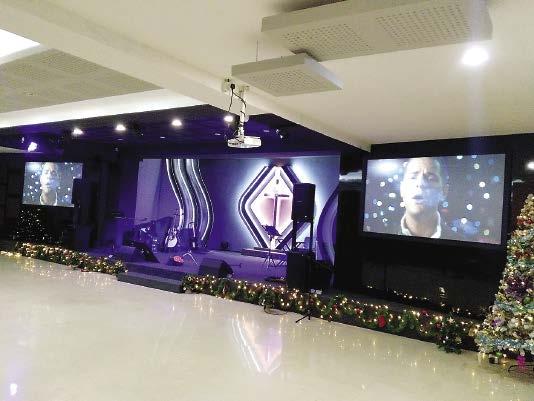
‘We have a different solution than other systems integrators,’ explains Stevi Aristi of Gigantika. ‘We offered a dnp Screens system as an alternative display concept to traditional television screens.’
The Gigantika team installed a pair of 100-inch dnp Supernova
EB-W41 projectors flown from the ceiling. ‘The screens provide good contrast, despite the high level of
spotlights on the stage and the ambient lighting,’ adds Ms Aristi. ‘They offer easy maintenance
and are economical in terms of electrical consumption.’
The installation was completed within Bread of Life’s budget, reportedly achieving a significant cost saving when compared to the flat panel options available. ‘The client is very satisfied with the results and the service provided,’ concludes Ms Aristi. ‘dnp’s Supernova Core achieved such a great performance that the congregation thought they were looking at LED TVs.’
www.dnp-screens.com

www.epson.com
www.gigantika.co.id
www.voiceimbolc.com


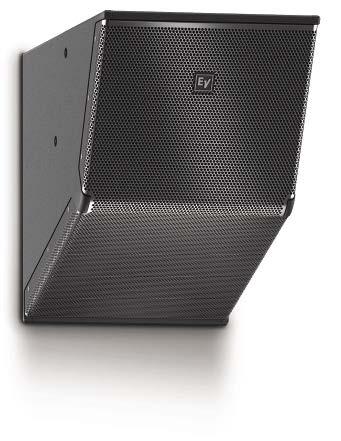
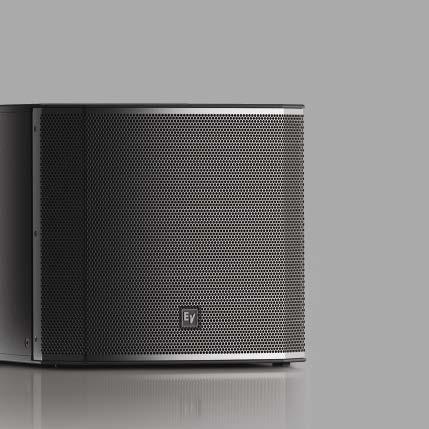
Superior audio quality for small/medium applications is more affordable and more reliable than ever before with the EVC series – the latest addition to the Electro-Voice EV-Innovation family of installation-dedicated loudspeaker systems.





• Unique technology – Including Automatic Saturation Compensation (all models) and a Variable Intensity (VI) model.



• Part of the EV-Innovation family – With similar voicing and looks, and matching mounting and input panel accessories.

• Flexibility – Five base models, available in black and white, with coverage patterns suitable for a wide range of indoor/ outdoor sound reinforcement scenarios.
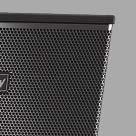

Learn how EVC can work for you at www.electrovoice.com

Higinbotham along with fellow audio engineers Jordan Tracy and Steven Moduno – decided to seek alternative ways to raise performance levels for the church’s musicians at the new main sanctuary in Leawood. A decision was made to acquire two Klang:fabrik 3D in-ear monitor (IEM) mixing systems from Klang:technologies which now allows the performers on stage to dial in what they want to hear

the Klang:app on iPad, essentially freeing house audio engineers from monitor duties.

USA: With just over 22,000 followers, United Methodist Church of the Resurrection in the small town of Leawood, Kansas is the largest United Methodist congregation in the US. Apart from Leawood, the church has additional locations in Olathe, downtown Kansas City, Missouri and Blue Springs, Missouri with an average weekly attendance for all campuses of around 11,000 people.
With such large services, the audio staff in Leawood –namely lead audio engineer Tim
Most of the integration for the 3,500-seat main sanctuary was done by Progressive Electronics, while the systems have been installed at a second worship and event space that is currently being renovated at the former sanctuary. ‘The installation took us less than 10 minutes,’ says Mr Higinbotham. ‘It was clear that this was the direction we wanted to go moving forward, and we will be installing the Klang system in our newly renovated space as well.’
‘Over the course of installing the DiGiCo SD10 consoles that are now in the new main sanctuary and the newly renovated event space, they were introduced to the Klang system,’ adds Mr Tracy. ‘When we realised that the Klang IEM system can be integrated with the SD10 consoles, we realised that this was the way we wanted to go.’
www.cor.org
www.klang.com
USA: The Met Church in Houston recently brought in a new tech director, Josh Cash, who made it his top priority to upgrade the church’s outdated sound system. Since the last audio update at The Met Church in 1997, a full praise band with electric instruments and a broadcastcalibre approach to video production had been implemented for services.
Scott Clark, a design engineer from systems integrator Diversified Engineering Sciences put together a new sound solution based on Bose’s ShowMatch DeltaQ array loudspeaker technology, working alongside the manufacturer to meet The Met’s needs.
‘The worship centre [at The Met Church’s Jones Road campus] is the standard Baptist church: a fanshaped room with raked pews that go up side loges all the way to the balcony,’ explains Mr Clark. ‘The stage is more contemporary, but the seating is more traditional. It’s a fairly tall seating shape with a reasonably short back wall. Like most churches, you’re not really doing an extremely
long throw; you’re doing what I would call a medium throw. But, you are doing a lot of vertical coverage, and that can present issues in terms of design. One of the reasons for choosing Bose was that it’s nice and easy to design an array system that has a lot of vertical coverage with fewer boxes that doesn’t have any high-frequency gaps.’
‘I wanted it to sound the same everywhere,’ adds Mr Cash. ‘And I wanted stereo for music. But I also didn’t want people to get drawn to the sides when somebody’s teaching, which is half of our service, and I think the most important part. So, I wanted centre localisation as well.’
The system installed comprises 21 ShowMatch modules, eight
ShowMatch SMS118 subwoofers, two Bose Panaray LT 9702 WR loudspeakers as side-fills and four RoomMatch Utility RMU208 units. The two main arrays are arranged in an L-R configuration and flown above the stage. These each consist of five ShowMatch SM5s, one SM10 and two SM20s, equipped with SM20WG12 waveguides. The centre array, satisfying Mr Cash’s design criteria for centre localisation, features one SM5, two SM10s and two SM20s, also equipped with SM20WG12 waveguides. The entire setup is powered by 12 Bose PowerMatch PM8500N amplifiers, while a ControlSpace ESP-880 with a Dante expansion card is used for digital signal processing.

‘I feel like we could put our new system up against anybody’s,’ says Mr Cash. ‘What I love about it is, if I’m walking from the front of the room up the rake into the balcony, it sounds like one speaker.’
pro.bose.com
www.themet.church


JAPAN: Houses of worship with a multilingual congregation are faced with the challenge of ensuring that everyone in attendance receives and understands the message being spoken by the worship leader. This is the case at Tokyo
services in Japanese, yet attracts a large number of English-speaking attendees each week. It is thought that as many as 10% of the church’s followers speak English as a first language, while many others favour the Korean tongue. Tokyo Church of Christ was already equipped with an interpretation system in order to translate its sermons to non-Japanese-speaking members of the congregation; however, many complained that it was ‘difficult to hear’. In seeking a replacement solution, the church discovered Williams Sound’s Hearing


which transmits via Wi-Fi. Hearing HotSpot is primarily intended as an assistive listening solution for the hard of hearing, although it is capable of serving as a language interpretation system. It streams audio over a Wi-Fi network from a wide range of sources, directly to a user’s smartphone or tablet. The user simply needs to download the Hearing HotSpot app from the iOS or Google Play store, meaning there is no need for the church to distribute devices to those who require use of the service and that, theoretically, an
unlimited number of congregants can make use of it.
Williams Sound’s Japanese distributor, Media Plus, guided the church with the system setup and in how to make full use of it. As a result, Hearing HotSpot is serving as an interpretation system for English- and Koreanspeaking congregants, and as an assistive listening solution for the hard of hearing that wish to hear the Japanese sermon clearly. In addition, Tokyo Church of Christ is exploring other uses for the system, including the possible addition of a Chinese translation for each service, and the Hearing HotSpot app’s ability to distribute weekly news bulletins and other information to the congregation.
www.mediaplus.co.jp
www.tccnet.org
www.williamssound.com

UK: Holy Trinity Brompton (HTB) is a London-based church with four sites. Its flagship Brompton Road sanctuary is located in close proximity to the Natural History, Imperial War, Science and V&A museums, as well as Harrods department store. The sanctuary comprises a primary worship space and several ‘breakout rooms’ separate from the main building where meetings and other, smaller functions can be held.
The breakout rooms have been designed as self-serving facilities, which means users of all levels operate the A/V systems installed. Ease of use is therefore key to equipment choices and led to the
recent deployment of a pair of Yamaha MCP1 surface-mounted control panels.
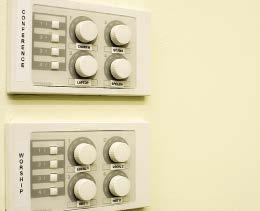
The MCP1s were equipped as part of a digital audio upgrade and mirror an MRX7-D matrix processor and DCP series control panel already
installed in the main building. HTB production staff are able to transmit the Yamaha control protocol from the breakout rooms to the main building via the existing standard IT network that links them.
‘The systems are set up to autoschedule, which resets the input level parameters overnight,’ reveals Joe Sunley-Smith, production supervisor at HTB. ‘We have used the access management features to ensure that all settings are locked, so the only parameters users can change are the levels. We use zone control in one of the rooms, so users can also choose which zone is operational.
Additionally, we use an SD card in the MRX7-D’s slot for easy playback routing across the different rooms.’
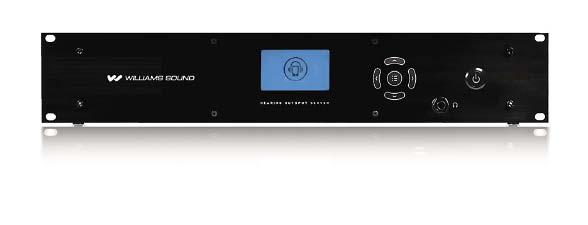
Mr Sunley-Smith worked with PF Events on the installation, which also included a Yamaha TF-Rack digital mixer.

‘When we planned upgrading the analogue system to digital, we wanted to standardise the rooms so people would be familiar with the systems, no matter which one they use,’ Mr Sunley-Smith concludes. ‘We are working towards this across all of our four main sites and breakout rooms. We are planning an A/V upgrade for four self-serve rooms at our Onslow Square site this year, which will be fitted with the same MRX7-D and MCP1-based system.’
www.htb.org
www.pfevents.com
www.yamahaproaudio.com
USA: Christ the Rock Community Church in Wisconsin has played a major role in helping the local community for the last 35 years. In fact, the church is seen in the eyes of many as being, rather conveniently, the rock for the 18,000 or so residents of Menasha.



The decision was recently taken to enhance the sound system in the 1,200-seat sanctuary and properly utilise a Biamp DSP unit equipped with a Dante output already installed. It was up to the church’s former technical director, Scott Tomashek – who happens to be director of A/V design engineering at Camera Corner Connecting Point (CCCP) – to come up with the right solution.
‘We came to learn that although the sound reinforcement system
had great components, they weren’t the right system for the room,’ says Mr Tomashek. ‘The speakers had coverage patterns that were too tight so not everything got covered, and there was weird lobbing on top of that. It was rewarding to be on this project because I got to design the system that we always felt we should have had from the start.’
Mr Tomashek and Christ the Rock’s current technical director, Andy Cox, compared several solutions during an audition process. An SLS Audio Ribbon line array solution was ultimately chosen along with Ashly Audio’s nXSeries amplifiers.
The Biamp DSP was installed along with a new sound system recently set up in the church’s lobby and Mr Cox
wanted to use this for processing the new system in the sanctuary. This led to the selection of the Ashly amplifiers. ‘I needed an amp that would accept a Dante input but that didn’t have DSP built in – because why spend money on DSP the church didn’t need?’ explains Mr Tomashek. ‘I also needed an amplifier that would be reliable for the long run. Ashly’s nX-Series of amplifiers was perfect. Ashly’s got the history and the reputation, and I could order amps with Dante and no DSP.’
The new sanctuary setup comprises nine SLS CPA7600 loudspeakers flown in a central cluster with left and right side arrays of eight CPA660 SLS loudspeakers each. A pair of 4-channel Ashly nXe8004 network amplifiers drive the top components of
the central cluster and the entirety of side clusters. Meanwhile, a 4-channel Ashly nXe1.54 network amplifier drives the low-mid components of the central cluster, while another one has been bridged to form a 2-channel amplifier that powers two SLS dual 18 subwoofers.
‘Installing the Ashly amps was easy, and the Dante setup was quick and smooth,’ Mr Tomashek concludes. ‘We met all of our design goals, and it was satisfying to finally hear the room the way we had always wanted it to sound.’
www.ashly.com


www.cccp.com

www.christtherock.org
www.slsloudspeakers.com
coastal city of Gothenburg recently underwent a renovation to its sanctuary. As with the majority of churches the world over, music and the spoken word are at the heart of Betlehemskyrkan’s services and, as such, the works included an analysis of the installed sound system. Systems integrator Tech 4 Event AB was brought in to assess the church’s requirements, exploring the room’s acoustics to determine the best option to serve the Betlehemskyrkan’s 800 congregants. When it was decided that
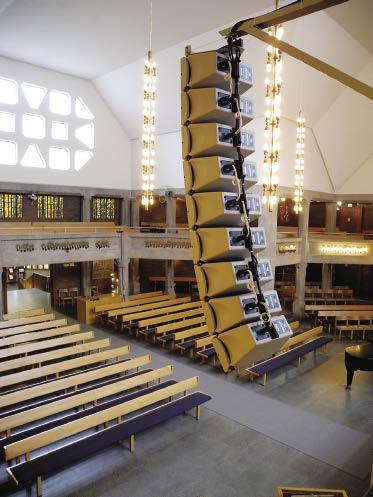
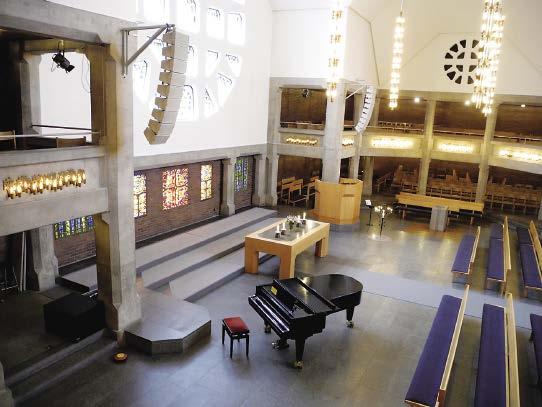
multiple loudspeaker brands.
‘Such a test is rewarding for the customer,’ says Björn Carlsson, CEO of Tech 4 Event. ‘In this way, they get an opportunity to listen to different systems before choosing what to install. Not only to experience that one system sounds better than anything else, but above all in order to determine whether the systems fit into their premises and the activities that are going on there.’
Winning the shootout was Nexo’s Geo M6 line array and nine were flown
per side. Prior to installation, Tech 4 Event took measures to improve the building’s acoustics, such as replacing the ceiling.
‘We used an NTi XL2 acoustic analyser, which enables us to document acoustics, frequency, sound pressure and STIPA value; the assessment of speech comprehensibility in the room,’ explains Mr Carlsson. ‘We used this tool before, during and after the installation. Through these metrics, we could ensure a range of parameters to gauge which improvements have been made, and to verify that the requirements in the preliminary study were achieved.’
The Tech 4 Event team ran several computer simulations to determine
the optimum speaker placement. ‘All measurements from the room were added to the system, along with data from the drawings of the church from the architect,’ recalls Mr Carlsson. ‘Then we got a 3D model of the whole church room, and in this case we used Nexo’s own software, NS-1, which enabled us to configure and optimise performance of the system by simulating its behaviour in the current location. We found out how many speakers we needed of a particular model to solve the assignment and reach the desired end result, but above all we found out where in the room we would need to install the selected speakers for the best results.’
To help the new cabinets blend in with the room’s aesthetics, the systems integrator obtained a RAL colour from the architect to custom paint the loudspeakers and flyware.
‘We know from experience that, using the right technology, it is possible to create good sound systems that can also look nice and blend into the church room,’ Mr Carlsson notes. ‘In this case, we mounted the speaker system on a heavy concrete beam between the floor and ceiling, and the assembly wanted the speakers to pick up the colour from the concrete beam.’
www.betlehemskyrkan.se
www.nexo.fr
www.tech4event.se
USA: The Church of Notre Dame in Western Pennsylvania was experiencing audio challenges caused by its existing boundary podium microphone. Parishioner John Durisko, who is also the president of pro audio services company Satin Sound Systems, took on the task of finding a new solution that would deliver intelligible sound for all speakers, whether they were of the quiet, nonprojecting sort or with big, booming voices.
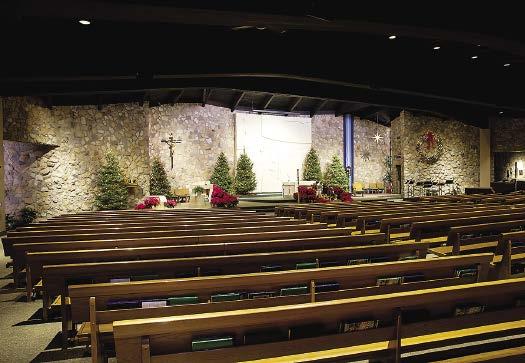
While looking into the options, Mr Durisko considered DPA Microphones’ d:screet SC4098 podium microphone. He believed its uniform off-axis response would make it ideal for the variety of voices that take to the lectern. ‘We used DPA on several political projects last year and I was excited to see how
it would work in this setting,’ Mr Durisko says. ‘We tried a couple of different microphones at the podium and, as expected, DPA worked best.’
The new microphone also needed to be mounted to the church’s marble podium and long enough to reach above the podium shelf during
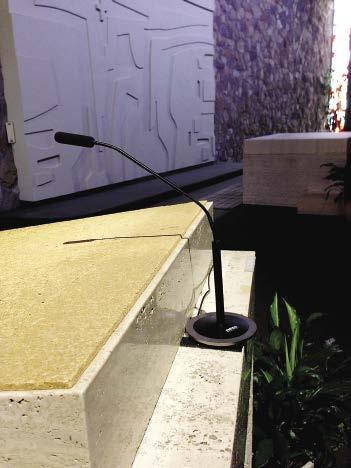
readings, particularly when a thick book was being read from. Flexibility was also a prime requirement, as the gooseneck needed the ability to be adjusted per the speaker, without wobbling, bending or being moved over time.
‘We found a supplier and fabricated a 6-inch piece of stainless steel that slides right over the gooseneck,’ explains Mr Durisko. ‘This sleeve provides the strength and support needed, allowing it to work. With a bit of the gooseneck revealed at the top, we are able to turn the mic toward the speaker. We painted the stainless steel and it not only looks great, but with the DPA capsule it sounds flawless.’
www.dpamicrophones.com
www.notredame-pa.org
www.satinsoundsystems.com
Customized installation with SOMMER CABLE
Wide range of bulk ware and ready-made cables


High quality connectors by HICON and NEUTRIK
Large choice of multicore & power distribution solutions











Modular systems for installations or mobile use



Electronics for multimedia infrastructures

Big stock and fast delivery
11. - 14.04.2018


Modular & flexible connection panels
Also available in white and other colors!
HDMI® 2.0 toolkit for easy testing of source and sink devices

Electronics for HDMI®-, HDBaseTtransmissions and more












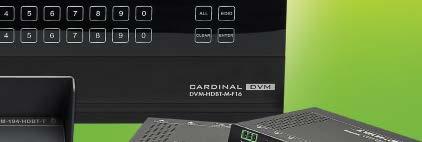







SOMMER CABLE based in Straubenhardt/Germany was founded in 1999 and is now one of the leading suppliers of professional high-quality cable and connection technology with a focus on the audio, video, broadcast, studio and media technology sectors. The product range including the in-house brands HICON, CARDINAL DVM and SYSBOXX covers cable bulkware, connectors, connection cables, individually adaptable distribution systems and electronics.

A B2B shop with over 25,000 products is available 24/7.
Order your FREE CATALOG!
ZIMBABWE: Based in Harare, Jabula New Life Covenant Church sought new life of its own as it staged an ‘Open Sunday’ event at the Rainbow Towers Hotel and Conference Centre in the Zimbabwean capital city. As well as attracting potential new congregants to the church, the event also served to inspire its existing worshippers. Approximately 4,500 people attended the special service, which featured a blend of praise music and preaching from Bishop Tudor Bismark, the church’s pastor.
Events Evolution was hired to provide the lighting and audio systems for Jabula’s Open Sunday. ‘Given that this was a temporary event at a busy conference centre, we had only a limited time to set up,’ reveals Blessing Bero of Events Evolution. ‘However, we did not want this to take away the influence of our lighting. This is a big event for one of the biggest churches in the country, so we worked to create an impactful
lighting rig in a short time.’ Mr Bero and his team made their impact by designing a ‘simple’ rig formed from Chauvet Professional fixtures. The rig was built around two lines of midstage truss that ran approximately 9m across with five Rogue R1 Beams and six Intimidator Hybrid 140SR fixtures spaced across the lower line of the truss. These were used to create sweeps across the stage during key moments of the service and served as audience lighting. The upper line of truss featured four Rogue R2 Wash fixtures and a raft of Colorado 2-Quad
Zoom VW units and 24 SlimPAR Tri 12 IRC PAR style lights. Additional Colorado and SlimPAR fixtures were flown on the lower line of truss to
downlight speakers and wash the stage colour.
When it came to striking a balance between the short time frame and building a lighting rig designed to make an impact, Mr Bero explains ‘the compactness of the Chauvet fixtures along with their versatility and output made it possible for us to get the best of both worlds’.
On the audio side, Events Evolution deployed a TW Audio setup comprising 12 Vera36 tops with the same number of S33 subs. T23N tops covered the balcony, while a C15 speaker was used underneath. ‘Mixing all the audio was the Allen & Heath dLive C2500 mixer and stage monitoring was handled by a GLD80 Chrome, networked via Dante,’ concludes Mr Bero.
www.chauvetprofessional.com
www.facebook.com/eventsevolution
www.jabulanlcc.org
www.twaudio.de
six UP-4XP cabinets handle the left and right sides under the balcony. Six 900-LFC low-frequency control elements deliver the church’s deep bass requirements. Following installation, the system’s first real test came during the church’s Christmas celebrations.



USA:
Andrew’s Presbyterian Church in Newport Beach, audio lead and FOH mixer Joe Cristina was given the task of finding a new loudspeaker system to replace an aged point source setup. Having enjoyed a career as an orchestrator and arranger, Mr Cristina approached evaluations of potential new systems with a musician’s sensibilities.
Upon completing his assessment, Mr Cristina selected a Meyer Sound Lina system, which was supplied by Octane Audio. ‘My first impression of Lina was that it is a truly musical system,’ reveals the audio lead and FOH mixer. ‘When used with the orchestra it sounds like real instruments. Yes, it has a great
and lows. But it’s that clarity in the middle, the mid-range detail that I’m looking for, and that’s where Lina really delivers.’
The installation marked a pair of firsts for Meyer Sound’s Lina compact linear line array loudspeaker: the system’s first installation in Southern California and its first installation inside a house of worship. The setup comprises left and right arrays that each contain 10 Lina enclosures. Providing reinforcement for the far wrap-around seating are the manufacturer’s UPQ-2P loudspeakers designed for narrow coverage, while four UPM-1XP loudspeakers serve as centre under balcony-fills and
‘We have a string quartet playing with our worship band – a rock rhythm section and lead singer,’ says Mr Cristina. ‘I arrange the string parts, and last year, try as I might, I could not get the string parts to come through with clarity over the band. But this year, with Lina, I said to myself, “Wow, now I can distinctly
that’s rather important.’ Although music is Mr Cristina’s priority, he understands that vocal intelligibility is of the utmost importance. ‘The most important element for church sound is the spoken word,’ he confesses. ‘We used to have a problem with speech clarity in the balcony, but with the Lina system those problems are gone. We’ve had compliments from the first Sunday. Laypersons who know nothing about sound have told me the difference is night and day.’
www.meyersound.com
www.octaneaudio.com
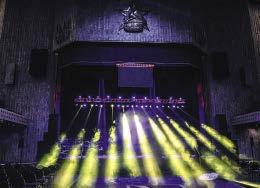


USA: The Chapel is a nondenominational Evangelical church with eight campuses in the Chicago metropolitan area, the largest of which is its Grayslake facility, led by worship pastor Trent Cowart. With an interest in music, Mr Cowart has a strong technical background, having managed a contracting and A/V rental company before transitioning into life as a pastor. As a result, The Chapel has been able to take advantage of the latest digital technology.

The most recent addition to the church’s technical inventory is a pair of TASCAM US-20x020 USB audio/MIDI interfaces. With a wealth of inputs and outputs, eight Ultra-HDDA mic preamps and a built-in DSP mixer, they are used for The Chapel’s praise band.

‘We have a keyboard that has an amazing feel but the sounds aren’t so great, so I send MIDI from its 5-pin DIN MIDI out to one of our US-20x20s,’ reveals Mr Cowart. ‘The MIDI data goes to a computer running Ableton Live, which I’m using as a sort of container for virtual instruments, such as Native Instruments Komplete. The audio from the virtual instruments comes back to the US-20x20, where we submix the instrument sounds and send the submix to our FOH and monitor console. So we’re using the US-20x20 as a MIDI interface, a submixer and an audio interface.’
Physically located near the drums, the second US-20x20 was
INDIA: Newly implemented DEL115 loudspeakers from Dynatech have hit the right note at the St Thomas Catholic Church in Chandrapur.

‘The clergy and management of the church were seeking an efficient loudspeaker system that would improve the quality of speech and music delivery for their special celebratory services,’ notes Liberty Electronics’ Urjesh Gupta, who consulted with the church over
the installation of the Dynatech loudspeakers. ‘After a brief look at the options available, they opted to go for the Dynatech DEL-115 loudspeakers owing to their great quality and delivery, and also for the fact that they were one of the most price-efficient products in the range, delivering a feature set that no other model in its class did. And in the end, it worked out alright.’
www.sonotone.in
brought in for monitoring following the purchase of the first unit. ‘The interface we were using previously did not sound as good as the US20x20, and it was unreliable,’ says Mr Cowart. ‘I had to reset that piece more often than anything else we use. So we’ve switched to another US-20x20, which is functioning as an audio interface for another computer running Ableton Live. We use that Ableton station to play loops, control the clicks and play backing tracks. We submix those in the interface and output four audio channels. I want to route my stereo in-ear monitor mix from our monitor console into the US-20x20 and route it out the headphone outputs for our drummer’s in-ear monitors.’
www.chapel.org
www.tascam.com
USA: Hosting two contemporary worship services each Sunday with praise vocalists, a 30-voice choir and a band with keyboards, drums, acoustic and electric guitar and bass, services at Grace Fellowship Church in Bogart, Georgia are also recorded and streamed live on the church’s website for congregants unable to attend in person. This all drove a recent analogue-to-digital renovation at the church, undertaken by dB Integrations.

‘Grace Fellowship had an older analogue mixer and wanted to move to digital for its flexibility and for their streaming broadcast,’ reveals Ronnie Stanford of dB Integrations. In finding the right digital mixer for its broadcast audio needs, Grace Fellowship auditioned several

Allen & Heath S Class digital mixing system with S5000 Surface, DM64 MixRack, DX32 Expander and seven ME-1 personal mixers with an ME-U Hub. ‘Hands down, there was no question about which mixer was the winner,’ confirms Rick Freeman, technical advisor to the church.
The dLive is used for both FOH and monitors. Choir members rely on in-ear monitors fed by six of the ME-1s, while the seventh ME-1 is used to mix the streaming broadcast. ‘We stream both of our services on Sunday and the dLive provides a clean, adjustable mix but the ME-1 allows us to make minor adjustments easily,’ adds Mr Freeman.
www.allen-heath.com
www.dbintegrations.tech
www.graceathens.com
INDONESIA: Having resided at the Integrity Convention Centre in Jakarta’s Mall Mega Glodok Kemayoran since 2008, the GBI Praise Revival Jesus (PRJ) has evolved significantly. Under the watchful leadership of Pastor Dr Janto Simkoputera, PhD, the ninth and 10th levels serve as the main church headquarters for eight smaller CK7 satellites in the Indonesian capital city. Just as the congregations have grown, the A/V technology within the rented space that is the 10th-storey grand ballroom attempts to keep pace with the worship requirements. Having called upon several suppliers to upgrade the visual aspects of the worship experience in 2014 – including PT Harmoni Yogia Inti Sellaras with Datavideo switchers and recorders – the GBI-PRJ committee recently turned to PT Promedia Innovative Solution (PIS) to refresh its audio system. Enhancement of the stage monitoring together with side-, rear- and front-fills dictated the supply of a d&b audiotechnik system
four years previously. Supplementing the FOH Q-Series speakers, Max12 wedge monitors, six ceiling suspended Qi7 delays, five Qi10 front-fills and a single V10P central cluster powered by D12 amplifiers
literally filled the gaps. Having been in use for 10 years, the Q-Series has been relocated to serve in one of the CK7 satellites, while an extensive J-Series now provides intelligibility and even dispersion within GBI-PRJ. The L-R arrays comprise six J8 and two J12 3-way cabinets per side, providing 80° and 120° horizontal dispersion, respectively. The wide room dimensions require side-fill for its capacity congregation and these are catered for with the addition of four per side V8 cabinets. Low-frequency extension is further enhanced in the form of six J-Sub and two J-Infra subs ground stacked in front of the stage. Having dispensed with an in-ear monitoring system,
the musicians and choir favoured a wedge speaker solution and this is achieved via 14 low-profile Max2 and two M4 models.

In the four intervening years between PIS being called to GBIPRJ, d&b audiotechnik significantly enhanced its inventory of amplifiers. Remotely controllable via the d&b Remote network, through either Ethernet or CAN-Bus, the latest d&b amplifiers incorporate DSP capabilities for comprehensive loudspeaker management, switchable filter functions, remote capabilities and user-definable controls.
Five 30Ds cater for the stage monitors, while nine D80 amplifiers are required for the J-Series and V-Series modules and subwoofers. Sixteen-band equalisation including parametric, notch, shelving and asymmetric filters together with up to 10s of delay can be applied to each of the amplifiers’ four channels.
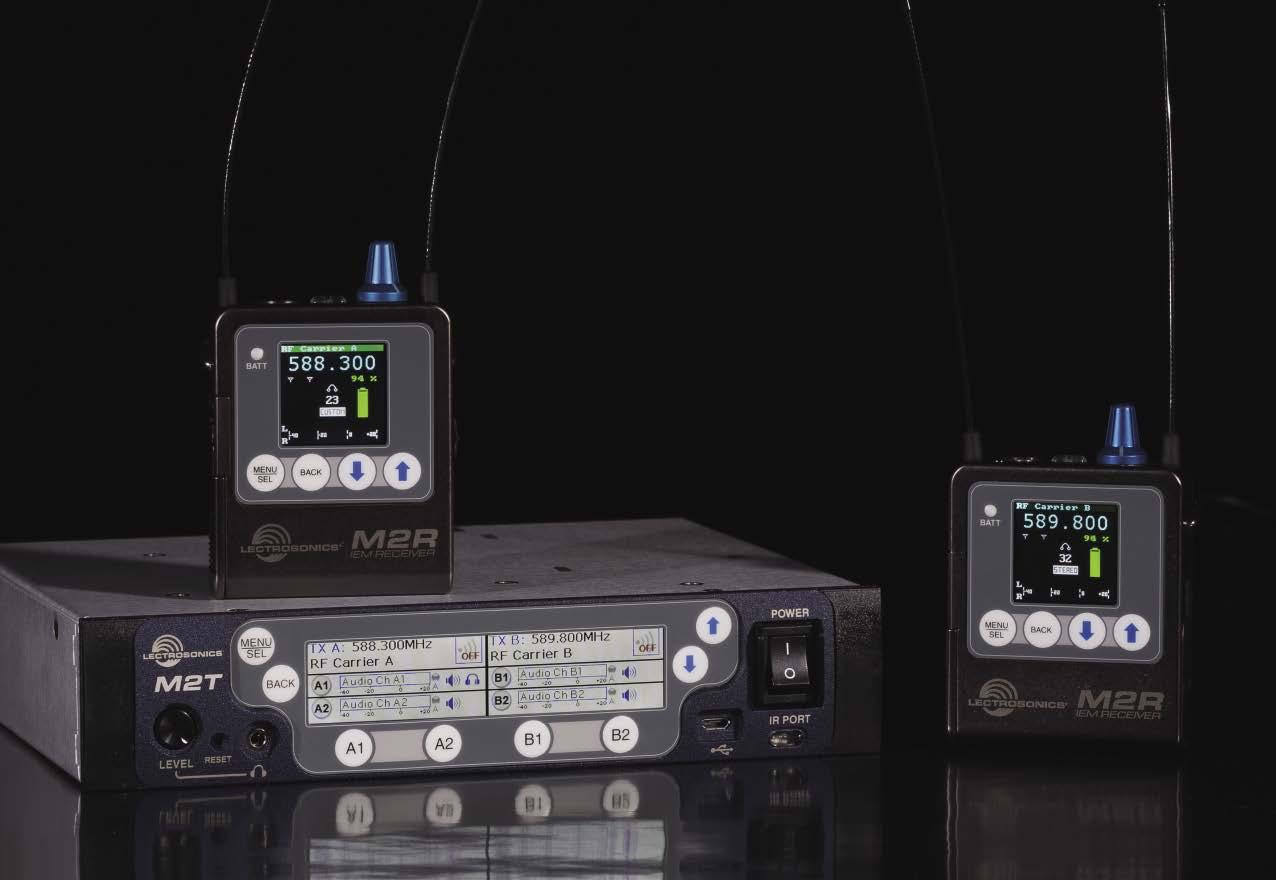

CK7’s satellites will be anticipating GBI-PRJ’s next audio upgrade in approximately 10 years’ time. ‘GBIPRJ’s congregation has provided us with great reviews of this new audio system, so we are very happy,’ comments PIS director, Yosua Yan Heriyanto.
www.promediasolution.com

CONCEIVED BY FINNISH–ITALIAN state architect Carlo Bassi in 1823 and constructed by renowned Finnish church builders Jaakko and Heikki Kuorikoski, Maaninka Church opened its doors in 1845. A traditional, wooden church, it is part of the Evangelical Lutheran Church of Finland and is now a listed building with seating for a congregation of 1,200. The church had been equipped with a sound system for a number of years, although churchgoers would often report that poor coverage and intelligibility were affecting their overall experience during services. In an effort to improve the worship experience, Maaninka Church approached systems integrator Avek Esitystekniikka for a solution to its audio woes. The solution ultimately provided was rather unique for a house of worship, as Genelec speakers were installed. This is surprising given that the Finnish manufacturer’s products are deployed more commonly as studio monitors, rather than sound reinforcement applications. However, the Avek team had its reasons for selecting the wares of its native manufacturer.

‘The inside of the church is a huge open space totalling 985m2 with a very high ceiling culminating in a central dome,’ explains Genelec’s technology service manager, Marcus Kahelin. ‘The shape and size of the building results in a relatively long reverberation time and a noticeable echo for the human voice. The existing audio system was unable to deliver natural, uncoloured sound to the entire congregation and so
intelligibility of the spoken word was a real problem. The users inevitably tried to compensate by turning up the loudspeaker system too loud which then resulted in feedback problems when using the headset microphones.’
While the issues first mentioned by Mr Kahelin plague houses of worship the world over, Maaninka Church also presented a somewhat unique challenge. ‘The other major consideration is that the church is a listed building, which means that you can’t just go knocking holes in the wall or running cables wherever you like,’ the technology service manager adds. ‘Avek ended up having to run all their cables via the roof space to reach every part of the church. That in itself was a challenge because extra-long cable runs can pose a risk for sound quality, latency and interference levels, which can, in turn, cause audible issues with the playback system. Fortunately at Genelec, we have solutions for these problems.’
One such solution was Genelec 8430A IP SAM monitor speakers,


the networked IP capabilities offering an answer for the need to run long stretches of cable through the roof, as cable runs can be longer between fixed points and the total amount of cabling required is reduced as all the signal data is carried via a single network cable. Additionally, network cabling is less expensive than microphone cabling, making it a more cost-effective solution when installing
throughout all the seating areas. Our aim was to have sufficient loudspeakers in the system so that the overall playback level can remain relatively low so as not to energise the live acoustics of the room or cause any microphone feedback. ‘Once installed, all the loudspeakers were calibrated and tuned to the room acoustics using Genelec’s GLM 3 software which works incredibly well,’ Mr Pöykiö continues. ‘A particular feature of the system tuning for this installation was that we assigned delay to each individual loudspeaker to localise the voice to the person speaking rather than to the nearest loudspeaker using very similar principles and techniques to those
audio quality of the 8430As – they are compact, active loudspeakers that deliver premium audio quality and clear, uncoloured sound,’ reasons Avek’s audio specialist, Jari Pöykiö. ‘We mounted them in carefully acoustically selected locations throughout the church to enable the focus and voice localisation to remain in the correct direction and to sound as natural as possible. The wide dispersion angle of the 8430As meant that we were able to achieve good coverage


As for the IP system distribution abilities of the speakers, Mr Pöykiö furthers: ‘The clue is in the name! The 8430A monitors are networked loudspeakers based on Ravenna/ AES67 for totally error-free, robust audio signal distribution over IP. It was the perfect solution for this project which necessitated massive cable runs so that all the cabling could be hidden in the roof space.
If we’d had to rely on traditional analogue line level cabling, we’d have run into problems with interference and signal loss, which would have affected the audio quality. As it is, the sound quality is absolutely first class at every level. The client is delighted and so are we.’
www.avek.fi
www.evl.fi
www.genelec.com
Networked IP audio distribution helped preserve Maaninka Church’s listed status as it sought a solution to its intelligibility issues. James Cooke reportsEija Pietarinen, sacristan and verger at Maaninka Church No new cabling had to be laid due to the audio signal distribution over IP The 8430A cabinets were installed in a custom colour finish All internal photos courtesy of Anniina Väisänen from Uutis-Jousi
d&b Soundscape is a toolkit for sound engineers and audio specialists alike. It is designed to deepen the connection between audience and artist, enveloping both in an intense realm of emotion and imagination.
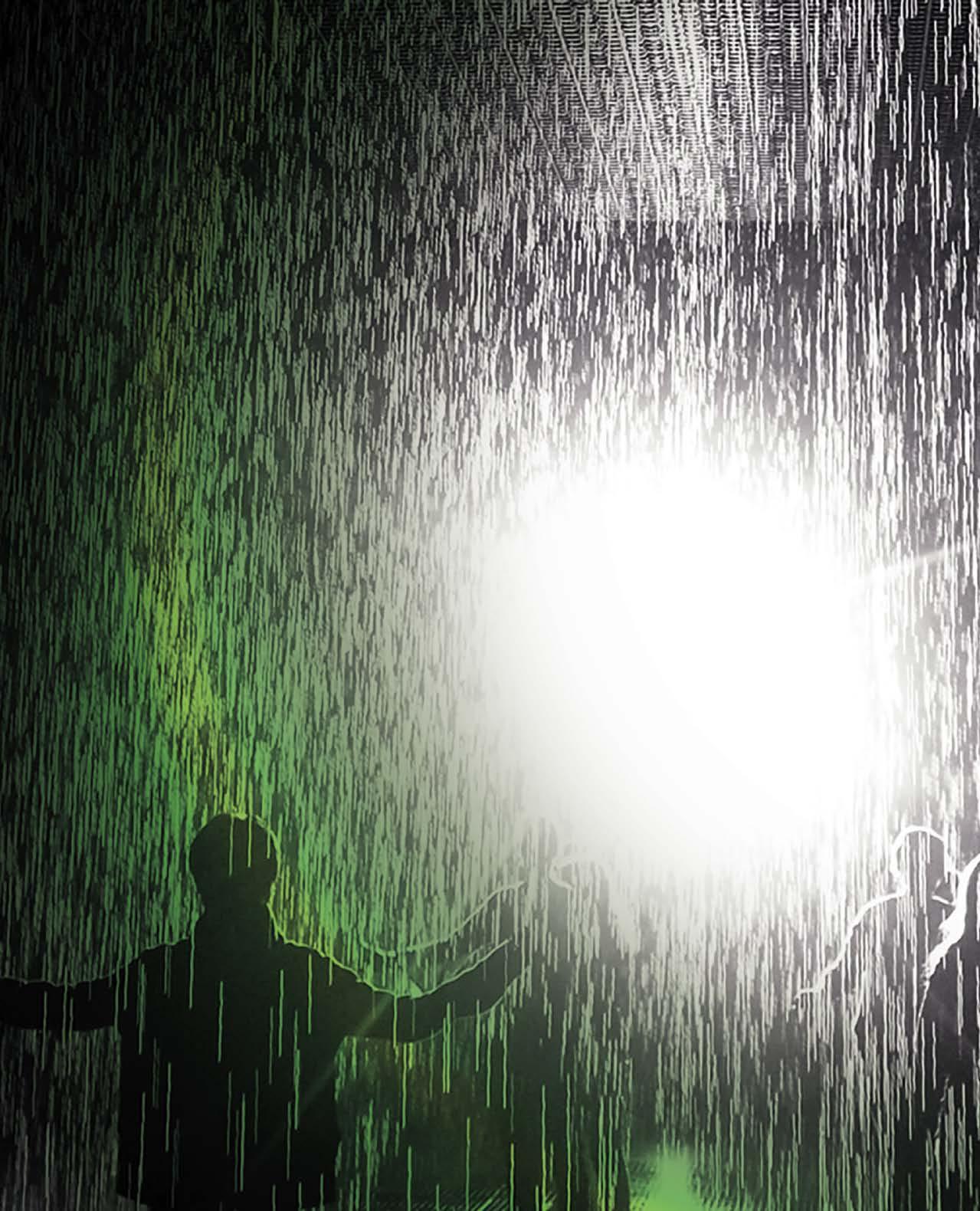
En-Scene and En-Space – the d&b Soundscape modules – are driven by the DS100 Signal Engine. This revolutionary audio system processor makes it possible to sculpt any space to suit precise acoustic specifications. The modules allow for object-based mixing and positioning of up to sixty-four sound objects in order to create authentic audio realities.
dbsoundscape.com

The GBI church family has been growing rapidly in line with the opening of new CK7 satellite sites in shopping malls. Richard Lawn tours one example in Pluit
THERE IS A PLAUSIBLE CORRELATION that an extraordinary growth in the Gereja Bethel Indonesian (GBI) church congregational numbers is linked to the siting of new CK7 satellites in shopping malls. Given the endless traffic problems associated with Jakarta, it is an efficient way in which to combine activities. Worship then shop on the same outing? It could be coincidental of course but, as the GBICK7 membership recently surpassed 28,000, with no signs of deceleration, stagnant shopping malls welcome the addition of the churches to their floor plans ensuring a ringing of cash registers after each Sunday service. Located to the north of the capital, GBI-CK7 recently discovered a large vacant lot in Pluit shopping mall which the ministry quickly decided to develop for its worshippers. A 3-month development plan to complete prior to Christmas 2017 was approved, ensuring the old office spaces had to be fully converted with militarystyle logistics. Long-term supplier PT Promedia Innovative Solutions (PIS) was called upon to design, supply and install a full turnkey audio system into the newly created 600-capacity sanctuary and adjacent children’s rooms that would enhance the charismatic services at the GBI-CK7 Pluit property.
Having fully converted the old retail space into GBI-CK7 Pluit, the building contractor also integrated acoustics, including perforated rock wool and gypsum, throughout the development. No stranger to the GBI fraternity, the Jakarta distributor and systems integrator laid the cabling in October 2017 in the full knowledge that the church had set a deadline for opening before Christmas. The main conduit runs overhead from the stage to the purpose-built rear control room in the L-shaped sanctuary.
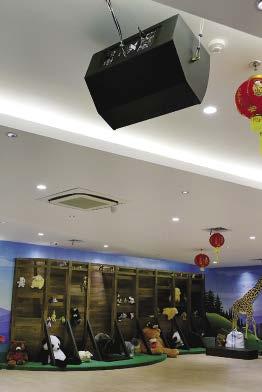
Measuring 28m in width and varying between 23m and 43m in length, the worshippers in the 4m-high sanctuary receive even audio coverage courtesy of L-R ceiling-suspended FBT Mitus 152A 15-inch powered speakers with dual floor-mounted d&b audiotechnik B2 subwoofers. ‘We made our predictions in EASE Focus, but six large rising columns together with the very low ceiling height ensured that we were limited to a point source design for which the cabinets needed to be orientated horizontally,’ explains PIS’ MD, Yosua Yan Heriyanto. ‘The 2-inch exit driver is coupled to a fairly narrow 60° x 40° rotatable horn, thus concentrating its energies on the congregation rather than the low ceiling.’


Four FBT Mitus 115A speakers serve as a row of first-tier delay speakers, while second- and third-tier delays have been suspended further along the narrow section of the sanctuary in the form of four FBT Mitus 112 models. Although onboard DSP is available in all the Mitus models with up to six presets, two DLM26 2-in/6out digital loudspeaker management processors provide the desired DSP settings for the problematic room. ‘We had to carefully configure the EQ, delay and filter settings with four tiers of delays,’ furthers Mr Heriyanto.
Having previously operated an analogue Allen & Heath GL2800 board at its old location for FOH and monitor mixing, the new digital dLive C2500 digital 48-channel control surface has saved valuable space in the rear control room. The dLive control surface is connected to a DM64 MixRack that has been integrated into an on-stage rack together with the DLM26 processors. ‘The church is familiar with the Allen & Heath iLive platform and so they wanted to operate a console that they were familiar and confident with,’ furthers Mr Heriyanto. The 20-fader C2500 is compact but features integrated audio I/O, an audio networking port, a 12-inch touchscreen and Harmony user interface for enhancing workflow. Harmony takes its design inspiration from smartphones and tablets and comes with bespoke widget areas that can be set up on the screen to keep track of scenes, meters, FX and custom controls.
An M-Dante card has been inserted into the MixRack providing digital audio networking options with 64 channels of bidirectional audio. This promotes multitrack recording for the musicians and singers to review their individual performances following a service and for recording special

shows. The video production team also benefit from the Dante multitrack recording capabilities offered when synchronising for video editing.
The charismatic services are heavily musical in nature. Stage left features an assemblage of musicians who prefer to be monitored on wedges rather than in-ear alternatives. Nine FBT Ventis 115MA and two RCF NX15 SMA self-powered speakers are used on the low-profile 23m x 5m stage. ‘They’re compact, sleek and provide powerful SPLs just where you want them with little spillage,’ adds Mr Heriyanto.
The drum kit is miked with a beyerdynamic TG drum set including four TG D35d (toms and snare), two TG I53c (overheads) and one TG D50d (bass drum), while the other musicians rely on Shure SM57 condensers. For the pastors and singers, a combination of Shure ULX-D with Beta SM58 handhelds and beyerdynamic TG 1000 digital
control room personnel individually or simultaneously on all channels.
Furthermore, live broadcasts to the adjoining rooms and mall itself, together with recordings of services, can be made on the SE-1200MU HD 6-channel video switcher, which marries video inputs with digital content. Operation is enabled on one of the four PCs together with the RMC260 control panel.
The lighting blends XC-200 moving heads at the front of the stage with Focus LED moving heads at the rear. Overhead Fresnels and PAR cans add varying hues and moods, all of which are mixed on an Avolites Tiger Touch II console.
Like most modern churches, GBI appeals to its children and youth by engaging them with interactive classrooms. Three classrooms draw various age groups in a corridor outside the main sanctuary. An array of professional equipment, including beyerdynamic TG 500

wireless microphones, Datavideo SE-650 switchers, 100-inch LED and 84-inch HD screens, Mackie ProFX22 mixers, blend in with the colourful customised furniture. In terms of loudspeakers and monitors, an assortment of FBT self-powered cabinets, including the X-Pro 12A
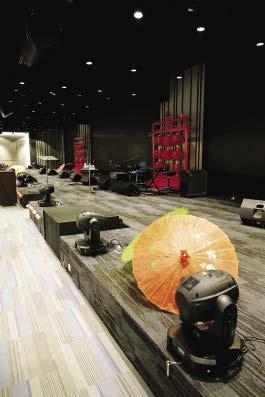
speakers and X-Lite 12A and X-Sub 18A subwoofers, provide more than ample SPL for the young attendees.
‘In addition, there is another church that practises above GBI-CK7 Pluit every Sunday,’ furthers Mr Heriyanto. ‘It was necessary to insert acoustic absorbers to minimise LF emissions. However, the site had been disused for a year and so air conditioning had not been working over that time and, as a result, the room was very humid and damp. We couldn’t use the adhesives for inserting the acoustic treatment, so the addition of dehumidifiers was essential for completing the project in time for Christmas. We then arranged a different Sunday order of service with the neighbouring church so there was no conflict. Ultimately, the pastor is comfortable and there are no vibrations or acoustic problems.’
www.gbiprj.org
www.promediasolution.com
The video production installed by V2 draws heavily on an array of Datavideo products, supplied by PT Harmoni Yogia Inti Sellars. An LED screen behind the stage provides the entire congregation with HD content. A 6-channel SE-2200 HD video controller lies at the core of operations. Prior to scaling the final picture quality it transmits to the LED screen, it receives dedicated feeds from the Datavideo fixed cameras and portable operated cameras, in addition to the content provided from two mobile Sony XDCAM cameras, four PCs, a Blu-ray player and Chromakey text overlay from an HDR-200 hard drivebased video recorder.
The two fixed and two portable cameras are controlled from the RMC-180 PTZ camera control unit, while an ITC-100 8-way talkback system allows the mobile A/V operators to communicate with the
SOUND
L-Acoustics systems are renowned for their uniform, full-range, natural sound. Our flexible, lightweight systems project crystal clear sound to your congregation, avoiding reverberant architecture. From the front row to the very back, your worshippers will never miss the message. Generous power ensures each congregant has the feeling of being in the heart of your music. Let our sound systems help you achieve maximum engagement for your house of worship. www.l-acoustics.com

ONE OF THE MOST POWERFUL tools any house of worship can have is the relationships it builds. Whether these are with parishioners, other HOWs or even technical suppliers, a strong relationship can often provide multiple advantages.
Of course, strong relationships take time to build. But if the experience of Woord en Lewe Church in Boksburg is anything to go by, it can be well worth the effort. What started as a technical upgrade almost 15 years ago has become a long-term partnership with Johannesburg-based distributor and systems integrator, Prosound, as its technical supplier. This relationship has seen the church newly install systems and temporary solutions for one-off events as well as receive full support whenever it needs it.
The story of Woord en Lewe and Prosound began with a lighting system upgrade for its main auditorium in 2005. ‘The lighting division of Prosound supplied and installed the initial stage lighting system for Woord en Lewe Church back in 2005,’ recalls Prosound’s Lee Thomson. ‘Originally the lighting rig mainly consisted of PAR can 64s, 1,000W and ETC Source 4 profiles. Chilli dimmers were installed to dim the original lighting installation.’
Following the success of this initial project, two years later the church decided to call the Prosound technical team back in as it was exploring options for a new audio solution. ‘They decided to demo numerous systems and settled on the Meyer Sound M2D line array,’ explains Mr Thomson. ‘This was always intended as a first phase
installation with the view of upgrading to other phases and adding more loudspeakers for better coverage and more sub-bass loudspeakers.’
After two successful projects, the relationship was cemented and the church regularly went back to Prosound for more updates as it gradually improved its systems.
‘Since 2005, Prosound has continually upgraded the original lighting solution,’ explains Mr Thomson. This included a largescale project in 2010 that saw the company tasked with installing a new lighting system in just three weeks.

The solution installed then was based around an ETC Ion console with a configuration of 1,024 output channels. One ETC 2x20 Fader Wing and LCD displays were added to alternate mood and lighting effects.
Two Unique Haze Machines provided various levels of haze for dramatic effect. Meanwhile, 84 channels of Zero 88 Chilli dimming adjust lighting intensity from mild to extreme.
This control element works in conjunction with ETC Source 4 PAR fixtures, fully rotational 575 AT Spots and Robe 575 AT Zoom Wash fixtures to provide focused or washed lighting anywhere on stage. ETC Source 4
profiles 36°, with dichroic reflector, provided bright but relatively cool light on stage.
The upgrade process for the lighting continued with smaller additions, such as additional ETC fixtures, ZPL LED PARs, moving spot and wash elements as well as trussing. The church also began to get the supplier involved in some of its one-off events.
One such example saw Prosound called in to support the church’s annual live DVD/CD recordings in 2013. For this event, lighting designer Chenn de Wet designed the lighting aspect of the show using PR Lighting fixtures. These included 10 XLED 1037 elements, 10 XLED 336 moving heads and 10 XR 200 beams, in addition to a range of other PR Lighting heads.
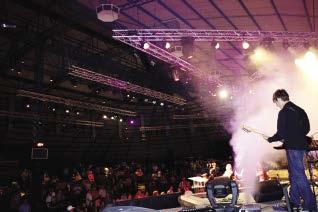
While lighting has dominated much of the upgrade process, there was still a portion of the audio system that needed to be extended. ‘In 2016, they decided to add 12 new Meyer Sound Leopard speakers and six 900-LFC cabinets with the new Galaxy processor,’ says Mr Thomson. ‘We managed to integrate the existing M2D solution in the new Leopard system. Although the tonality and overall performance from the two solutions were quite different, the overall system performance and coverage was excellent.’

As you would expect with such a longterm project, ensuring the equipment was kept up to date and in good working order has been a priority.
Following eight years of use, at one of the church’s regular meetings with the supplier, Dewaldt Visagie, who is Woord en Lewe’s technical and IT manager, advised that he wanted
to send the ETC Ion console to Prosound’s technical department for a general service. While this would provide advantages for the church in the long term, it would also leave it without any lighting control for its multiple weekly services. However, Prosound agreed to supply an ETC Eos Ti desk for temporary use at the church.
Mac Makhobotloane, lighting technical support for Prosound, delivered and installed the desk at the end of January 2018 before providing full training on the new console. All show files and Watch Out software were successfully transferred and Pheelo, the technical lighting console operator for Woord en Lewe, was up and running on the Eos Ti after 90 minutes of training.
This kind of long-term installation will be a common story for many houses of worship, as new equipment can only be purchased when funds are made available. However, building a strong relationship with a supplier means that the best results can still be achieved no matter how long the overall project takes. www.prosound.co.za
Upgrades to the technical systems at HOWs are rarely done in a single phase, but picking the right partner means that they can be done over time. James Ling reportsThe ETC Ion lighting desk The worship band on stage in 2010
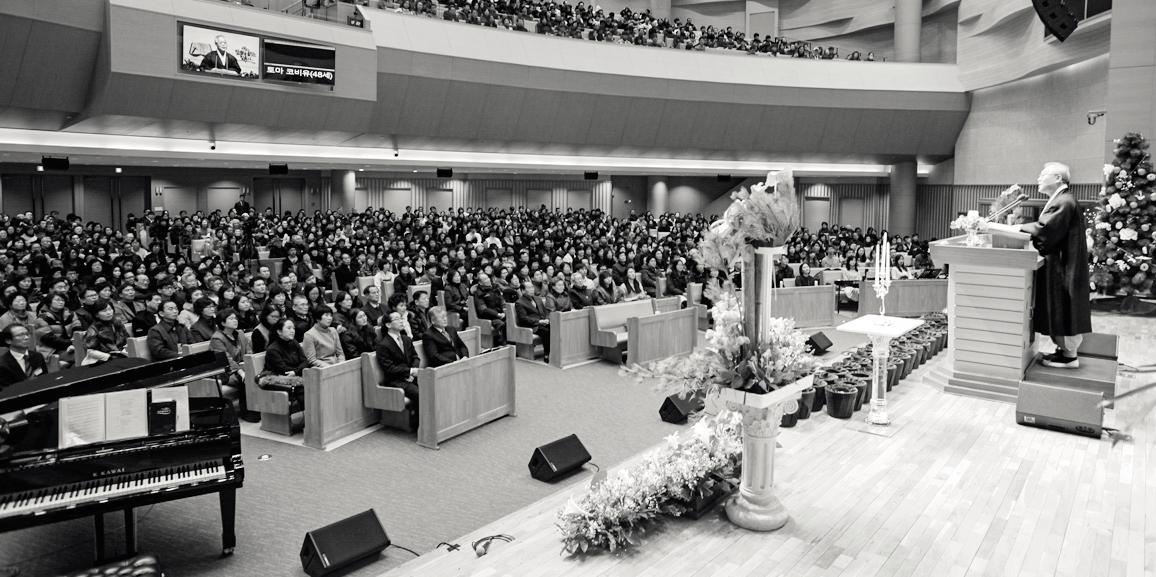






SINCE HOLDING ITS FIRST CHURCH service in 1986, Bethesda BedokTampines Church (BBTC) has increased its services and welcomed a growing congregation by adding Hokkien, Mandarin, Filipino and Indonesian services. 2007 was notable for the completion of both a new building extension and installation of a loudspeaker audio system into the third-floor sanctuary. Ten years on, despite the walls and construction of the extension showing no cracks, the line array loudspeakers were not only showing audible signs of fatigue but they were also affecting the sight lines to the three large projected images on the stage wall. The loudspeaker system is put to very good use by hosting three main services each weekend. Live music is provided by church musicians comprising keyboardists, a drummer, acoustic and electrical guitarists and a bass player, while the pastor, an onstage choir, worship singers and the worship leader lead the congregation in high-energy praise and worship.
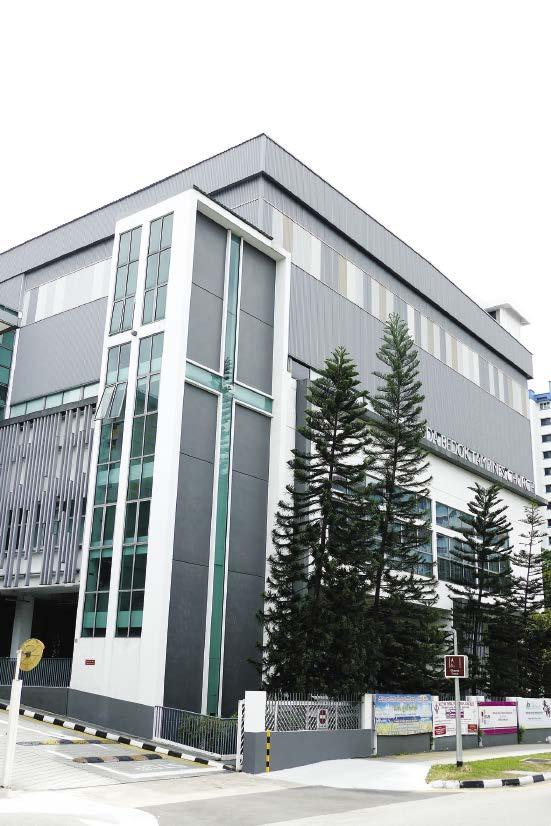
The church leaders agreed that the loudspeaker system needed replacing and, as such, several leading systems integrators were invited to demonstrate their loudspeaker systems in a shootout. ‘It proved to be a difficult decision,’ declares A/V consultant Robert Soo from Cogent Acoustics but, ultimately, the church committee selected a system proposed by Electronics & Engineering Pte Ltd (E&E). ‘The EAW QX point source, complemented with the EAW SB subs, has an edge over the others in sound quality, projection and even dispersion. The smaller delays also complemented and matched well with the mains.’
The hall’s harsh acoustics, where an RT60 analysis revealed a reverberation time of 2.5s, greatly affected the overall listening experience, especially with BBTC’s contemporary music style. Acoustic treatment designed by Mr Soo and provided by Insul-Dek Engineering Pte Ltd followed, with the addition of absorbers on the balcony, stage

BBTC’s harsh acoustics have led to an overhaul of the church’s loudspeaker and visual systems, reports Richard LawnThe projection screen receives its image from three Panasonic PT-DW17K projectors via a Matrox TripleHead2Go system BBTC was established over 30 years ago in Bedok
areas and interspersed above the 2m-high wooden panels on the lateral walls. Absorbers were also installed in the ceiling sections above the main loudspeakers to reduce reflections that interfere with the sound. BBTC’s in-house design department ensured the required aesthetics and creatively decorated the wall panels with scripture passages. These extensive works revised the RT60 to below 1.4s, providing a much more intelligible and musical sound experience for the congregation.
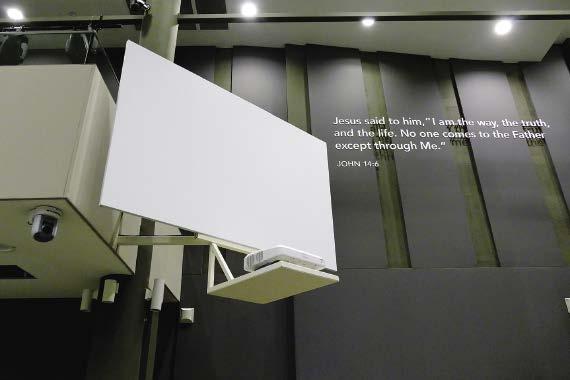
‘It’s an overcrowded ceiling as there are multiple lights and smoke detectors in addition to A/C ducting,’ confirms Mr Soo. ‘In addition, there were no updated architectural drawings, so locating points to hang the resultant FOH speaker system was a great challenge. Ultimately, we relied upon laser measurements and had to shift some existing stage lights. Once allowed on site, the timeframe to complete was only two months, providing E&E with quite a challenge, especially when installing the FOH mounting structure as the ceiling is 10m high.’
The main FOH loudspeaker system installed by E&E features six EAW QX566i 3-way trapezoidal loudspeakers each comprising four phase-aligned 12-inch woofers providing 60° x 60° coverage. Four of these are directed for medium throw towards the front seating area

and two towards the gallery seating above. To reduce the effects of comb filtering, a central cluster of four EAW SB dual 18-inch subwoofers provides optimum LF dispersion, even into the deep recesses of the gallery sections. Operating in a pseudo array mode, the configuration worked very well in reducing low frequencies both behind and below the central stage.
The loudspeaker cabinets are powered by a combination of Powersoft’s Duecanali and M Series amplifiers. The 24 lower-frequency 12-inch woofers integrated into the six QX566i cabinets are powered by six Powersoft M20D 4-channel amplifiers and three M14D amplifiers provide sufficient headroom for the high-frequency compression drivers.
Two Duecanali 3904 amplifiers provide power to the subwoofers of the 4-way system. Loudspeaker management has been divided between the FOH system being controlled by two EAW UX8800 units and a Symetrix SymNet Radius 12x8 EX enhanced by an xOut 12 expander for the fills. Located to the rear of the stage right area, the enclosed control room equipment racks also house five Furman CN-3600S E power sequencers that are remotely triggered from the A/V booth for ease of powering on/off.

Owing to the existence of an upper gallery area, rising pillars and scale of the third-floor sanctuary, loudspeaker
fills were required to ensure even coverage to all the seats. Powered by Powersoft M14D and Quattrocanali 1204 amplifiers, six EAW MK8196 compact speakers serve as frontfills sat on the lip of the stage. The gallery seats are covered by four MK5396 speakers together with a secondary delay comprising a further four JF10 cabinets. Directly below the gallery, four JF10s deliver first line delay below the 27m wide x 14m deep space, while a final delay consisting of four MK8196 models ensures the rear seats are catered for. A combination of one 4804 and three 2404 Quattrocanali amplifiers power the EAW delay speakers above and below the balcony.
In addition to the audio upgrade, E&E also refreshed some aspects of BBTC’s visual inventory, including a new Sony PTZ camera system. ‘The previous PTZ system has been retained as it is working well, but it is now used as a monitor for operational cues,’ explains Mr Soo. Controlled by an RM-IP10, one BRC-H800 and two SRG-300SE PTZ models serve as inputs to a Datavideo SE-2850 video switcher – together with a Blu-ray player and Mac visual displays – for output to the main three Panasonic PT-DW17K projectors via a Matrox TripleHead2Go system. An Atomos Ninja Inferno video recorder has also been added for the church’s requirements. A Kramer VS-1616DN 16x16 matrix switcher provides full video signal distribution to all levels of the church, for which full A/V control can be enabled from a Crestron TSW-760 touchscreen connected to an AV3 processor.
The worship team, including the pastor, requires a visual monitor from which to freely minister from the stage. Now, the team can view content via two Epson EB-1460Ui ultra short throw projectors that beam video onto Remaco FIX-2516C
projection screens. E&E created bespoke projector frames in its metal shop, which are attached to the left and right sections of the balcony lip. ‘I’m very impressed with these new Epson projectors,’ adds Mr Soo. ‘Ultra short throw projectors are usually limited to a 100-inch image, but we managed to push the EB-1460Ui to provide a 20% larger image than what it was designed for and it worked very well even in a brightly lit hall, and with very low distortion.’
Some aspects of the lighting design were also renewed, including three per side SilverStar Cyan 800XS and Eclipse 750 HD fixtures. A Jands Vista S1 remains as the main lighting control console. Eight channels of Shure QLXD4 wireless have been added for the church’s wireless requirements, which are configured using the Workbench 6 software control app. In addition to wedge monitors, the musicians benefit from a pre-existing 10 units of personal monitor mixers.
BBTC remains a work in progress, fitting its ongoing upgrades around hectic weekly schedules. Timing is everything as exemplified by the Shure wireless system awaiting a rack and the faithful Midas Verona 400 FOH console that has also been earmarked for renewal. Soon, LED lighting strips will grace the stage and a new digital console will better support the audio production services. An expectant audience of long-serving congregants will return again and again knowing full well that the church continues to improve its worship experience.
www.bbtc.com.sg
www.cogentacoustics.com
www.enepl.com.sg

CROSS THE LINE, A NONdenominational church in Lincoln, Nebraska completed the final stages of construction on its facility in 2017, allowing it to better serve its congregation of 350 and fulfil its commitment to community outreach and involvement. The church campus includes a gymnasium, a coffee shop and a child development centre providing day care, pre-school and summer programmes – all open to the public.

Audio, video and electrical engineers Chris Korver and Timothy Kechely were contracted to implement the A/V solutions for the new facility – solutions that cover an array of purposes. As well as hosting Cross the Line’s worship services, shares Mr Korver, ‘the main sanctuary can also be used as a basketball court, concert venue or rental hall. They can also have live music in the coffee house area. The sanctuary had a complete-from-the-ground install. The coffee area had a more modest rebuild of the sound system and video screens.’
The remodelled and expanded Cross the Line sanctuary is 30m wide x 24m deep with a ceiling height of 8m at the rear that tapers towards the recessed centre stage. The seating capacity is 600. Floors are wood, walls are surfaced in drywall and the steel beam-supported ceiling uses painted Tectum panels for sound absorption.
Cross the Line’s contemporary worship services feature a full band with drums, two electric guitars and bass, acoustic guitar, one or two keyboards and up to eight vocalists. System control is managed from a back-of-sanctuary AVL booth. A Midas M32 digital console with a DL32 stagebox was chosen for audio
mixing, says Mr Korver, for ‘quality versus price point, ease of set up and operation, app support for tablets and smartphones and overall flexibility and routing’. The learning curve for the new system centred on the new capabilities the console offered. ‘They went from a small format analogue console into full-out digital realm in just one week – sort of like driving a minivan and jumping into a Ferrari!’
The mic complement is Audix anchored, including a number of wired mics and three Audix wireless systems (combined through an Audix antenna distribution system) used for the pastor and lead vocalists. ‘I have always been really happy with the outcome using Audix microphones in most environments,’ says Mr Korver.
The loudspeaker array at Cross the Line uses active components from ISP Technologies Pro Audio. Flown left and right are five ISP HDL 3112 3-way small format line array cabinets with a pair of HDL1118 ISP subs flown next to the arrays towards the centre. A pair of ISP HDM212 3-way point source cabinets flown next to the arrays provide side-fill coverage, while three
of ISP’s XMAX 218 subs are housed beneath the stage. Four additional HDM212s are used as stage monitors, with a different mix on each. System processing is provided by a Klark Teknik DM8000 unit. The use of ISP High Definition series loudspeakers was specified by Cross the Line. ‘We had never worked with ISP speakers before,’ says Mr Korver. ‘To date, I have heard a number of array systems that have not impressed me at all. It seems like many of the more affordable systems lack fidelity in

the mid-range and also tend to fall apart at higher SPLs in rooms of this size.’ Bringing the ISP arrays online, he admits to being impressed. ‘The mid-range was right in the pocket untuned. With a bit of minor tweaking on the crossover and EQ points to allow for the room, the ISP system proved itself.’ Mr Korver confesses that when he pushed the system, he reached 118dBA SPL. ‘The system was holding together! I still had plenty of headroom and definition. This system had all the character of a system costing twice the price. From the box to the flying bar, this is one of the easiest systems I have ever worked with.’
Video playback in the Cross the Line sanctuary uses centre-front projection on a drop-down screen, with a custom-built LED display both to the left and right of the stage. A centre-rear projected display provides confidence monitoring. Cameras from PTZOptics, under IP control, capture images for IMAG use, while a custom-built PC with an on-board IP video card routes signals to the displays via Studio Coast’s Vmix vision mixing software.
A mix of moving and fixed LED lighting fixtures are DMX controlled, as with video, through a custom computer. The systems even monitor electrical power and current within the transformer isolated electrical install. Lighting use at Cross the Line, says Mr Korver, is ‘very subtle, but elegant’.
The highly customised systems at Cross the Line have not only enhanced worship, but are helping enable its community outreach and service missions.


www.crossthelinechurch.com
www.ispproaudio.com

At Cross the Line Church, AVL system flexibility accommodates a host of ministries. Frank Wells learns moreThe sanctuary doubles as a gymnasium Cross the Line Church’s new sanctuary during construction Worship at Cross the Line Church The right side hang of ISP loudspeakers Sharing the word


Challenge: Miking a choir with condensers seems expensive.
Challenge: Miking a choir with condensers seems expensive.
SOLUTION : Audix Micros
SOLUTION : Audix Micros


These a ordable microphones are unique because they feature a fully integrated circuit (including pre amp) all in a two-inch long body, making it the most powerful miniature microphone on the market. They pack a punch only one microphone is needed to cover up to 20 singers.
These a ordable microphones are unique because they feature a fully integrated circuit (including pre amp) all in a two-inch long body, making it the most powerful miniature microphone on the market. They pack a punch only one microphone is needed to cover up to 20 singers.
Challenge: Choir placement and size varies from week to week.
Challenge: Choir placement and size varies from week to week.

SOLUTION : Audix MicroBoom
SOLUTION : Audix MicroBoom
Today’s worship environments accommodate an array of congregations and configurations. Where the choir is one week may be where the band is the next. In some cases, the size of a choir may go from 20 people to a holiday production of 80. The MicroBoom system is portable, easy to move, and easy to store. Plus, it is available in black or white finish discreet in appearance, virtually becoming invisible within the sight lines.
Today’s worship environments accommodate an array of congregations and configurations. Where the choir is one week may be where the band is the next. In some cases, the size of a choir may go from 20 people to a holiday production of 80. The MicroBoom system is portable, easy to move, and easy to store. Plus, it is available in black or white finish discreet in appearance, virtually becoming invisible within the sight lines.
, making it uniquely

Challenge: Hanging microphones from the ceiling is a huge hassle. How do you get microphones high enough to cover all the singers in the choir?
Challenge: Hanging microphones from the ceiling is a huge hassle. How do you get microphones high enough to cover all the singers in the choir?
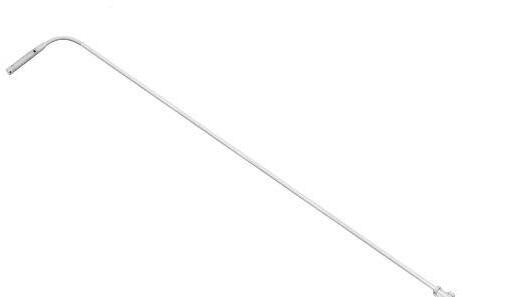
SOLUTION : Audix MICROBOOM50 or MICROBOOM84
SOLUTION : Audix MICROBOOM50 or MICROBOOM84
For complete coverage of a choir, the microphones are positioned 2 feet in front of the first row of singers, extending 2 feet higher than the tallest person in the back row. With a standard three row choir riser of 2 feet, the mic will typically need to be 10 feet in the air. The MICROBOOM50 (50" carbon fiber boom) attached to a standard mic stand will extend to over 10 feet. The MICROBOOM84 (84" carbon fiber boom) attached to a standard mic stand will extend to over 11 feet and will cover up to four rows of choir. Unlike hanging microphones, the clutch assembly and integrated gooseneck mount grants precise fine-tuning of the microphone positions.
For complete coverage of a choir, the microphones are positioned 2 feet in front of the first row of singers, extending 2 feet higher than the tallest person in the back row. With a standard three row choir riser of 2 feet, the mic will typically need to be 10 feet in the air. The MICROBOOM50 (50" carbon fiber boom) attached to a standard mic stand will extend to over 10 feet. The MICROBOOM84 (84" carbon fiber boom) attached to a standard mic stand will extend to over 11 feet and will cover up to four rows of choir. Unlike hanging microphones, the clutch assembly and integrated gooseneck mount grants precise fine-tuning of the microphone positions.




Challenge: The choir is positioned near loud band instruments(s) such as a drum set and/or lead guitar amp, and they are bleeding into the choir mix.
Challenge: The choir is positioned near loud band instruments(s) such as a drum set and/or lead guitar amp, and they are bleeding into the choir mix.
SOLUTION : Audix MicroBoom with a hypercardiod capsule
SOLUTION : Audix MicroBoom with a hypercardiod capsule
Dramatically improve isolation and increase gain by using a tighter pattern, positioning the microphones a little closer to the choir, and bringing the singers closer together. The Audix Micros™ Series can be ordered with cardioid, hypercardioid, and supercardioid patterns.
Dramatically improve isolation and increase gain by using a tighter pattern, positioning the microphones a little closer to the choir, and bringing the singers closer together. The Audix Micros™ Series can be ordered with cardioid, hypercardioid, and supercardioid patterns.
ORIGINALLY INCEPTED 30 YEARS ago, a mission assembly of the Gereja Kristus Yesus (GKY) church decided to locate itself in Puri Indah to the west of Jakarta. Resembling a castle, the GKY was strategically placed in a rapidly growing neighbourhood that has served its new constituents well since 1988.


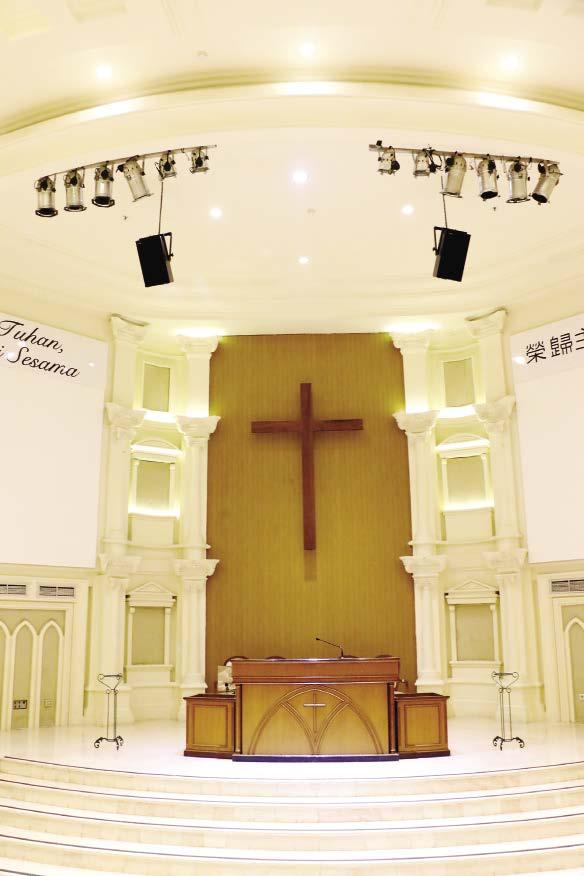
The Presbyterian services are largely non-charismatic in style, relying on the spoken word from a pulpit outfitted with gooseneck microphones
and a piano accompaniment. However, the reverberant acoustics of this man-made fortress of the Lord, whose sanctuary ceiling height is 9m, was singled out as problematic in 2017. As such, several audio suppliers were called upon to tender a solution that would enhance the speech intelligibility. Following a loudspeaker demonstration, PT Hesed Kharis Indonesia was enlisted to supply and install a relatively simple but effective design.
Not only did the church require an audio upgrade that would enhance speech intelligibility, the church committee stipulated that any new speaker system could not distract the attention of their worshippers. ‘Pastor Musa Saloma desired an audio system that would provide even SPLs throughout the seated areas, but would not distract the worshipper’s eye,’ explains PT Hesed Kharis Indonesia’s MD, Dene Dave. ‘In addition, it was made clear that nothing could be added on stage that would interfere with sight lines – so no monitors or front-fills. Therefore, we promoted a ceiling suspended loudspeaker system.’ Having conducted simulations of the fan-shaped room in EASE, Mr Dene conducted acoustic analysis, where he found the RT60 measured 2.6s. ‘The balcony area was the most problematic of all as the seating area rises towards the rear, so the gap tapers from 4.5m at the lip to 2m at the rear wall, where a fabric finish absorber has been added.’
The church is relatively modern and architectural drawings were available allowing an assessment as to where loudspeakers could be fixed safely
on the ceiling. Loudspeaker cabling and trunking was inserted into the ceiling and rising walls, before being routed to the loudspeaker points. TW Audio M8 and M12 speakers were then fixed to the ceiling using a chain on a scaffold tower to hoist them into position. ‘The M8 and M12 passive cabinets only weigh 10kg and 20kg, respectively, so it wasn’t strenuous. The cable lengths from the speaker points to the control room were minimised and did not exceed 30m, ensuring the signal strength remains high.’
Whilst the main system consists of two TW Audio M12 speakers suspended in an L-R configuration from the 9m ceiling, four delayed M8 speakers are suspended in front for balcony area coverage. Following full configuration, the RT60 reading for the balcony is now below 2s. ‘In
Gereja Kristus Yesus called on PT Hesed Kharis Indonesia to supply a simple but effective solution to its reverberant acoustic problems, reports Richard LawnThe M12 speakers suspended from the ceiling GKY church in Puri Indah resembles a castle
terms of coverage, the 12-inch M12 is ideal as its low to mid frequencies are focused on the seats with its rotatable 75° x 50° high-frequency horn,’ furthers Mr Dene. ‘In addition, the levels and EQ settings set for the M8 models covering the balcony ensure there is no splash back from the rear wall.’
A Lab.gruppen PLM 12K44 4-channel amplifier was deemed sufficient to provide enough power for the two M12 and four M8 speakers in addition to a B15 subwoofer with a passive crossover below stage. ‘The B12 speakers operate down to 60Hz, but the
church desired a mild low-frequency extension. A church of this nature really doesn’t require a subwoofer, but we equalised this through the low shelf filter at exactly 6dB at 100Hz to give them the desired
bass. The amplifier is also equipped with Dolby Lake processing, so this allowed me to add the delays, EQs, filters and more.’
PT Hesed Kharis Indonesia also supplied a Cadac CDC four console for simple mixing. An I/O rack was not required and a snake runs from the CDC four to the Lab.gruppen amplifier. ‘The addition of the CDC four also helps intelligibility owing to the high-quality onboard preamps and a 96kHz sample clock rate. Twelve out of 16 mono channels are utilised in the current setup.’ In addition, a live multitrack recording function with a Waves Trackline and Studiomaster H8 headphones was added to the upgrade for the church’s evolving requirements.

‘Pastor Musa Saloma is satisfied with the result as it has noticeably enhanced speech intelligibility,’ adds Mr Dene. ‘Although the compact loudspeaker system is out of sight during the services up in the ceiling, we were somewhat mystified as to why the church desired the M8 and M12 cabinets finished in black as white is available.’ Perhaps GKY is proud to exhibit the newly installed audio system.


www.gkypin.org
www.hesedindonesia.com
A system built around Dante™ enabled Duecanali and Quattrocanali Series amplifier platforms meets and exceeds all requirements in terms of flexibility, controllability, and scalability. Any mixed output configuration is possible, allowing for multi-zone sound distribution, with the channel routing function in Armonía granting total control over each signal.
WITH 2-CHANNEL AND 4-CHANNEL AMPLIFIER PLATFORMS.
frequently plagued by acoustic challenges. This is often due to the aesthetics of the buildings in question. Churches, for example, regularly feature large, hard surfaces coupled with an array of obstacles, including pillars and balconies. Yet, services require optimal intelligibility to ensure the congregation can understand the worship leader’s message, while music also plays a key part in the experience and needs to be reinforced to the best possible quality.
It was with this in mind that the Church of the Saviour UMC (United Methodist Church) in Cincinnati, Ohio recently decided to explore its options for audio, as well as lighting, engaging with systems integration firm SystemMax AVL for a needs assessment. Working with other contractors in the local area, SystemMax AVL specified a new audio installation and the introduction of new theatrical lighting to brighten up the church’s services. As a result, Church of
the Saviour UMC has adjusted its service offerings.


‘We ended up redesigning and installing the audio system for the worship space, which is now doing split services with contemporary Christian worship and electric bands as well as traditional services with organ and choir,’ says Darryl
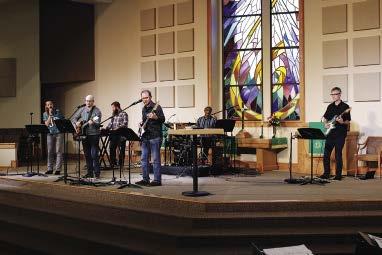
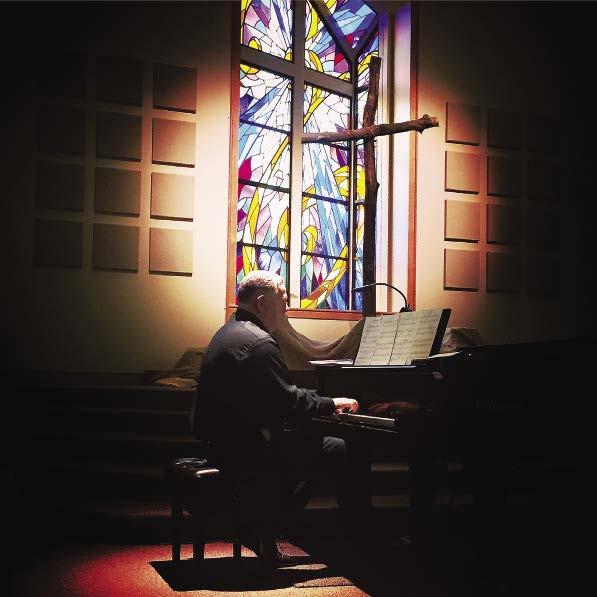
Johnson, co-owner of SystemMax AVL. As the SystemMax AVL team examined the sanctuary, it soon became clear that a new set of loudspeakers was not going to solve the room’s acoustic problems. ‘Church of the Saviour is in a modern structure built in the late 1980s and early 1990s. The
worship area had a lot of drywall and 60% of the back wall is glass with a large stained-glass window in the front wall behind the platform, all of which created a 4s or 5s delay,’ explains SystemMax AVL co-owner, Max Maxwell. ‘The glass is particularly challenging because there isn’t a way to treat that.’
‘The room had severe acoustic anomalies so we brought in an acoustic consultant, Haverstick Designs from Indianapolis, to do room measurements and recommend treatment for the space to bring it within viable parameters,’ says Mr Johnson.
For Joe Galyon, director of worship and arts at Church of the Saviour, the results of the acoustic measurements proved surprising. ‘We believed that the glass wall at the rear of the sanctuary was the cause of the issues,’ he recalls. ‘The consultant from Haverstick Designs came in and spent a day with us, digitally mapping the acoustics of the room and performing subjective listening tests in six different parts of the church. He had the subjects
Church of the Saviour UMC found that it required more than just a new set of speakers to solve its acoustic issues. James Cooke reportsThe new theatrical lighting rig emphasises the action on stage Church of the Saviour UMC offers contemporary and traditional worship services The church also serves as a venue for concerts and guest speakers










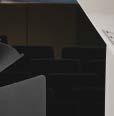
listen to words read aloud for clarity while sitting in various positions in the room. The acoustic map of the room he presented us was covered in lines and identified that the problems were actually caused by the walls nearer the front of the sanctuary.’
‘Based on the consultant’s recommendation, we put in ProSoCoustic 2-inch wall panels in different lengths and sizes on the side walls specifically sized to the areas where they were being used,’ says Mr Maxwell. ‘With the treatments, we were able to get the decay time down to less than 2s. Even though Darryl and I are musicians, the main thing we’re focused on is clarity and articulation for the sermons, which is critically important. If the pastor speaks and no one understands what she’s saying, we’ve pretty much missed the boat.’
‘And then we installed a Martin Audio CDD/CSX speaker system with Elation Professional lighting,’ Mr Johnson adds.
The Martin Audio setup is formed from CDD12 and CDD8 loudspeakers with CSX212 subwoofers. ‘The way the structure is built there was no place to ground stack the subs or build them into the stage so we flew two left and right with one of the CDD12s in the centre section of the room that has a higher ceiling,’ says Mr Johnson. ‘Then we flew a CDD12 on the outside right and left of the room which has a lower ceiling. In the rear of the church, there’s a delay ring of three CDD8s across the upper and lower portions of the ceiling. Luckily, the space is wide enough to rig all the speakers across the church.’
For Mr Maxwell, the goal of achieving clarity and articulation for the sermons has been accomplished by the CDD speakers. ‘We felt that because of the CDD’s pattern control,
wide dispersion and the way the high-frequency drivers function, it was the most appropriate choice for the install and it turned out great,’ he says. ‘Speech intelligibility with the CDDs is amazing. And when you factor in the CSX subs, music reproduction is everything we could have hoped for. Our client is ecstatic with the system.’
At the start of the signal chain, SystemMax AVL paired Earthworks choir microphones with the Martin Audio speakers. ‘We used a matched pair of Earthworks choir microphones and the CDD speakers clearly reproduced all the clarity and quality those mics offer,’ says Mr Maxwell.
‘It sounds phenomenal. The church uses a Roland electronic drum kit and all the drums are perfectly reproduced through the system with significant bass response.’
Through the combination of the new Martin Audio sound system, paired with the right microphones, and acoustic treatment, the church’s acoustic issues are a thing of the
lighting rig is adding new flavour to services and engaging with congregants visually.
‘The project was three-pronged,’ states Dr Galyon. ‘Sound was the main driver as we needed to rectify the bad acoustics. However, we had been relying on a portable lighting rig with some PAR cans dangling from a light tree. Therefore, when we approached SystemMax AVL, we decided to upgrade our lighting rig while rectifying our sound problems. We were looking for theatre-style feature lighting to add emphasis to the action on the stage.’
Forming the foundation of the new lighting setup are 10 Colour 5 Profile ellipsoidal fixtures, which each feature a 180W RGBAM (red, green, blue, amber, mint) LED engine to add a splash of colour to Church of the Saviour’s services. Six of these have been equipped with the lighting manufacturer’s PHDL19 19° HD lens, while the remaining four are fitted with the PHDL26 26° version.
Joining the Colour 5 Profiles are six Fuze Wash Z120 single source PAR moving head luminaires with a 120W Quad Color RGBW (red, green, blue, white) COB LED, 7° to 55° motorised zoom, pan and tilt, as well as RGBW colour mixing functionality. SystemMax AVL also installed a pair of Fuze Wash Z350s, which include a 350W quad-colour RGBW COB LED with 6° to 46° motorised zoom, pan and tilt ability.
As for programming and controlling the lighting rig, a Leprecon LPC-24S Lil’ Wing control surface serves as the main lighting console and is accompanied by an APC (Architectural Panel Control) Hub DMX system controller, an APC-12 12-button controller and an APC-3 3-button wall controller. An Elation wireless
DMX transmitter EWDMXT feeds five EWDMXR wireless DMX receivers and DMX signals are combined into a single source using an ELC Lighting DT221 desktop-mounted DMX merger.
Both traditional and contemporary services at Church of the Saviour UMC now feature their own unique looks thanks to the new lighting rigs. The church also plays host to a variety of concerts and public speaking events, which make use of not only the lighting setup, but also the improved sound system.

‘We knew when we went into this that it was going to take more than simply a new audio system to improve the sound quality,’ says Dr Galyon. ‘If we didn’t improve the acoustics, we could have had the best sound system and it still would have sounded bad. With the acoustic treatment coupled with the new systems, it sounds so good that I’m no longer having to yell through my own echo. We were also losing some of the older members of our congregation who were struggling to hear the services before the installation and now they’ve started coming back. In addition, those who were using our listening assistance system previously no longer need it as they can all hear clearly.’
‘The install has been a major success and we’ve got other jobs because of how great the services sound,’ notes Mr Maxwell.
Dr Galyon agrees with Mr Maxwell, commenting on the work of the systems integration firm. ‘SystemMax AVL was very easy to work with,’ the worship and arts director notes. ‘They listened to what we do here and what we thought we needed and then, after careful consideration, informed us of what we actually required. Our chair of trustees, David Sass, served as the project manager for this and he worked with them on an understanding that if the sound and lighting systems didn’t fully meet our needs, then they would have to carry on working. They met all of our needs and beyond.
‘We have also developed a training curriculum to teach our volunteers how to use the new systems,’ Dr Galyon concludes. ‘The SystemMax AVL team not only trained us in how to use all of the equipment ourselves, but also how to train others going forward.’
The future looks bright, and sounds great, for Church of the Saviour.

www.cos-umc.org
www.elationlighting.com
www.martin-audio.com
www.systemmaxavl.com
incredibly thin line array microphones
Wide horizontal cardioid polar pattern and narrow vertical polar pattern
Discreet, invisible, elegant with matte brass finish Horizontal and vertical setup

www.k-array.com
Designing unique audio solutions never dreamed of before.

SO YOU’RE A VOLUNTEER LIGHTING technician and you bring up the faders to a predetermined point, or press the ‘go’ button to recall a cue, and the lights come up. The level of light to your eyes looks good and a good visual image of the stage is what you’re looking for. Job done, right? In houses of worship where the naked eye is the only ‘eye’ in the room, that may be true. However, there are fewer and fewer services anymore where the only audience is those sitting in the auditorium.

In today’s world of video live streaming, on-demand viewing of archived services, image magnification (IMAG) systems and multi-venue broadcasting, the eye of a camera – or many cameras


– has become a very prominent viewer in many houses of worship. As camera sensors are much more sensitive to light than the human eye, the task of lighting a service appropriately for ‘screen audiences’ has become very important. This has added to the complexity of the lighting designer or technician’s role as he or she must now consider lighting from the perspective of multiple audiences.
This article is going to take a look at a specific tool – the light meter – that lighting technicians and designers can utilise to ensure that the screen audience receives as good an experience as those in the auditorium. If you’ve never seen or used a light meter, or don’t know how or what it is used for, hopefully
Analog Way heavy-duty Media Servers support your massive installations and events from a single server unit
you’ll finish this article with more knowledge than when you started.
If your lighting experience has been working in situations where you are only dealing with the eyes of those in the auditorium, chances are you have not come across a light meter before or have very little experience with one. If you’re a photographer or videographer, however, chances are much higher that a light meter is a tool you are experienced with and knowledgeable about.

A light meter is a tool used to help you plan and understand the lighting of a scene as it will be captured by a camera. Camera sensors are much more sensitive to light and shadow than the human eye, so using a light meter can help you make sure that your camera settings and light levels are optimum for capturing a balanced, quality picture. The light meter measures the intensity of light and also provides exposure information without needing to have your camera with you.
There are two types of light meters differentiated by two methods used for taking a light reading. An incident meter measures the light that falls onto a subject, while a spot


(or reflection) meter measures the light reflected from a subject. You can purchase either type of meter, as well as some models that will take incident and spot metering measurements.

Both types of measurements are helpful; though when lighting a stage, you will most likely use an incident

when considering how different areas within the same frame will appear.
As a lighting technician or designer for a house of worship, it may be that you aren’t directly involved in the video or photo elements of your services. You may not need to know or understand the exposure

information provided by a light meter, but the measurements of light intensity – typically measured in foot-candles, though more commonly in lux – is important to understand as you are in charge of lighting the subject(s) of the video crew.
Perhaps the most important reason to use a light meter is to be able to understand and correct inconsistent levels of brightness across the area(s) that a subject may be shot on camera. Remember that a camera sensor is more sensitive to light than the human eye. Small areas with increased brightness may appear as overexposed areas in a shot and therefore lack detail. Small shadow areas may appear underexposed in a shot, as if an object is placed directly between the camera and subject being shot.
The goal is to create an even wash of light across the stage. You can walk your stage with an incident light meter and find areas that are under-lit or over-lit. From there you then can refocus your fixtures to create a more even wash of light. On a side note, it is better to correctly position and focus your fixtures than to balance the lighting through adjusting the fixture intensities – especially when working with conventional fixtures. The reason for this is that as you
lower the intensity of an incandescent lamp, the colour temperature of the light changes. This introduces additional problems for the video crew.

As you’re using your meter to check for even washes of light, be sure to meter all of the areas that may be shot on camera. If your video crew often uses audience shots, meter the auditorium and make sure that the light is balanced for clear, detailed audience images. To ensure correct exposure, this means that the audience area should be of similar brightness to the stage brightness. Also meter any set areas to ensure that they are visible behind subjects instead of being too dim and therefore appearing in the camera shot as underexposed, dark areas.
To use a light meter correctly, make sure that you know what type of meter you have. As mentioned above, you may have an incident meter, a spot meter or a meter that is able to take both measurements. In most circumstances where you are looking to evenly light a large area, taking an incidence reading is the most useful. Remember that an incident meter takes into account all of the light falling on the subject or area being lit because it is placed where the subject will be.

Typically, you want to face the meter towards the camera as this will tell you how much light hitting the meter will be bouncing back to the camera. In some circumstances, such as if you are troubleshooting an excess of light from a particular angle, you may face the meter directly towards
the light sources to determine which fixture needs to be adjusted. Be sure that you look through the user manual for your specific meter for exact details on the operation of your unit. Most light meters on the market now are digital and may require you to input either a shutter speed or f-stop before taking a reading. Be sure to get this information from the video crew as they will have those set on the cameras. Make sure that you are located where the subject would be, face the camera and then push the measurement button and the meter will take a measurement, giving you information about the intensity of the light in that location, as well as additional settings that the camera can be set to in order to achieve a particular exposure.
If your video crew shows you footage of a service and there are
particular areas of the stage where the subject goes dark because of uneven coverage, you can use the light meter to find those trouble areas and plan how to address the problem to create a more even coverage. If the video crew shows you footage and there is an excess of shadows on the subject under their nose or eyebrows, you will know that you need to add light sources in footlight positions to compensate and remove those shadows for video audiences. You would then use the light meter to ensure that, once added, the overall brightness hasn’t changed and the wash remains even across the stage. I hope that this very brief overview has shed a bit of light onto how and when to use a light meter. As a lighting technician or designer, if you become very familiar with the tool and use it when preparing lighting in your house of worship, you will be the video crew’s favourite person week to week. There are many product options on the market – even as an attachment to iOS devices – so go ahead and pick up a light meter and start using it. And if you’re completely new to light metering, use your video crew as a resource as the chances are high that they will be familiar with this tool.

IN THE SOUND TECH’S ‘PERFECT world’, there is unlimited time to set up before each performance, with fully cooperative musicians, vocalists and worship leaders who are willing and able to assist in achieving the perfect mix for everyone.
Alas, it is a far from perfect world and so the sound tech is generally relegated to a limited time to set up and double check his system before each service – often with major changes to the schedule and music sequence.
The sound check is a process of adjusting the system for the immediate needs and requirements of the next performance. When properly executed, it is 90% science and 10% art. In many cases, the operator must rely on the art side of the equation.
The sound check must double check the operational status of the system for distinct groups – the attendees of the service/performance and for the performers themselves. The attendees will get the benefit of the FOH mix and the performers the monitor mixes (in some cases they may be the same mixes). In this article, we will discuss a process for the sound check that should be fast for both live stage conditions (where open field stage monitors are used) and for the quiet stage system, where the performers hear through in-ear monitors (IEMs). In my church we have both approaches.
The best methods require cooperation from the band itself. Sit down with your worship leader and explain the necessity of time set aside for a system check/sound check that will save time in the long run. Walk through the process and ask that the leader brings the performers up to speed so they understand the process as well. If you take the time to convince them that their cooperation will make them sound better in the long run, you will find their support makes the sound check so much easier.
Have the band perform a song that incorporates all the performers. Some bands will use the same
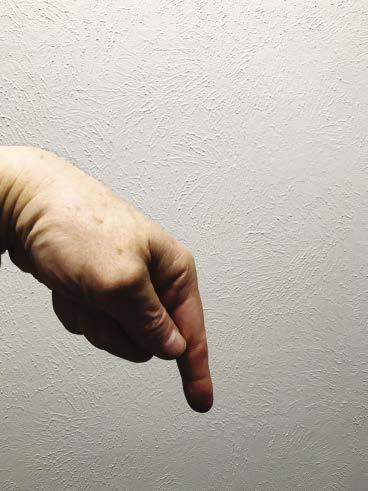

Audio expert and industry veteran Gordon Moore is the director of technical ministries at Rio Rancho United Methodist Church in Rio Rancho, New Mexico; president of Lectrosonics Inc; senior faculty member for the InfoComm Academy; and was named Educator of the Year for InfoComm in 2000.

levels (no distortion or clipping – does the compressor and EQ sound right?). The only adjustment you will make is to the level – no other changes. Make a note on the notepad if it sounds like you need to tweak the EQ or compressor. Don’t try to do anything but level during the 30s.
After 30s, stop the drummer and ask them to play whatever is next on your mixer. Repeat the above steps for each and every input/performer –for every instrument and voice. Remind each performer to play or sound at their loudest – just as they would during a performance. I find the vocalists are the toughest to get right – they will feel self-conscious singing alone and tend to sing more quietly. I quickly learn who is shy and who is not. I will adjust the gain for the quiet ones a bit lower (4dB to 6dB) than I do for the singer who likes to belt it out during the sound check. That quiet singer will blast everyone during the performance once they are in the spirit of the moment.
Finally, you will adjust the mix and the individual channel effects and dynamics while the band rehearses or warms up.
This method has three stages –setting individual levels with 30s individual input, creating the house mix with a full song playback involving everyone and then final tweaks while the band rehearses their other numbers.
song every time, some will play a piece they intend to play during that service. During this short playback everyone should simply listen and get their ears (and heads) into the game.
Set the monitor mixes – there are three scenarios. Scenario 1 is for systems with IEMs where the musician can set their own mixes using a personal mix controller. Begin with a quiet stage – tell the guitar player to stop messing around (I play guitar and it is in our DNA to be messing about with the guitar every moment it is in our hands). You will be listening with your headphones to each channel on solo. You will have a small notepad and pencils next to the mixer.
Begin with the first channel on your mixing console on left – channel #1. In most cases, this is a part of the drum set (kick for example). Ask the drummer to play only the kick drum for 30s while everyone adjusts the levels in their IEMs for the kick. Each performer is responsible for making the adjustments to their mix according to their needs. During that 30s, you can double check your input
Remember, during each 30s interval you will only adjust input trim – don’t worry yet about your house mix. At each step, your performers will be adjusting the levels for those who they want to hear in the IEMs.
If there are 16 inputs, this process will take about 12 to 15 minutes. Then, at the end, you will ask the whole band to play an entire number. During this number you will go to each channel where you made notes,

Scenario 2 is for when you are responsible for the IEM mixes as well, where you must also create the mix each individual performer hears. In this case, you will have to add a step during the 30s playback. The performers will need to indicate to you whether they want more, less or no change in their levels for each channel. We use hand signs in our church. While the drummer is hitting the kick, the other performers indicate a forefinger up for more, forefinger down for less and a flat palm (finger pointed towards me) for no change. If they don’t want to hear the kick at all in their ears, they use the hand across the throat for ‘cut it’. As soon as I see a flat palm, I stop adjusting for the mix.
is for when your mix involves a live stage with floor monitors. The process will be the same as with IEMs where you are adjusting the mix with one exception. You will need to have designated performers for each monitor on the stage. For example, you are adjusting a floor monitor that provides a mix to four backline vocalists. I guarantee that you will not be able to make four separate singers happy with one mix. But you can make one singer happy. Designate one person per
floor monitor to indicate to you the changes they want to have in the mix. Make it clear you will respond only to their direction. If you don’t establish this path of communication early on, your sound checks will be chaos. I find that using hand signs is the most useful. Train the performers to first indicate the source they would like to have an adjustment on their mix by pointing at them. Do they want more guitar? They simply point at the guitar, then make the thumbs up sign as you make adjustments – when it gets right for them, stop.
There is another big reason to use hand signs – nobody is yelling! All you hear is the music. The singers won’t strain their voices, and everyone can get your attention. Remind the




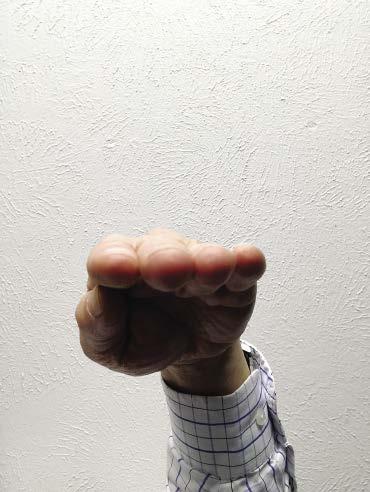

simple – I start with stage left – the performer who is on the farthest left position. During the check, I look at them and adjust until the level is correct. Then I point at the next performer (or use the talkback mic to tell them they are next). It takes only a few seconds per performer and generally can be done with the whole band within the 30s period. In about 10 minutes, our monitor levels are set and ready to go.


IEM (quiet stage) – ask the band to begin rehearsal. While they are

























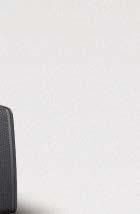






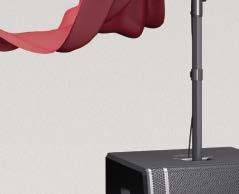

















should have been covered during the 30s checks. After the first song is finished, ask the band if any additional changes are needed for what they hear. Do not make changes in the house mix based on band members’ comments. They cannot hear what you hear, only what they hear, and the mix you are working on here is the mix for the house, not for them. Only your worship leader should have any say about the house mix.

For a live stage setup with floor monitors, there will be additional requests by the musicians for adjustments to their monitors.

At one concert where I was the mixer, I had a band who insisted on extremely loud floor monitor mixes. When I finally got to the house mix, the levels were already through the ceiling. I ended up simply sweetening the house mix (which was really the volume coming from the floor monitors) with the house speakers. It sounded OK but could have easily been 15dB lower overall. I will never make that mistake again. Now, if a performer wants more of something in an already too loud floor monitor, I turn everything else down a bit. More guitar? Lower the drums, the keyboards and the vocals in the mix instead.
The good sound mixer must maintain control of their system and the rehearsal in cooperation with the worship leader. Then document this whole process so your volunteers can fill in for you when you decide that a nice trip would be a good thing to do with your significant other.
By establishing a protocol that allows for a fast, smooth setup, you will find the sound check gets easier, smoother and faster each time. With modern digital boards, saving the last successful mix layout to a scene will allow you to recover the last great performance and the sound check should involve very few changes.

WE SEE THEM EVERYWHERE WE go nowadays. They appear as background panels in the studios of most major news networks, at supermarkets and shopping malls, and they can even be found towering over departure lounges at some of the world’s biggest airports.
Yes, it’s safe to say that videowalls are here to stay and are set for even bigger and crystal clear days by the looks of things. That will ring sweet music to the ears of production teams working at houses of worship around the globe.
There are several reasons why videowalls are growing in popularity in modern-day worship environments. They offer better image clarity for
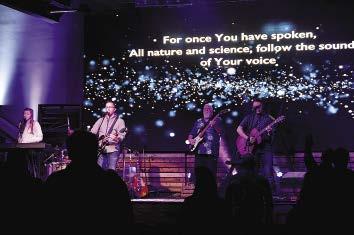


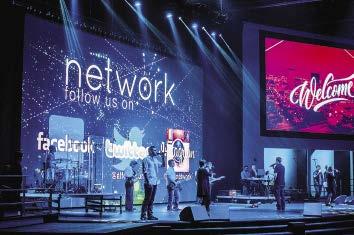
the congregation, their brightness can add to the ambience and they can be used for sermons, musical lyrics or live video feeds. But to get the source content, which could originate from a totally different feed, onto a wall but at a different size and possibly shape is not a simple procedure like connecting an HDMI cable. Enter the world of videowall scaling.
Scaling videowalls is hugely important because the right kind of scaling can determine the best possible output or the best kind of resolution needed. Once the content source is channelled through the switcher and into the videowall processor, scaling needs to take place to ensure the video picture is the correct size, or shape, for the videowall.
In most cases, the actual process of scaling is simply a case of using a jog wheel, or a similar function, on the videowall processor or controller to adjust the pixel dimensions after first accessing the size setup function.
So when wanting to set the horizontal dimensions, the horizontal edge function would be switched on and the jog wheel turned left or right to view the pixel adjustments on the actual processor display screen. Once you have scaled it to the pixel adjustments of the videowall, you would hit an OK or select function, then horizontal start. If it is set at 0, it means it is shifted all the way to the left.
theThe OG-Pinnacle-C videowall scaler card LED walls at the Cathedral of Faith (Photo courtesy of PixelFlex)
The same process would apply for the vertical dimensions with the jog wheel being used in the same manner to adjust the physical pixel count for the height. Again, once the relative dimensions have been aligned, you would hit an OK or select function and then vertical start.
For other video processors, a test pattern function is also available to assist processor users by offering them different preliminary pattern options for the videowall – such as grey vertical bars, SMPTE, Moving Cross or Pluge – when they are in the process of resizing the display. Once that is done and selected, you would need to go to the output menu to select the output window size to adjust the pixel sizes for the vertical and horizontal dimensions. Once the picture size is set up correctly on the screen, it will automatically scale the input video source to fit the set window size.
The advances in technology in the last couple of years have coincided with the evolution of videowalls that have begun morphing into different shapes and sizes. Some come wrapped around bending walls whilst others are different display walls strategically placed to form an elaborate pattern. This has been keeping many video and digital signage companies on their toes.
‘The last few years have been tricky because the nature of displays has changed as have some of the sizes and shapes of the displays,’ comments Stuart Russell, senior communications manager at Ross Video. ‘It’s been quite a challenge for the production engineers receiving the content because they have to then process the feed and make it work in a way that makes it look good on the videowall. It is imperative that the end product on the videowall looks the way the creators envisaged it.’
Of course, it is also important to note that the right kind of scaling, and indeed resolution, can also largely depend on the type of wall being used, namely LED and LCD. The higher-resolution LED videowalls are said to be quickly catching up to LCD walls in terms of popularity due to a decrease in the cost of manufacturing. The unique thing about LED videowalls is that they are built out of cubes or tiles, each with a very small number of pixels.
These tiles can be typically 64x48 pixels or 48x48 pixels but you can come across 150 pixels per tile. The LED wall is constructed from an array of these tiles that all act
together as one big display. This means that the resolution that you end up with has nothing to do with any standard resolution that you find on a projector or LCD monitor but is instead purely based on the number of tiles across the width of the screen and the number of tiles across the length of the screen. That, for example, means that with four 1080p displays fed together into a 2x2 videowall, it is capable
for tvONE. ‘The main thing is the actual scaling engine itself. You need to have a quality scaling engine that supports very high resolution and high bandwidth to properly display on those big walls.’ In places like houses of worship where displays set the tone of the sermon, it is vital that the onsite production team can easily operate and even rearrange the displays. Having the right kind of A/V
shapes – if needed – so we can actually configure those four panels in a line like you see on ringside screens at events such as sports venues.
‘But I wouldn’t necessarily say that there is a wrong or right way to scale videowalls,’ he continues. ‘We have NDI which is our network device interface as a means of moving video and audio around on the network. Using our output modules at the other end means we can actually put those connectors closer to the screen rather than doing long cable runs.’
For others like Mr Greenfield, FPGA-based video scaling is the best type of video scaling. ‘This is the best process for us because you get full resolution and bandwidth. There is also video monitor scaling
4K. But videowalls can offer 8K or even 16K of pixel output resolution. So a scaler is essential for the setup of that resolution and for getting imagery pixel-accurate on the videowall, sometimes as high as four or even 16 times its original pixel count for output on the videowall.
‘Nowadays, we are finding a lot more people wanting to go from a standard single screen to multiple screens or a big LED wall,’ says Alan Greenfield, regional sales manager UK, Ireland and Benelux
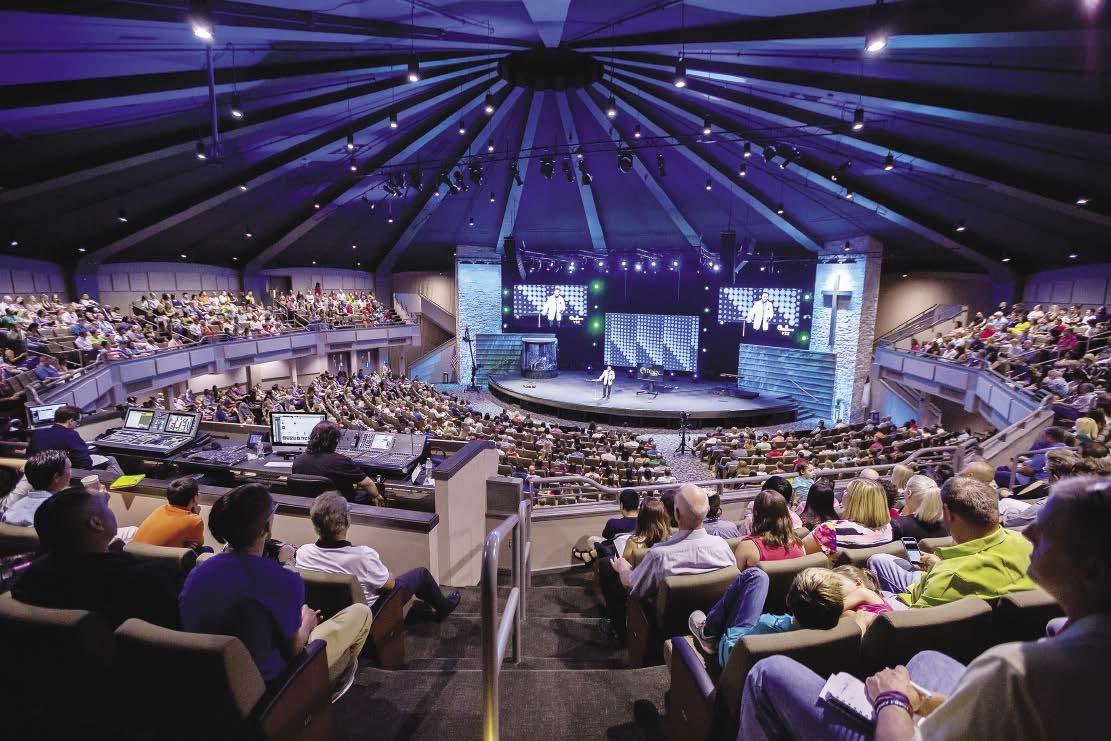
and HD-SDI so it can sometimes just be a case of the right kind of connectors selected as well as the different resolutions – including the graphics card – being processed for the different shapes and sizes of the panels.
‘We tend to use HD-SDI outputs so we rely on quad splits to send a 4K signal by dividing it into four HD sources and then reassembling them at the other end,’ claims Liam J Hayter, EMEA sales engineer at NewTek. ‘Those four different panels can be driven into different

individual high resolution outputs to each individual screen to give better quality scaling.’
Companies around the world are turning more and more to scaling and it already appears that size doesn’t matter anymore. For now, the challenge is making the content on the display look the way it should as opposed to how big it can be. Scaling still has a big part to play.
www.newtek.com
www.rossvideo.com
www.tvone.com

THE LIVE PERFORMANCE AUDIO chain in houses of worship most typically begins with a microphone and a cable. A few basic steps can extend the life of these critical links in the chain.
Let’s begin with coiling mic or instrument cables. It’s not uncommon to see someone wrap a cable between their hand and elbow, then wrap a tail of cable around the bundle and tie it in a half knot. This technique is to be avoided, primarily to mitigate damage to the shield inside the cable jacket. Tugging on the connectors and the tight wrap that results from knot tying should also be avoided.

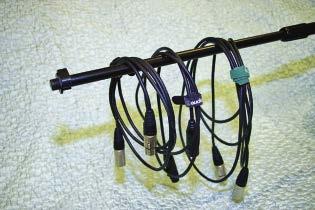
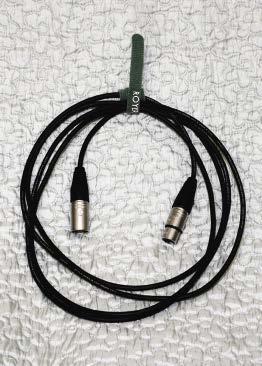


with visualising the steps, you can find numerous video examples online. Done right, you should be able to loosely hold the cable bundle in one hand, grab the cable between your finger and thumb where you started the process, then toss it cleanly out straight with no knotting.
The most convenient way to secure the bundle is with a Velcro tie that stays with the cable when in use and allows you to wrap the cable bundle securely for storage (Fig 3). At a
services, coiled neatly to prevent tripping, unless alternate uses of the facility will result in them being walked on or otherwise damaged.
The best cable coiling technique is known as the over–under wrap. You hold a cable in one hand a few inches back from one connector end then reach down with the other hand and grab a point 40cm or more down the cable and loop it over the wire you are holding (Fig 1). Grab another equal length of cable, but this time rotate your hand to bring the next loop in from underneath, rather than over the top and grab it into the bundle (Fig 2). Repeat until the cable is fully bundled. If you have trouble
studio I worked in, we tacked lengths of fuzzy/loop Velcro to vertical strips of wood and used a few centimetres of loose hook Velcro from the cable tie to attach the bundle to the wall. On stage, you can use a spare mic boom stand to hold a few cable spares locally for fast deployment (Fig 4). For HDMI and other utility cables, I’ve found it handy to mount a few cabinet knobs to a piece of wood, then mount that to a wall. Hanging the cables over the knobs results in a gentle bend (Fig 5). In general, cables can be left in place on stage between
Microphones can also be left in place between services, given the same caveats – that they won’t be damaged or knocked over during alternate use of the facility. However, the sensitive mic capsules and screens should be protected from dust accumulation. This can be accomplished by using a foam windscreen suitable for the size of the mic. If you typically use such a windscreen to prevent pops and plosives during services, you can simply leave them in place (though you should clean them regularly). If you don’t use such screens during services, you just have to pull them off prior to use.
An alternative is to put a ‘sock’ on an unused mic for protection. Don’t use a regular sock as you want something lint–free; there are custom socks or sleeves made specifically for the purpose, or you can use a drawstring bag (Fig 6).
If you are putting mics away between services, you can put handheld mics into zippered mic bags for protection. Many mics come with such bags. Mics that come with protective cases – often a provided accessory with large condenser mics and some wireless handhelds and headset mics – can be returned to their cases when not in use (Fig 7).
If you are placing mics in a secured cabinet between services, it should be relatively airtight to protect against dust. You can place pieces of open-

that shown in the mic case image. Textured foam will keep mics from rolling around, or you can carve mic–shaped recesses into the foam. Carve a silhouette of the mic into a 3cm to 5cm piece of foam, and rest it on top of a solid, uncut piece. Finally, if you are placing wireless mics in a battery charger base between services, put a windscreen or sock on them to protect against dust.
These simple steps, along with routine cable testing (see page 44 of the 2016 Jan–Feb edition of WAVL), help avoid critical failures in the crucial first links of your audio chain.


While seldom used in HOWs, LED tape can offer ministries a wealth of new and creative lighting options, discovers Simon Luckhurst

WHILE WORSHIP AVL FREQUENTLY contrasts the benefits of traditional incandescent lightbulbs with their LED brethren when considering stage lighting applications, LED technology has also added a whole array of new lighting techniques in a more general architectural sense. Imagine the creative possibilities of a lightbulb that you could wrap around your finger or roll out straight to create a display. Thinner than a credit card, light tape (LED tape) can be placed indoors and outdoors and on practically any surface. Lighting can be bent at the whim of the designer, with the only limitation being their imagination. This can allow HOWs to take advantage of a huge range of brightness levels, colours and programmed lighting scheme options.
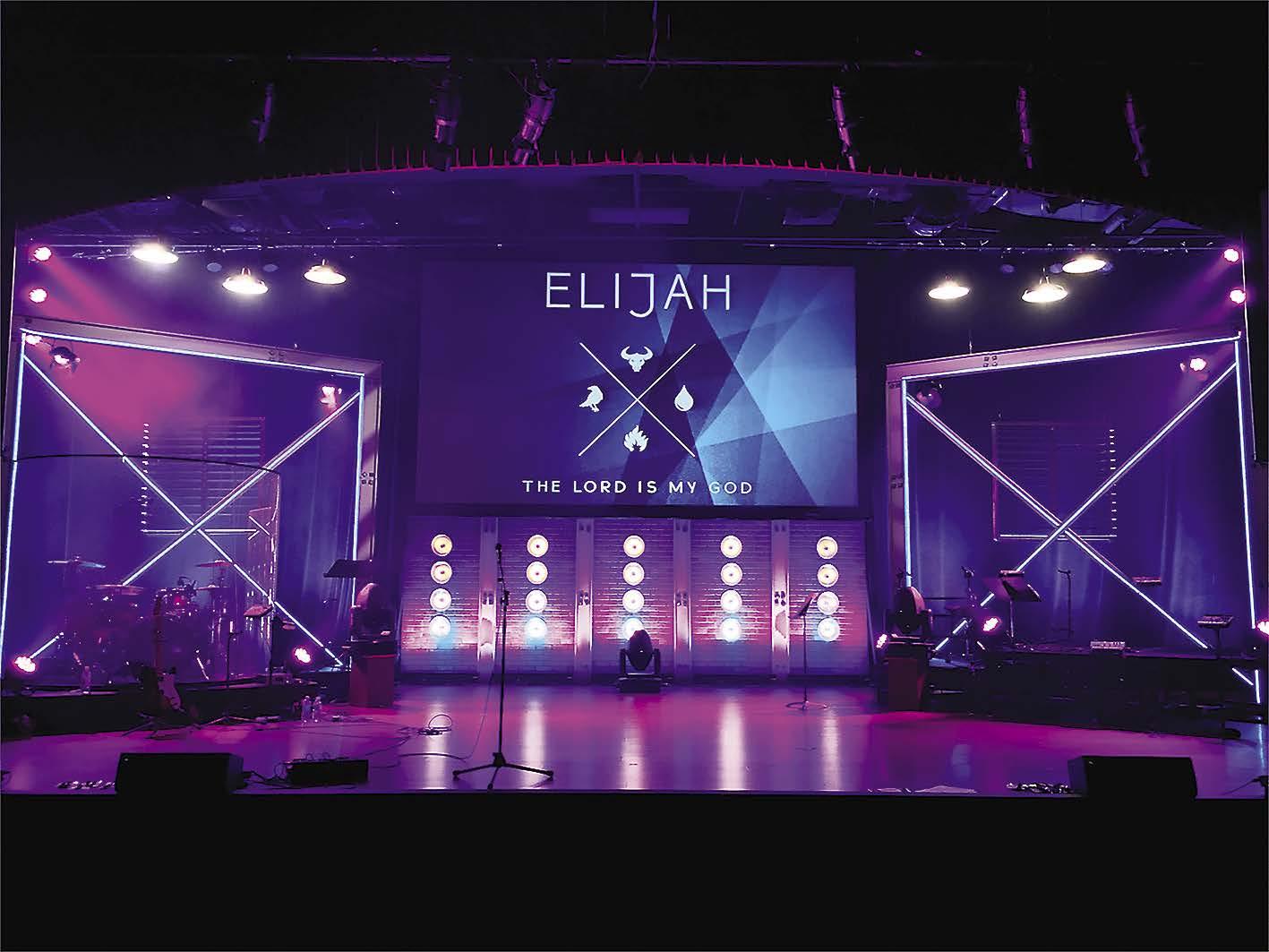
‘Light strip is really a generic term and lighting of this type is mainly referred to as LED tape or LED ribbon,’ explains Hilary Richie from UK-based supplier, LED Illuminations. ‘It comprises of tape with Surface Mounted Diode (SMD) LEDs on a 5m or 10m Printed Circuit Board (PCB) which is low voltage and can be cut every three or six LEDs to fit a specific application. It is available in IP20 (non-waterproof) versions and supplied with 3m adhesive tape on the back or as an IP65 (waterproof) version housed in a silicon tube.’
The overarching benefit of LED ribbon is that of flexibility. Surfaces can be directly affixed with light sources rather than having to project onto them from afar. ‘LED tape can easily be concealed on ledges to
uplight artwork on the ceiling. It is excellent to create accent lighting around a font, the pulpit and many other areas,’ says Ms Richie.
The ribbons are also typically very energy efficient, using minimal power yet able to produce enough light to replace fluorescent tubes (up to 1,440 lumens per metre).
A traditional incandescent 40W lightbulb outputs around 400 lumens – roughly the same brightness as a single metre of warm-white LED tape
using high-quality diodes. But rather than 40W, that metre of tape will likely draw less than 5W.
Strips can also be purchased in the full gamut of colours to match an existing lighting scheme, as well as colour-changing strips that can be connected to an LED controller. With this said, the LEDs in LED ribbons are not especially bright and would likely not be suitable for illuminating a space on their own.
Most LED strips appear nearly identical at a glance, but that doesn’t necessarily mean they are the same ‘under the surface’. There are many specifications available offering a wide range of colour temperatures (Kelvin), CRI and lumen output, choice of adhesives and drive voltage. For this reason, it’s sensible to think carefully about how and where they will be used before seeking suppliers.
In their simplest configurations, tapes are typically just a single-colour and non-addressable. The next step up would be multicolour tapes where
each LED is capable of displaying red, green, blue or all three (white). All the LEDs display the same colour at any one time, but the colour can be manipulated by varying the voltage applied to the power inputs. The most complex tapes are not only capable of offering a full RGB colour choice, but have individually addressable LEDs. Each LED has its own intelligent chip meaning it can be individually triggered for chasing, strobing and colour changing, thereby providing an extra dimension to show-based effects for the lighting designer. Furthermore, while typical SMDs have a 120° beam angle that emits light perpendicular to the mounting surface, side view or edge emitter variants are capable of emitting light parallel to the adhering surface, allowing the construction of LED strips that wash surfaces within a tighter space or accent edge profiles.
‘There are hundreds of companies and it is a minefield to know what you are getting as on paper they may all sound the same,’ confirms Ms Richie. ‘Two important factors to bear in mind are whether the company is professional and able to give advice/ assistance (more importantly still be there in six months should you have a problem) as well as the quality of the PCB and the manufacturer of the LED chips.’ She adds that ‘if a price appears to be too good to be true, then it probably is’.
Other key considerations, says Ms Richie, include ‘the environment that it will be used in (does it need to be waterproof?) and the length of the
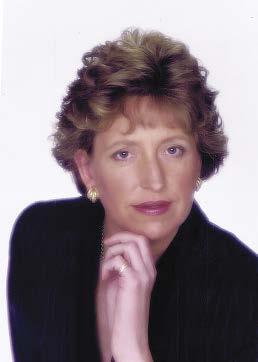
run – 24V tape can be manufactured for longer runs if needed’.
evolution models, including three e914s on the Kawai piano and e845 models for the singers. Two channels of Sennheiser e100 receivers and transmitters were deemed adequate for the current wireless setup.
signal flow. As a result, instead of the console bringing exciting new capabilities to production and sparking creativity, the production room became largely unused as staff were frustrated by the learning curve. With a desired return of accommodating the station’s needs, the console delivered a very poor return on investment, even though it technically met the outlined performance criteria. Technology deployed should enhance creativity, not stifle it.
Like their moving head counterparts, the use of LEDs in light tape provides distinct benefits in terms of maintenance, with typical lifetimes measured in the tens of thousands of hours. ‘LEDs tend not to fail like conventional incandescent lighting but the colour degrades/shifts over a period of time and may not appear so bright,’ notes Ms Richie. ‘The environment has a lot to do with the lifespan. LEDs prefer cold environments as heat will cook them to death. If they are installed correctly, you should see two to three years of use with five years often achievable.’
like video images. Projecting standard definition video for IMAG purposes will be noticeable to even the casual viewer, based on their subconscious perception of acceptable quality, when high definition is what they’ve come to expect from their familiarity with higher resolution video from
tablets, and even from mobile phones. A worshipper may seek out technical team members to note a readily apparent improvement in sound or image. But a more common situation is a worshipper reaching out with a complaint when their expectations are noticeably unfulfilled. Chronic sound
DMX decoders enable the strips to be interfaced with a venue’s existing DMX-based lighting system.’
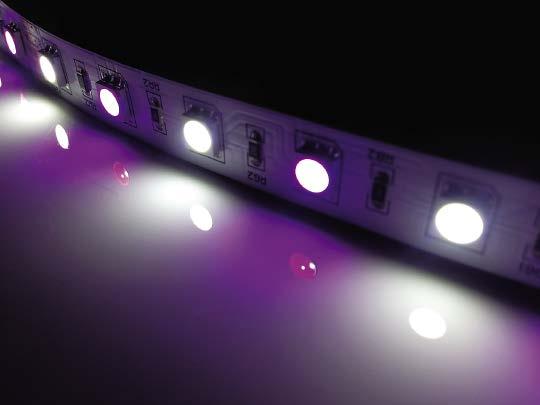
The visual content in the second-floor sanctuary has been enhanced courtesy of a new system that is also capable of transmitting services to the chapel, cry room and office when required. Two Panasonic AW-H60 PTZ HD cameras together with a single AW-H2 HD compact model are operated from an RMC-190 remote camera controller.
USA: Three years ago, the weekly attendance at Crosswalk Church was dwindling with a congregation of 80. The Californian church’s fortunes changed when Pastor Tim Gillespie joined and grew the congregation to its current 1,200 weekly attendees. He accomplished this by embracing several elements common in modern worship, updating the décor and implementing a large production studio to facilitate live streaming, which has attracted new worshippers. ‘There’s a lot of people around the country who are in touch with our pastor but aren’t able to attend,’ explains Chad Manalo, worship director of Crosswalk Church. ‘We decided to live stream for people who aren’t able to attend, such as those on vacation, travelling for work and those who live far away.’
It has often been said in these pages that the best applications of technology improve the worship experience for a congregation, without calling attention to itself. Technology for worship should accommodate the goals of a HOW, be that musical performance, setting an appropriate atmospheric mood or improving communication. The newest technologies may have a ‘cool’ factor for the technical staff but, if its application results in showmanship, the technology may become a distraction.
The video operator presides at the controls of the Datavideo SE2200 6-channel video switcher in the control room, which receives three of its inputs from Panasonic HD H-60 and AW-H2 HD compact video cameras –controlled from an AW-RP-50 remote controller – that have been fixed to the rear and front walls. In addition, Blu-ray and PC inputs are also added to the video mix to display content, which can be analysed from a PC monitor for which the resultant HD images are displayed from two main L-R 9,200 ANSI lumens Epson EB Z9900 projectors onto the rear wall either side of the altar. A Datavideo HDR-70 HD/SD 320GB video recorder has
When the inevitable does happen, however, ‘LED ribbon is wired in groups of three LEDs and, if a fault occurs in one batch of LEDs, it doesn’t affect the rest of the line’.
One of the most common questions asked by users looking to install strip lighting concerns power and control. Strip lights commonly operate on 12V or 24V of direct current. ‘As the LED tape/ribbon is low voltage, a transformer/power supply will be required between the LED and mains supply,’ explains Ms Richie.
system to produce feedback, will draw complaints faster than a sound system
changing strips can be controlled via
‘We run 100% on volunteers and every week there’s a new member on the production team,’ says Mr Manalo. ‘So for me, it was all about designing an easy-to-use system that doesn’t require experience to use.’ The Teradek Cube 655 has reportedly provided the simple solution the worship director required as volunteers only need to press the red ‘stream’ button to go live.
Moving head lighting, like this Chauvet model, may provide good ROI based on flexibilty
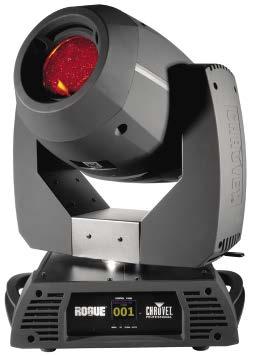
that common in HOWs, ministries looking for inspiration would be wise to pay attention to lighting in retail environments. Here, LED tape is frequently used to highlight displays and specific edges, all with the goal of directing a customer’s view towards a certain product. The next time you are out and about, pay close attention to how various surfaces have been illuminated and highlighted – there’s a good chance it is LED tape doing the job.
At the same time, outdated or inadequate tools may underperform, providing a different sort of distraction. For example, in their personal lives, worshippers are likely to be used to life-
production switcher that enables the operator to switch between each feed and to add graphics. The switcher then distributes the content to several television screens around the church and to a Teradek Cube 655 streaming encoder.
Removing the need for a separate power supply, mains-powered LED activity. This can be achieved with
Mr Manalo oversees all elements of the production, including stage design, lights and music as well as live streaming. He and his team stream services using three Canon XA35 and four Xiaomi Yi Sport video cameras throughout the sanctuary. The feeds from all seven cameras are directed to a Blackmagic Design Atem 4K

been added as an output allowing the services to be recorded for members of the congregation unable to make one of the three services. An Epson 585W Ultra short throw projector has been added as an assistive visual aid in the rear room. A simple lighting solution has been added to two lighting bars in the ceiling whose fixtures are controlled from a Magic Q interface in a rear control room PC.
Kling & Freitag balances passion with precision for uncompromising audio quality and 'German engineering'.
We are driven by a desire to provide and technically guarantee music and sound as a genuine sound experience. This is what each product by Kling & Freitag stands for - or, as we say, 'Passion built in'
The Cube 655 is an H.264 live streaming device that transmits the

This LED ellipsoidal from Elation Lighting may provide a better ROI than a conventional fixture

Following the almost two-year exodus at the Hebron Yew Tree Presbyterian Church, the Bukit Panjang faithful feel good to be home. Although the
video it is fed directly to live streaming services such as Facebook Live, YouTube and UStream. Crosswalk Church uses it to stream its services live via its YouTube channel at 1080p30 with a bit rate of 4Mbps. The YouTube videos are embedded on the church’s website and promoted via social media.
‘Right now our main streaming purpose is our Saturday church services,’ concludes Mr Manalo. ‘But there’s going to be some big outdoor church events happening and it’d be great to live stream those. We also want to offer it as a service so if people rent out the worship center for weddings or events, they could stream with our setup.
www.ledilluminations.co.uk
opening ceremony took place in mid-January slightly later than the Christmas deadline that had been hoped for, the combination of Mr Soo’s electro-acoustic consultancy together with PAVE’s dedication and flexibility ultimately delivered a solution that surpassed the client’s expectations.
‘The sanctuary sounds more like an auditorium than a church,’ observes Mr Chan. ‘We didn’t want to lose the essence of Christ or distract from the spoken word, but we have to think ahead as music is becoming an increasing part of the service.’
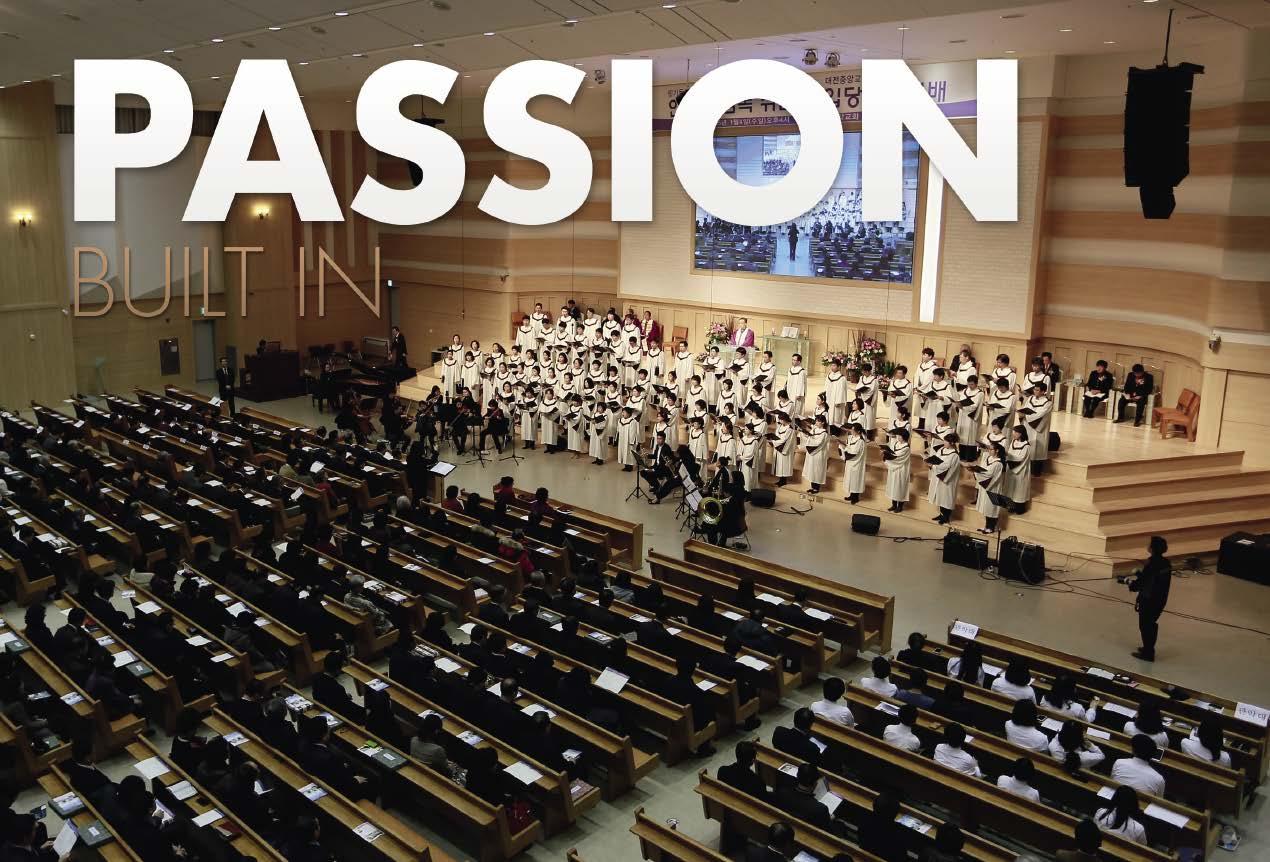
‘Live streaming has really become a great way to get our community together without having to physically attend. A couple of people tune in from Australia to watch it every Saturday. My parents live in Seattle and they watch it as well.’
www.bpgospel.org.sg
www.crosswalkvillage.com www.teradek.com
www.pave.com.sg
prudently and wisely. A HOW that purchases technology based on what’s cheapest may be realising a poor ROI and find itself replacing that gear sooner than would have been necessary had a wiser purchase been made, even if initial costs were higher. At the same time, buying topof-the-line gear without needing all its capability may waste funds that could be used to meet other needs. A HOW’s ROI evaluation cannot be based purely on accounting factors, but through the consideration of both financial and more intangible considerations. Such ROI calculations and being good stewards of a HOW’s technical budget are a crucial part of a technical ministry.

BEING ABLE TO EFFECTIVELY communicate with the congregation is arguably one of the most important aspects of group worship, yet nowadays in the US nearly 15% of adults over the age of 18 identify as suffering from some form of hearing loss. And these figures expand rapidly with age: nearly 25% of those aged 65 to 74, and half of those 75 and older, have a disabling hearing loss. Add in the fact that traditional houses of worship typically suffer from high levels of reverberation and ambient sound and churches present the perfect environment for the message to get lost. Helping these people clearly hear what’s going on around them is the job of an Assistive Listening System (ALS). Furthermore, assistive listening is covered in the US by the Americans with Disabilities Act (ADA) which mandates the use of ALSs in facilities required for entertainment, education and civic gatherings. While houses of worship are not currently on this list, it is likely just a matter of time.

ALS technologies seek to connect listeners directly to the sound system microphones, bypassing background noise, the distance from the sound
source and acoustic effects such as reverberation. ALSs connect to the facility sound system mixer and make use of the existing wired and wireless microphones to pick up speech and music. The microphone signals are then sent by wireless transmission directly to listeners, who use a receiver and earphone, or their personal hearing aid to hear the service. All the major systems can accommodate any number of listeners and offer seating freedom with individual volume control.
‘Worship facilities today have a
number of choices to meet the needs of hearing impaired worshippers,’ explains Williams Sound CEO, Paul Ingebrigtsen. ‘First, it should be mentioned that ALSs are meant for people who still have some hearing ability, not for deaf people who are unable to hear.’ To serve deaf people, ministries will have to employ sign language interpreters or captioning technology.
Traditionally, an ALS, much like in an airplane seat, would have connected users directly to the audio system via jacks and headphones, but thankfully there are now a range of more elegant and flexible wireless solutions on offer. The question is determining the most applicable technology for your sanctuary, and that largely depends on use and circumstance.
‘Several technologies exist for assistive listening applications. Radio frequency (RF), which functions similarly to an FM radio, and infrared (IR) both require the venue to install a transmitter/radiator and the end user wears a receiver that is typically held or worn around the neck,’ says Listen Technologies’ marketing director, Kim Spencer. ‘A hearing loop or induction
flooring, but temporary loops can be installed on top of the floor surface. The audio signal is sent through the loop and picked up by the telecoil function of the end user’s hearing aid. The last technology that can be used for assistive listening is Wi-Fi, which allows the end user to hear the audio on their own smartphone with their own earbuds using a free app.’

Not everyone can rely on just their unaided ears to fully appreciate and engage with HOW services. Simon Luckhurst discovers what technology can assistPaul Ingebrigtsen, Williams Sound CEO Kim Spencer, Listen Technologies’ marketing director

‘These technology choices differ primarily in the method of wireless transmission used and how the listener receives the signal, but all can accomplish the desired result,’ adds Mr Ingebrigtsen.
For many years, the only way of providing an effective and wireless ALS was via an induction loop. The primary benefit of this system is that end users don’t need to carry any additional gear as their telecoil hearing aid receives the audio signal directly. A loop amplifier is connected to the sound system and a wire is placed in a specific pattern around or under the seating area to produce a magnetic signal. Listeners activate the magnetic telecoil in their hearing aid, adjust the volume and can hear the signal without the need for a separate receiver device. A receiver can also be provided for those users without telecoil hearing aids.
WITHOUT NECESSARILY EVEN knowing what lighting colour temperature is, the effects of different temperature light sources are clearly understood and experienced every day. I’ve often used the comparison of an up-scale retail store and a hospital wing in talking about the difference in how you feel in each environment due to lighting choice. I’ve also used the terms warm and cold to describe qualities of light and discussed how one or the other can be used effectively a lighting design to affect how a viewer feels.
typically to 2-channel stereo, with the option for mono or surround sound. Applications include the playback of individual instrument or performer recordings within an ensemble and provide the ability to re-record a track if necessary. Say, for instance, that the piano player hits a bum note; their part can be recorded again individually and inserted into the final mix with the rest of the band’s original performance. MTR can also be used for recording a redundant feed as a back-up in case of a system failure. Complex recordings, or recording of backing music for a drama performance, could be pre-recorded. MTR recordings can also be used for virtual soundchecks, for training sound engineers, for musicians to analyse their own performance and for system troubleshooting. Where recording typically differs in a house of worship from a recording studio is that HOWs tend to record audio from a live performance, similar to a concert. Therefore, whereas the band can start over should the singer flub a line in a studio, no such luxury is afforded when there is a full congregation watching and listening. While this may result in a cringe-
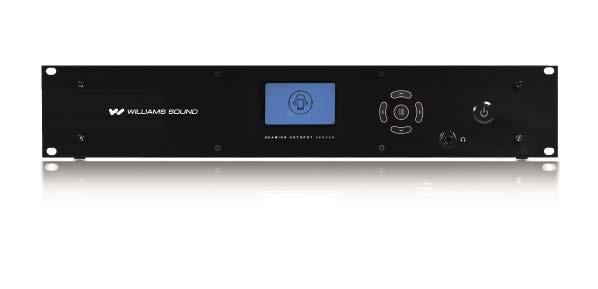
be available in all countries,’ adds Mr Ingebrigtsen.
IF YOU’RE FAMILIAR WITH THE term ‘pixel’ but have not heard the term ‘pixel mapping’ used in reference to lighting, you may be wondering why this is a topic in the lighting section. Isn’t ‘pixel’ used in reference to video and graphical hardware and media content? That’s true! However, the worlds of video and lighting have been converging both at the console level and the fixture level, and this has opened up a whole realm of lighting effects and possibilities that used to either reside in the video department or would have taken a huge quantity of lights and consumed excessive programming time.
‘With an induction loop or hearing loop, end users don’t need to carry any additional gear – their hearing aid receives the audio signal directly,’ comments Ms Spencer. ‘This saves them having to arrange for a receiver or worry about sanitation issues.’
In this article, we’re going to look a bit deeper into lighting colour temperature and why it matters to worship lighting techs. Hopefully you will come away with a better understanding of how it can be intentionally considered to improve your lighting designs.
‘This also minimises the ALS management for the facility, as the users essentially manage themselves,’ adds Mr Ingebrigtsen.
‘The facility does not have to purchase and maintain receivers and earphones for users, and the listener’s hearing aid specifically tailors the audio frequency response and loudness to the individual’s hearing loss.’

inducing moment on stage there in the moment, it can be rectified later on for the recording. While the singer could perform the entire song again once the congregants have filed out and gone home, there is the possibility that they could just sing the one line they made a mistake on. This is via a process known as punch in/ punch out. While this was possible to do back in the days of tape, it’s easier than ever to splice out the mistake from a recording and punch in the re-recorded audio. One potential issue that can arise when punching in and out is mic bleed. For example, did the rhythm guitarist’s mic capture the singer’s vocals, and therefore the mistake, too? If so, you can punch out the line on the vocalist’s track, but it’ll still be heard in the background. This is why many studio sessions will record each member of a band’s performance individually, or with individual musicians isolated acoustically, to avoid such spill. Again, this is a luxury not afforded when recording live performances. Additionally, via the process of overdubbing, new tracks can be added to an existing recording. While not always ideal, it’s another way in
done easily and at lower cost during new construction, but may be very difficult and expensive to install in an existing facility. Very large facilities and unusual floorplans become increasingly difficult and expensive to install one or more loops and so, depending on the size and shape of the facility, it may not be possible to adequately cover every seat.’
Because of high installation costs, a loop system may not fit within the budget of a facility. Additionally, induction loops are also singlechannel systems, so they cannot be used to transmit multiple signals, such as when language interpretation is being offered. They are also subject to interference from electrical devices and power distribution equipment. Large amounts of structural metal may reduce the magnetic signal and provide unacceptable performance.
‘Radio-based systems offer the simplest, lowest-cost installation in most facilities,’ says Mr Ingebrigtsen. ‘They do require a set of receivers for listeners to use but, even with the added cost of receivers, they are generally the most economical system. RF systems can cover small to very large facilities and can even accommodate listeners in their cars in a car park. They don’t require extensive cabling and can be concealed for aesthetic reasons or to avoid disruption of historic architecture. Radio-based systems can operate on multiple channels, making it possible to offer multiple languages or visual description services. RF systems also offer excellent sound quality.
John Black, theatre manager for Seoul Foreign Schoolin displays, garages, work areas and other environments needing crisp, cool light.
An IR emitter is connected to the sound system. The emitter ‘floods’ the seating area with an invisible IR light signal that carries the audio and listeners use a small receiver and earphone to hear the service. IR systems are typically slightly more complex to design and install than RF systems, but less expensive than induction loop systems. They can also provide multichannel broadcasts.
‘IR functions similarly to a TV remote control,’ says Ms Spencer. ‘It uses light to transmit the audio signal from a transmitter/radiator to the receiver worn by the end user.’
‘IR systems are not affected by radio interference, so they can be used in noisy RF environments,’ explains Mr Ingebrigtsen, ‘but they are blocked by solid walls and stay within the facility. This is important if privacy is a concern, or if multiple services are going on in different rooms in the facility.’
incandescent, fluorescent or LED and it refers to the colour of the white light they produce. The lower the degree Kelvin, the warmer/more orange the light will be. The higher the degree Kelvin, the colder/more blue the light will be.
‘The downside is that RF systems require the facility to purchase and maintain receivers for users, while FM systems may suffer from radio interference in central city locations that have intensive radio signal environments. RF systems might not
3,000K. These are most often used in residences, commercial retail, restaurants and other environments looking to create calm, inviting and intimate feelings.
Every digital image is comprised of pixels. Millions of them. We often hear the term pixel used when specifying the resolution of a display screen on mobile devices and TVs, or when comparing the specifications of digital cameras. A pixel is a single, programmable unit (think single dot) of coloured light. Within a given space, the smaller the pixels (and thereby the greater the quantity of pixels), the higher the resolution of the image (sharper, clearer and more detailed).
Have you ever been looking at your lighting design with your eyes, and then looked through the lens of a camera at the same lighting and seen the reds or blues way over saturated or incorrectly reproduced? Or have you even panned a camera from the stage to an audience shot and the colours of the audience been thrown way out of whack? Chances are you have witnessed how the human eye and the camera eye can pick up completely different images of the same lighting look. Notice that all of the descriptions I used above are related to white light – and that’s what colour temperature measures – the perceived colour of white light.
While great for privacy, IR systems operate by line of sight, meaning a receiver must physically be able to see the emitter to transmit the signal. This also means that the emitters cannot be concealed, so may be visible to the audience. ‘With
Colour temperature is a way to describe the appearance of the light provided by a lamp and is measured in degrees of Kelvin (K). Most lamps will fall between 2,000K and 6,500K, and the measured colour temperature will let you know what the look and feel of the light produced will be. It is important to note that lamps are rated for colour temperature regardless of if they are
A radio transmitter is connected to the sound system, which broadcasts an analogue or digital radio signal, depending on the type. Listeners use a small radio receiver and earphone to listen to the signal. RF systems include FM, digital and Wi-Fi transmission systems.
You will often see on the packaging of lamps – both residential and commercial – a colour temperature description for the lamp, as maybe even a word description used to describe common lamp temperatures. The following three descriptions are sometimes used:
Tracks Live from Waves presents a more budget-conscious option
However, the Williams Sound CEO stresses that ‘successful loop installations require careful design and planning and this can be an added expense. This can often be
Hopefully by the end of this piece, you will have an understanding of pixel mapping and how it has entered into the lighting field. I will highlight some of the products available on the market that can be used for pixel mapping and also discuss the basic process of pixel mapping and how it can be implemented into your events. Understand that I will not highlight the programming process for any one console, but will explain in general so that you have an idea of how to start with the equipment that you have available.
Warm White lamps will generally be measured between 2,000K and
‘RF transmits the audio on a specific channel to a receiver that is also on the same channel, worn or held by the end user,’ explains Ms Spencer.

Neutral White lamps will generally be measured between 3,100K and 4,500K. These lamps produce a neutral white light and are often used in work areas, basements, garages and other environments needing a bright, vibrant light source.
which MTR has your back. Another benefit MTR brings is that it enables engineers to refine the levels and EQ for each track during mix-down.
Microphones are, of course, required for singers, speakers, musicians and any other performers. In a typical
Daylight lamps will generally be measured between 4,600K and 6,500K. These lamps produce a blue–white light that most closely mimics actual daylight. They are often used
A good example of this would be to think of an LED videowall display panel. These units are manufactured with certain ‘pixel pitch’ specifications. Pixel pitch is the physical distance between each LED diode (or pixel). For example, Barco makes an outdoor model, the T10, with a 10mm pixel pitch. They also produce an indoor model, the X1.2, with a 1.29mm pixel pitch. The smaller the pixel pitch, the higher resolution the image will be – but also the more expensive each panel will be due to the increased number of diodes.
setup, once vocals or instruments have been captured by the mics, the signals will be sent to a mixing console. It is to the mixing console that a multitrack recorder might be connected. Alternatively, some consoles combine mixing and recording functionality, negating the need for a separate recorder. These devices carry no fancy names; you’ll
Human eyes are remarkable in that they can automatically adjust the perception of the colour of white light. This is not the case for other equipment requiring light, however, such as camera sensors and screens. Many digital products have options to auto white balance, allowing the device to adjust the way the sensor reads white light, but it’s not perfect. As a result, most devices allow the operator to manually adjust the white balance so that what is recorded or broadcast is
Not all white light is created equal. John Black explains how this range, measured as colour temperature, impacts lighting design, and how both the eye and the camera lens see this spectrumTaken at Cornerstone Church in Toledo, Ohio, USA, the camera is colour balanced for the audience lighting, while the stage shows somewhat warmer (orangeish) because the stage lighting has a different colour temperature
light used to light up a backdrop,’ adds Mr Barrett.
The good news is that you don’t need to worry too much about whether the fixtures will always be used as fixed or portable solutions.
proper design and installation, this is generally not a problem,’ confirms Mr Ingebrigtsen, ’but reception may be blocked in certain areas by large columns or walls. Direct sunlight can also cause interference if there is a large window area, but this is rare in worship facilities.’


into underutilised space behind the original stage position, moving the front of the stage to where the back of the old stage was located and allowing room for 200 additional seats. Membership at Hope Centre is over 800. ‘We have main hall seating for 700 people plus overflow rooms, and a smaller conference room with table seating for up to 250 people plus a large café,’ Mr McLeay reveals. Along with its slate of worship services, weddings and funerals, Hope Centre hosts conferences like Raging Fire and Promise Keepers as well as conferences from other churches. Maranatha Christian School (planted by the Hope Centre 50 years ago) also uses the facilities for some of its events.
A server or streamer device is connected to the sound system. The server encodes the audio and sends it to a wireless access point (WAP), which then transmits the audio throughout the listening area as a Wi-Fi signal. Users bring their own smartphone, which acts as the receiver and connects to the Wi-Fi network in the facility. Congregants then use a special listening app on their phone to hear the service.

there.’ Keyboards and drums are the only instruments that stay in place, with the exception that, ‘sometimes the worship leader plays keys and we pull a keyboard to the front of the stage.’ Flexibility in stage configuration is facilitated by multiple stage boxes placed all over the stage. ‘There’s 10 floor boxes, most with four to six inputs, and two to four returns,’ elaborates Mr Brain.
‘One of the main advantages of a Wi-Fi-based ALS is that that users can




‘Our services are contemporary,’ says fellow tech team member Dean Brain, ‘with a praise band consisting of guitar, bass guitar and keyboard players, a drummer and typically four or five vocalists.’ Most of the musicians also sing. Hope Centre has 35 members
‘Today most moving lights are designed for both fixed and portable use so there really are not many major differences,’ explains Mr Loader. ‘The more powerful a fixture is, the harder it is to move around, but in general they are all meant to hang with pipe clamps and easily move when required. If you plan on putting units on the floor – this also works well for back lighting and uplighting the stage area – find fixtures that are typically under 20kg so you can move them easier with one person. There are some fixtures made now with an IP rating of 65 that allows for outside installation, but in general most moving lights are IP20 meaning for indoor use only – although many people use them outside and just hope the weather cooperates.’
Mr Bowden agrees: ‘The only differences would be found on architectural fixtures that require higher ingress protection ratings [the degree to which elements including dust and moisture can penetrate a housing].’
In addition to the fixtures themselves, you will also require something with which to control them. ‘A DMX controller is generally required to get the best from a moving fixture,’ states Mr Bowden.

‘There are some very powerful software solutions out there today,’ says Mr Loader. ‘You can easily put systems under one DMX universe

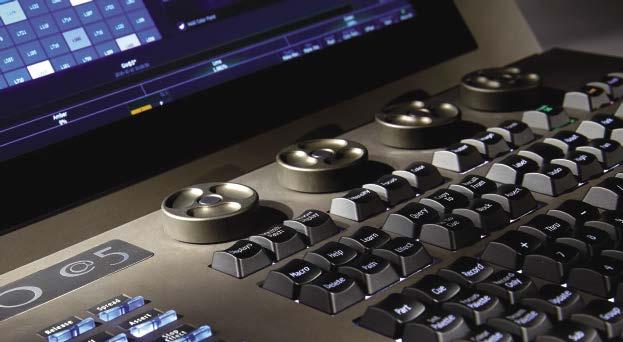
facility to purchase receivers and maintain them, and can also be scaled in size for small to very large facilities while providing multiple channels,’ offers the Williams Sound CEO. ‘Wi-Fi digital radio systems can overcome interference from
overall in its pool of performers. ‘Of those 35 members, it’ll be 10 to 12 each Sunday,’ he shares further, ‘with the band make-up rotating each Sunday.’ Multiple praise bands are configured out of the available pool, with each roster performing one Sunday a month for three months before reconfiguration. A full band performs at 10am each Sunday morning and, somewhat uniquely, at 6:30pm each Sunday evening. ‘Hope Centre gets a lot of attendees visiting from neighbour churches,’ says Mr Brain, ‘churches that may not be able to offer a live praise band worship experience on a Sunday evening.
‘Every Sunday,’ he adds, ‘we start with a clean stage and set up from



been in use for some time now,
for hard-of-hearing people in
The expanded sanctuary is 32m long x 24m wide with a 5.5m ceiling height. The external walls are concrete; the interior walls are timber with plasterboard linings. ‘Both the side walls have been treated with Autex, as well as the back wall of the stage,’ says Mr McLeay, regarding the Autex Compostion line of polyester fibre acoustic products deployed for sound control. ‘The rear wall of the auditorium is on a 200mm angle [non-parallel] from the stage with some acoustic treatment on the top half of the wall,’ he adds, ‘to control the bounce-back to the stage.’
[512 channels] on a laptop and control the system as needed. Once you go beyond one DMX universe, it’s usually better to get a console or at least a control/playback wing to allow easier control of the fixtures and playback via faders for fast access to programs. Getting large lighting consoles is great, but often the learning curve to operate them can be steep and getting experienced operators can be tough if you don’t have a good training programme in place.’
It seems as if the migration towards LED lighting has had a positive impact on moving light fixtures, and, with hybrid options on the market, the costs involved won’t be too eye-watering. ‘Visual effects are a bonus of moving lights,’ reveals Mr Loader. ‘The practical use and elements they bring far outweigh the sizzle they provide. Some of the best shows I have been to used moving lights that you don’t see move at all during the performance. Being able to position fixtures “in the dark” allows you to change the scene and environment in a snap. Using moving lights can change the complete look of a room. We often tell people you don’t need to paint your room a different colour – just change the colour on your moving lights!’
‘The HOW market has always been a strong market for assistive listening as everybody wants to engage and feel connected to each other and their faith,’ notes Ms Spencer. ‘In addition, more and more HOWs are serving multiple cultures with language barriers, increasing the need to provide language interpretation in addition to assistive listening.’
Even once you’ve selected and installed your new ALS, it is also vital to publicise its availability and to encourage its use. After all, the most expensive system for budgetconscious HOWs is the one that doesn’t get used, regardless of the technology chosen.
www.chauvetprofessional.eu


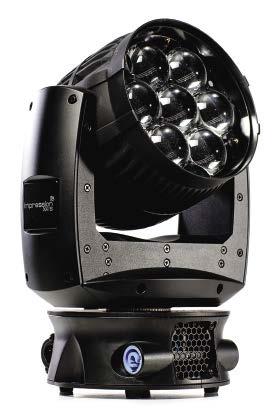
www.listentech.com
www.elationlighting.com
www.williamssound.com
www.glp.de
DESIGNED FOR small-scale applications, the Maui 5 Go is the world’s first mobile, battery-powered column-PA system according to its German manufacturer, LD Systems.
The lithium-ion replacement batteries can provide up to six hours
of battery life from a single charge and can be instantly replaced using Quick-Swap technology. The 400W RMS-rated system is equipped with both a microphone and a four-channel mixer with individual input, main and

subwoofer level controls and a variable HF boost together. Further features of the 13kg four-piece speaker system include multi-pin connectors for quick assembly, Bluetooth connectivity and DSP offering


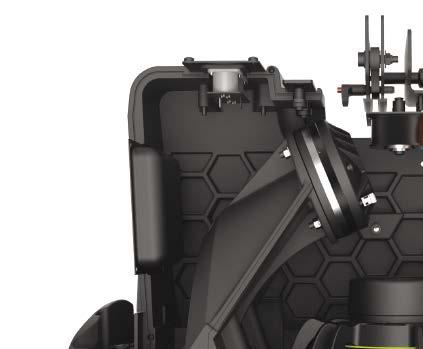



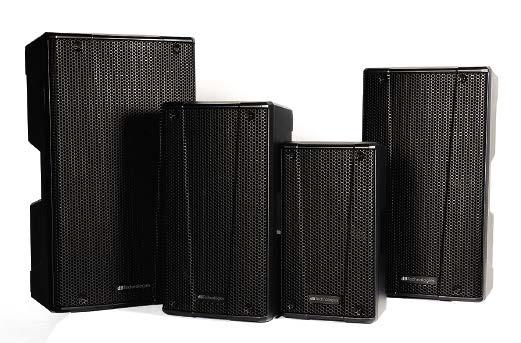
magnification (IMAG) applications in houses of worship, as well as video playback, projectors have traditionally been the standard. After all, a 19inch television set wasn’t going to cut it for a congregation of several hundred, particularly as the worship leader would have appeared larger in person anyway. But, as our TVs have grown larger, the technology within has evolved from cathode ray tube (CRT) to light-emitting diode (LED). Composed from a raft of LEDs, LED displays are able to showcase video content on a ‘flat’ surface; hence, the television adorning your living room will be a ‘flat screen’ in 2018. Images are created by the blend of LEDs illuminating in different colours, typically RGBW (red, green,
DBTECHNOLOGIES HAS created the B·H series to deliver accurate audio reproduction whilst producing efficient sonic performances in multi-functional applications. The four two-way models in this newly developed series each combine a Class D amplifier capable of providing SPL up to 126.5dB. Each of the 8-, 10-, 12- and 15-inch woofer models are equipped with 1-inch compression drivers coupled to an asymmetrical horn to ensure a wide and uniform throw pattern. Internal DSP comes in the form of a Flat or Boost EQ switch, allowing sourced BGM to be either faithfully reproduced or boosted according to the environment.
blue, white). While projectors can be adjusted to beam their visuals onto screens of varying sizes, LED
Weighing between 6.4kg and 17.3kg, the cabinets incorporate full grille design. Whilst portability is enhanced with the addition of three handles, multi-functionality is assured by dual stage monitor angles and pole
cup for use as a portable PA system when mounted onto a subwoofer.
In addition to the new B-H series, the Italian manufacturer has also introduced two subwoofers designed to complement its full-range Opera
displays can be scaled up by adding multiple LED panels together to create a videowall. The only limit in
a multiband limiter, equaliser, compressor and crossover functions. Flexibility is enhanced owing to its immunity to system feedback, promoting its use as a stage monitor.
www.ld-systems.com
size, therefore, will be the increments in which your display increases.
cabinets as part of the Sub 600 series. Both models feature a 600W RMS Class-D amplifier with SMPS. The Sub 615 is equipped with a 15-inch transducer while this is increased to 18 inches for the Sub 618. This results in a high maximum stated SPL for the Sub 618 of 133dB.
‘Each house of worship has its own unique needs, and LED and projection can both be a strong fit,’ says Jim Hall, senior product manager at Christie. ‘The ideal technology can be determined by examining room characteristics, including shape, ambient light levels and sightlines, audience size and A/V budget. Projection offers worship sites a low cost of ownership and installation, a choice of resolutions and a flexible image size.’

Users are reportedly able to form PA systems with a single sub and two fullrange speakers without the need for any external processing or crossover. Controls on the amp panel allow users to operate with mono or stereo feeds, invert polarity and select the output link mode. A Sub Mode switch boosts the low frequency EQ.
www.dbtechnologies.com
‘Benefits that LED displays have over projection include brightness, longer lamp life, easier serviceability, no unobstructed projection distance required and it is a similar cost to project depending on comparable
1/2PAGE HORIZONTAL
size,’ says Elation Professional sales director, Eric Loader.






‘Without a doubt, LED panels are taking market shares from smallerscreen projection applications,’ admits Mark Wadsworth, international marketing manager at Digital Projection. ‘However, this has not impacted Digital Projection. Digital projectors come in all shapes, sizes and prices, ranging from cheap Pico projectors at roughly 500 lumens to 40,000+ lumen large projectors. Even our lowest-cost projectors are typically employed where solutions for larger screens and higher-quality performances are demanded.’



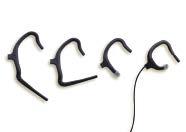



‘The increased use of stage lighting in the HOW market is making it harder and harder for projectors to be clearly visible,’ says Anthony Chiappone, product manager of the video/pixel division at Chauvet Professional. ‘This has created a number of challenges for systems integrators working at churches who must find the correct balance between bright projections and the cost of powerful projectors. The growing prevalence of stage lighting is also impacting the way integrators evaluate the merits of front and rear projection. Ideally, rear projection would be selected because it provides a much cleaner look, but installing it this way lowers the overall intensity. Therefore, many are choosing to go with front projection, which limits the location of the projection screen.’
different between LED and projection,’ explains Ruben Rengel, managing director of Absen Europe and Oceania. ‘LED brightness is measured in nits (direct light), while projector brightness is measured


in ANSI or centre lumens (reflected light), so people shouldn’t be mistaken by the lower rate in nits for an LED panel compared with the lumens of a projector. Brightness is arguably the biggest advantage of LED compared to projection.







Video projection requires a dark environment. Even with the use of a high brightness projector, the image brightness will only be as good as the environment’s low brightness. LED can cope with direct sunlight and display an excellent image. So, in


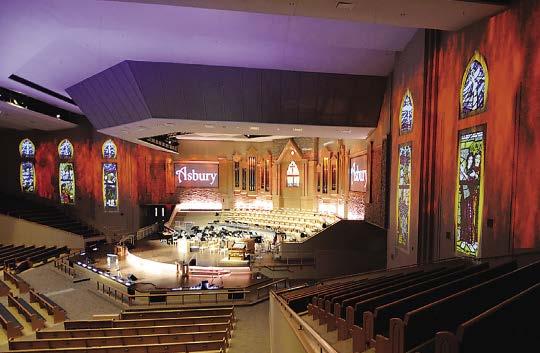
essence, the application will usually dictate the use of LED or video projection.’

‘LED videowalls are a very good answer to conditions in direct sunlight; however, their power consumption and cost per square metre can be expensive when compared to projectors, even more so when smaller pixel pitch is required,’ counters Mr Wadsworth. ‘A key development in the projector market is the race to even higher resolution and frame rate.’
Citing the recent launch of Digital Projection’s Insight 8K Laser projector, reportedly the world’s first 8K resolution DLP laser projector, Mr Wadsworth notes that ‘this added resolution also brings an unparalleled level of detail that wasn’t previously achievable via projection, one that is still a long way off with LED videowalls’.
The prices associated with LED technology have dropped in recent years, making it more accessible to houses of worship.
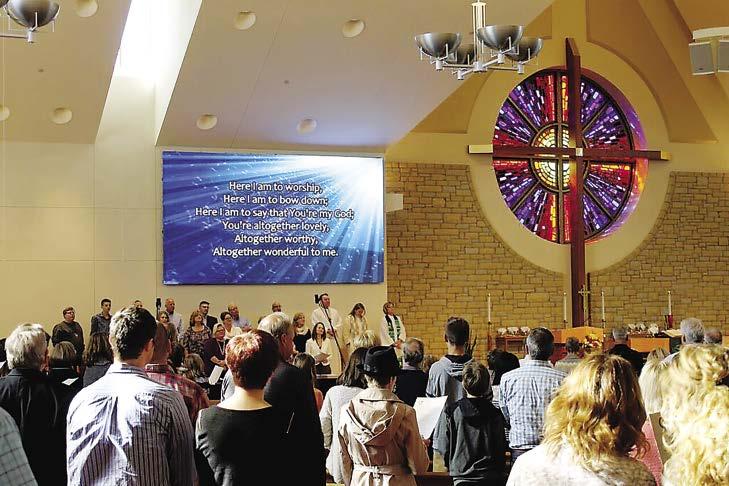
‘Our research has shown that the overall costs of LED video screens versus projectors are fairly similar,’ says Mr Chiappone. ‘However, in many instances a HOW might have to consider double- or triple-stacking projectors to achieve the desired brightness. This is when the costs of projection increases considerably. We have seen customers plan to combine 40K and 20K projectors, with a small amount of videowall to supplement the system. However, once they see the performance and the price tag for each technology, they convert their entire system to LED videowalls.’
‘Lamp replacement cost is basically none on an LED wall; pixels can go out and cost after a warranty period but, based on heavy use over five years and depending on projector size, a church can spend as much as US$2,500 to US$5,000 per year on maintenance on a projector,’ notes Mr Loader. ‘Video projectors also lose their light output very fast – typically after 1,500 hours you are only 70% of the output on large format projects. While the initial cost is more on LED displays, most of our customers have realised a break-even point in year two of the purchase.’
‘An LED videowall will be far easier to set up with minimal training, which will result in lower manpower costs,’ adds Mr Rengel. ‘In addition, the cost to maintain traditional projectors, such as lamps and filters, adds to the TCO [total cost of ownership].’
When it comes to saving money on projection, Mr Wadsworth points towards laser-illuminated projectors.
‘These offer many benefits over lampbased projectors, predominantly the ability to get up to 20,000 hours of illumination, thus negating the costly lamp-replacement cycle that often occurs every 1,000 to 2,000 hours, while providing a strong counterargument to the long life of LED panels when considering the TCO.’ That all said, prices of both projection systems and LED screens will vary. Remember that if you go for a projection system, you will also need a surface on which to beam your image, which also costs money.
‘There’s a big price difference on LED screens depending on which type of LED you choose, the processing of the LEDs and the mechanical design and serviceability,’ notes Mr Loader. ‘If you plan on broadcasting your worship service, make sure you buy an LED system capable of giving you the best image for broadcast with the highest refresh rates and colour balance/contrast available.’
‘While it is reasonable to expect the LED panel size and cost trends to continue, there are practical limits to how big they can get, how small the pixel pitch can be and how low the price can become,’ argues Mr Wadsworth. ‘A larger image area means larger panels which greatly impacts on the structure’s weight. Moving and mounting them into existing facilities is often not possible due to the design of the facility or manpower available.’
However, Mr Loader points out that ‘LED screens are modular, scalable and can be easily re-configured depending on design requirements of a system. On average, LED screens pull 50% real power versus projectors. LEDs only use the power
as content is given; projector lamps are always on and running, even when blacked out. The average lifespan of a projector is five years and LED video displays are 10 to 12 years on permanent installations, with regular maintenance required on both. Most LED videowalls are “too bright” for the application and are run at 20% to 30% output; therefore, the LEDs last even longer than their 50,000-hour rating.’
Christie, renowned for its projection technology, also produces LED screens. ‘LED offers a vivid, bright image even in higher ambient light or when the audience is off-axis. It can create “stadium-sized” images and it’s ideal for spaces where a projector can’t be hidden or obstructs sightlines,’ says Ted Romanowitz, senior product manager at Christie.
‘With LED screens, even the products on the market with the lowest intensity are still more than two times the output of a projector,’ claims Mr Chiappone. ‘Therefore, they can be placed almost anywhere on stage. A projector needs to be placed somewhere free from obstructions such as objects and people on the stage that could potentially block the output. Projectors have a large footprint on the stage when
can also have spatial issues when it comes to finding the correct front mounting location. On the other hand, many current LED videowalls are front serviceable, which means they can be mounted directly onto the wall, without needing space behind the screen for installation or
Mr Rengel brings NPP (narrow pixel pitch) LED technology into the argument: ‘Both projection and NPP displays can achieve a seamless image,’ he says. ‘Small pixel pitch LED displays have advantages in colour saturation, lifespan, postmaintenance requirements and ancillary equipment needs, and aren’t affected by specific environmental conditions. As a result, LED is now a serious contender for a variety of applications.’
‘Projectors also have the advantage of being able to display on irregular and complex surfaces,’ adds Mr Wadsworth. ‘If the application requires content displayed on a curved or irregular surface, flat panels and videowalls do not provide a suitable solution, while projectors equipped with warping capabilities can be “mapped” to nearly any surface geometry.’
When all is said and done, the choice between projector and LED screen will come down to a HOW’s specific needs. ‘The question of whether to select LED walls over projectors often simply comes down to the actual application,’ Mr Wadsworth concludes. ‘It is fair to say that while projectors and LED walls do compete in some applications, they happily co-exist and complement each other, each offering their own unique benefits.’
www.absen.com
www.chauvetprofessional.com
www.christiedigital.com
www.digitalprojection.com


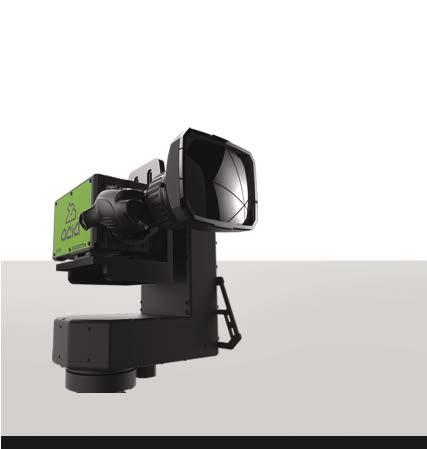





















using mics by even one then the
of sound quality are related to the
staple of the worship technician’s toolbox. Both are particularly applicable for mobile preachers who tend to move away from fixed microphone positions or expressive worship leaders who gesticulate a lot and are limited by handheld mics. While the use cases are clear, selecting between the options can be a challenge. The best way to navigate this process is to understand the differences between the styles of technology and where each option may be appropriate.
The most obvious difference between headsets and lavaliers is positioning. Headsets, as the name implies, see the microphone mounted on the wearer’s head and positioned near to the mouth whereas lavaliers are traditionally clipped to clothing. Aside from this, the major technical differences comes from the way the microphone captures sound.
‘It is the same capsule but the design is different,’ says DPA Microphones’ René Mørch. ‘On the lav, the capsule is mounted directly on a cable whereas the headset has the capsule mounted on a boom and a mechanical mount so that it can be mounted on the ears. Furthermore, a cardioid lav is mounted in a suspension mount to absorb shocks and vibrations that will affect the sound. The sensitivity is typically also different from a lav to a headset mic as there is approximately a 10dB difference in SPL between the two positions.’
‘The other difference is the consistency of the sound,’ notes
sits in the same place, close to the mouth, and will not change in volume or character when the wearer looks down to read or turns to look over a shoulder when referencing a slide or screen.’
This detail can be particularly important for worship applications.
‘In most faiths, the person wearing the mic has to be in several
polar pattern (omnidirectional versus directional),’ adds Shure’s Andrea Granata. ‘Some of the capsules are specifically tailored for vocal applications. After these the most important thing to consider is the position: from a sound perspective an omnidirectional headset would be my first choice in most cases if there are no issues having an evident microphone.’
Away from the technical side, there is one further difference that worship technicians should consider before making a purchase. ‘One of the main differences between the headworn and lavalier mics is actually the maintenance,’ says Audio-Technica’s Teng Shaokai. ‘As the headworn
advantages that each option provides in different situations. ‘The benefits of headset mics come from the positioning, it means there is no fluctuation in the audio level being picked up by the capsule,’ explains Mr Burr. ‘This means less strain on the engineer controlling the system and consistent gain levels, thus less
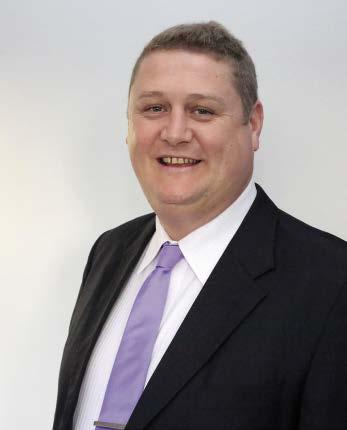

the users, it is easier for the mic to come into contact with perspiration, dirt or smaller particles. Hence, hygiene is always the top concern when using a headworn mic.’
With these differences in mind, there are a number of factors to consider when choosing between a headworn microphone and a lavalier. ‘Is there an issue with intelligibility or feedback in the space? If so, a headworn microphone will be a big step in the right direction as many HOW sound engineers tell us that moving from a lavalier to a headworn microphone was more
comb-filtre effects between the mics. It is important that the suspended mics do not just dangle downwards from their cable – you will need ceiling mounts that enable you to point the microphones at the ensemble. Please allow time for the microphone cables to ‘settle in’. As the cables were rolled up they will need some time to completely uncurl.
We want to create a design that will allow the audience to be involved and not just a spectator in worship. The lead singer may ask for participation during the chorus or the bridge of the song. With control of the house or audience lights we can make the audience part of what is happening on stage or create an atmosphere of deeper worship. Just remember we want to enhance not over power.
plenty of good reasons why lavaliers provide excellent results. Headset microphones are typically easier to setup as the mic is always going to be close to the source – the mouth. With the mic so close to the source you will get the best from your signal to noise ratio, as setting the gain correctly is not as difficult as it can be on a poorly placed lavalier.’
Can you use overheads to compensate for reverberation in any way?
Greg Persinger: First you have to be dedicated to the fact that worship is the primary focus and not a rock atmosphere. You have to be a worshiper. If you aren’t a worshiper you are never going to win your pastor over.
Sebastian Schmitz: overheads have been positioned correctly, they will pick up a large portion of direct sound. Via a suitable PA system this direct sound can be distributed within the auditorium and thus increase the direct sound for the listeners. The volume
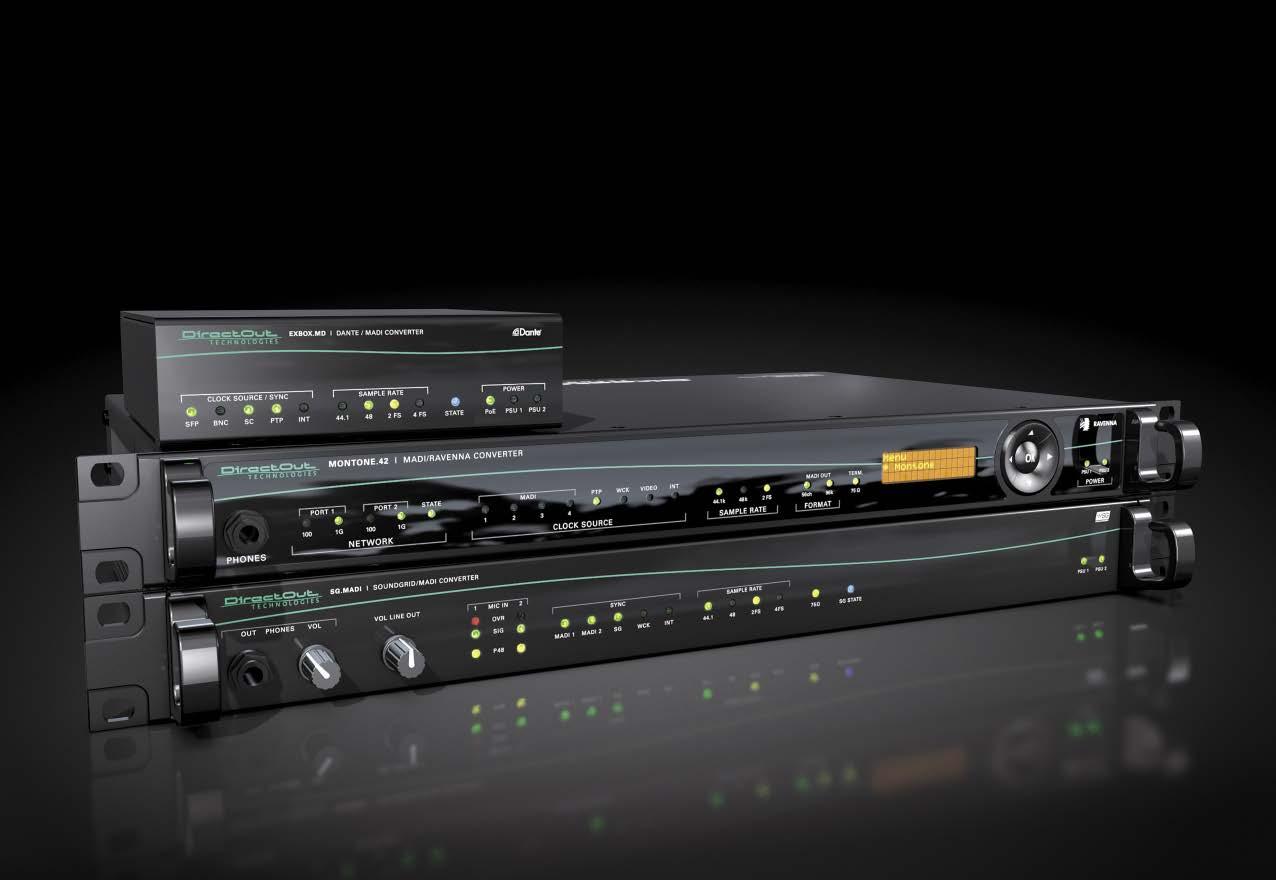
‘Headset microphones are easier to handle’, adds Sebastian Schmitz, product manager for microphones at Sennheiser in Germany. ‘They provide a much better feedback rejection than lavaliers because they can be positioned close to the mouth, which is a valuable asset in rooms with a public address system. Also, you will always have the same distance to the microphone and, therefore, no undesired changes in volume. Moreover, there is no noise from clothing when you’re moving, as may happen with lavaliers. A headset microphone with a cardioid pick-up pattern is the optimum hands-free solution for large venues with a PA system.’
‘My church often video records personal testimonies to play during the service,’ reveals Samson’s Mr Smith. ‘Using earset mics in personal recorded messages can be distracting for viewers, who are focusing on the face of the subject. Using a lavalier in a controlled environment such as an interview allows the tech to manage the level properly, as well as mic placement and other factors that are often more difficult in the live worship
(super-cardioid). They provide an extraordinarily high gain before feedback while giving a warm and clean sound. They also provide intimacy, in that they sound much closer to the singers and musicians than they actually are in overhead
‘Possibly the best benefit of lavaliers is that they are completely hidden,’ adds Mr Tolonen of Shure UK. ‘A headset is still visible and this could be an issue for a few reasons. First, the presenter simply may not like wearing a headset but, secondly, if the particular event is maybe televised or filmed, a lavalier provides an invisible option. You just need to make sure you choose the right lavalier and place it well to get the best out of it.’
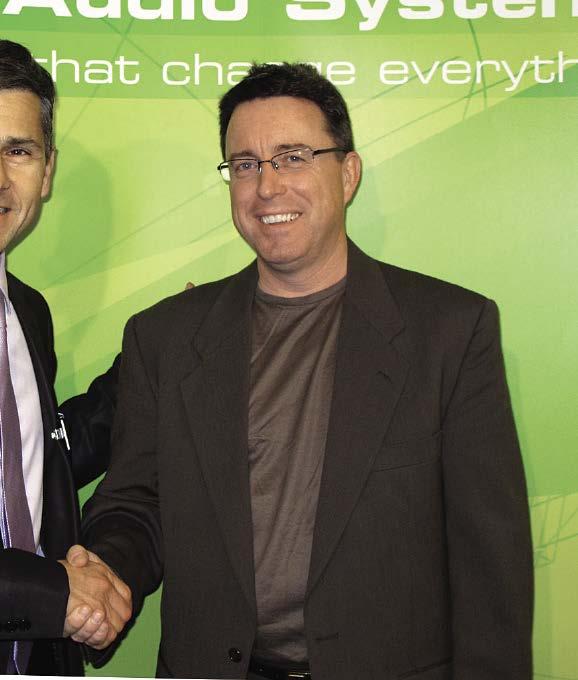
‘Actually I would only use a lavalier mic if the person feels


When the mics can be closer to the choir or the instruments, I would opt for the cardioid MKH 8040; when the mics need to be further away, I use the MKH 8050. It gives a powerful sound at longer distances. A colleague of mine recently had to mic a 150-person choir


Despite this chorus of approval for the headset, there are specific applications for which our experts
Worship, not lighting, should be the focus
pastor prefers a lavalier microphone, they should be advised to control head and body movement to avoid degrading the speech signal. A lavalier can be placed too low on the body, putting it out of pattern and increasing the opportunity to pick up body noise from garments and movement. Or, even if placed correctly, it can still fall out of

www.countryman.com

risk of feedback without the preacher having to shout.’

‘The position, much closer to the mouth of the speaker, allows a higher gain before feedback,’ agrees Mr Granata. ‘If there is sound reinforcement I would recommend always to use a microphone that is very close to the source of the sound to minimise the risk of feedback.’
‘Apart from the size of the microphones, where lavalier has the advantage of being smaller in overall dimensions, it is the various options of rigging and wearing
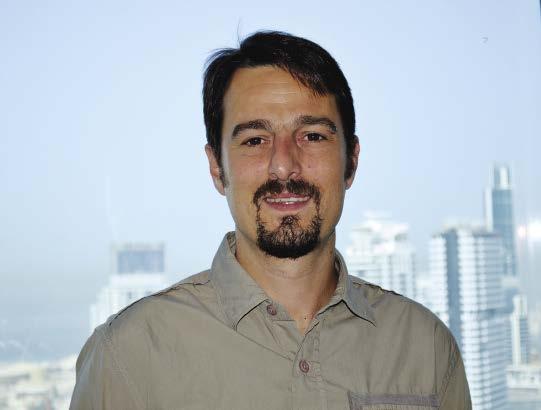
speaker or overhead, feedback may be a challenge. In those types of situations, getting the microphone an inch or two from the mouth can alleviate the problem of feedback or use a cardioid microphone that has a very tight pick-up pattern.’ What this all boils down to is identifying what the needs of the HOW are and assessing what the person conducting proceedings is comfortable with. Technicians have to weigh up whether or not the need for improved audio is going to have an impact on how proceedings are
the sound. Always bear in mind the applications and, when close miking for an instrument or other purposes, try to position the mic at various distances and observe the change. Of course, the room acoustics also play a significant role to the sound you want to pick up. Last but not least, hear it and listen to the result: if it suits you, you got it right and it doesn’t matter if you followed the
be found in the professional mic manufacturers’ specifications. If you
lavalier mics that makes them more interesting,’ states Mr Teng. ‘You can apply methods for outside clothing miking or under clothing miking and this gives a greater flexibility over headworn microphones. The accessories that come with lavalier microphones also allow you to be creative in your miking.’

‘Lavaliers typically have less hardware so are also much lighter weight and easier to handle,’ adds Yvonne Ho from Point Source Audio. ‘Ultra-low-profile lavaliers usually range between 3mm to 4mm and have the flexibility to be mounted just about anywhere so they are by far the most versatile type of mic available on the market. The biggest struggle for lapel worn mics is that when the head moves, the mic does not follow and, therefore, the voice signal can easily drop out of the pick-up pattern of the mic resulting in inconsistent vocal performance. To eliminate the “drop-out” concern when worn on the lapel, and to keep the mic within the pick-up pattern of the mouth, consider earmounting the lavalier.

‘Loudspeaker placement can have a very significant impact on the choice of microphone,’ she continues. ‘If the loudspeakers are behind the
worship should not feel constrained to a choice of one mic style or another but rather evaluate their wireless mic purchase as an investment in a selection of tools for the job,’ notes Ms Ho. ‘The HOW must evaluate what it needs based on what it wants to accomplish. Is the microphone only for the worship leaders or some for the choir and other performers? Is the mic dedicated to each user, or will it be shared? Then, of course, personal preferences (or personal style) can play a big factor in selecting the mic: facial hair, glasses or earrings can sometimes interfere with wearing a long boom microphone. If the microphone will be shared, then durability of the mic boom and cable will be very important. Finally, for critical live speaking, HOWs may want to consider double miking to provide microphone backup. In an example of choosing the right tools for the job, this scenario may call for a headworn mic as Mic A, and a lapel mic as Mic B.’
‘There is no one rule on how to purchase a mic,’ adds Mr Teng. ‘I would say one has to choose the right microphones that match the tonality of the source or instruments. Next, request a demonstration or evaluation of different types and brands of microphones to determine



The Nítid range from Amate expands from the stage to the ceiling with newly added line array components and a focus on integrated digital processing and instantaneous operation
DERIVED FROM the Latin word nitidus (bright) and nitere (to shine), Amate Audio has created the Nítid loudspeaker series for enhancing operational versatility with optimised plug-and-play setup and instantaneous operation. Following the recent launch of the Nítid stage monitors, the Barcelona-based manufacturer has extended its series roll-out with the addition of the N208 compact line array and N18W/ N218W subwoofer systems. Targeted for use in mid-sized installations and live event productions, the new additions combine the same digital amplification and signal processing technologies common to the existing Nítid designs.
The low-frequency section of the 2-way active N208 incorporates two direct radiating 8-inch loudspeakers each outfitted with a 2.5-inch voice coil and neodymium magnet. The HF/MF section comprises a 110° x 11° aluminium long-throw waveguide coupled with two 1.75-inch neodymium magnetic compression drivers. Designed in-house, the waveguide reportedly provides
consistent signal reproduction over a greater distance than normally associated with compact line arrays, thus enhancing the number of applications for which the system can be deployed.
N208 arrays are configured in coupled pairs of active and passive cabinets in the same manner as those developed for the flagship
X210 line array, while the active cabinet contains 1,500W Class-D amplification and DSP control for both units. With a custom rigging design and wide selection of optimised DSP control presets, near instantaneous deployment of the N208 is enabled.
Matched for use with the N208, the Nítid N18W and N218W subwoofers contain single and double direct radiating 18-inch woofers, respectively, within bass-reflex tuned enclosures. Both models are powered by Class-D 2,500W amplifiers and are equipped with dedicated DSP system control. A selection of presets configures the N18W and N218W for a wide range of applications, including various cardioid signal presets.
System control is accessed via the proprietary SensitiveTouch keypad technology, for which the LCD display is located on the rear-mounted control panel. The interface enables rapid setup and recall of multiple system parameters for which an on-screen output power display helps monitor the system and ECO
mode automatically powers down the amplifier in the absence of any signal. DSP control on the N208 includes a 5-band EQ menu with five equalisers, crossovers, delay, limiter, gain control, mute and input dynamic compressor. While selectable presets include dual, four and eight N208 units without and with subs, the cabinets’ custom rigging system and accessories cater to flying or stacking for deployment of the Nítid line array.
The polyurea-coated birch plywood cabinets incorporate ‘robust’ grilles and ergonomically designed handles. A range of accessories allow for flying and stacking of the N208, while the N18W and N218W subwoofers feature M6 rigging points together with M20 and M10 plate sockets for full-range enclosure coupling. Amate Audio’s universal switching mode power supply features on all three models providing 90% efficiency power supply to the amplifier circuitry with any mains condition between 85V and 265V AC.
NOVA’S NEW Pariz integrated sound reinforcement system has been designed for both basic setups, such as HOWs and much larger events and live shows thanks to the system’s ability to adapt to a large variety of applications.
The P9 line array module features a dipolar arrangement with two 8-inch neodymium transducers and a high precision 1.4-inch HF compression driver mounted onto a waveguide with 90° x 12° dispersion. The loudspeaker cabinet includes a passive 2-way crossover said to ensure high
efficiency in system cabling and amplifier configurations. The bassreflex ports reportedly eliminate side lobes, while the Extended Coverage Design is said to provide precise mid-range coverage. The V-arrangement of the two 8-inch transducers and the two additional side outlets extend the horizontal dispersion to 90° in the 700Hz to 1.1kHz frequency range.
The P18LEX is a cardioid subwoofer loaded with one long excursion 18-inch neodymium transducer and incorporates a Neck Coupling Reinforcement membrane
BOSE PROFESSIONAL has got singer-songwriters and musicians in its sights with the S1 Pro multiposition PA system. Described as an ‘all-in-one’ PA solution, the S1 serves as a portable PA, floor monitor, practice amplifier and primary music system, and draws on the technology developed for the L1 and F1 loudspeaker systems.

The multi-position system can be placed in one of four ways: tilted back, elevated, mounted on
stand or placed on its side as a floor monitor. The cabinet’s built-in sensors detect changes of position and trigger automatic EQ and recalibration of the system settings.

The S1 Pro has a 3-channel mixer with reverb and tone controls on two of the channels via XLR/¼-inch combo jacks, and a third channel for either 3.5mm line-in or wireless Bluetooth connectivity. Music can be played from Bluetooth-enabled devices via the wireless channel, which also facilitates integration with ToneMatch processing for microphones and instruments. Meanwhile, a line-out jack allows for the expansion to other
The S1 cabinet weighs 6.8kg with dimensions of 330mm x 241mm x 286mm. For users travelling with the S1, it is available with an optional rechargeable lithium-ion battery and the system settings offer a choice between trickle charge or dedicated full-power
for a power capacity of 1,600W. Tuned for low frequencies of 27Hz, the speaker’s double flared bass-
reflex port reportedly reduces noise from airflow down to a minimum.
The optional 2-point rigging hardware is recessed into the cabinet’s enclosure, and enables the P18LEX to be flown in a column of subwoofers or at the top of a P9 line array module.
Finally, the TX20 is a 4-channel power amplifier said to offer a combination of power and audio performance combined with DSP and network control. The TX20 delivers 5,000W per channel or 10,000W for a bridged pair. The amp uses drive module presets, which are defined as the number of outputs driven from one DSP unit. The drive modules also allow for a less processor-centric and more speaker-oriented system design, according to the manufacturer. Up to 50 drive module presets are permanently stored inside the TX20 even if the TX20 is not being used with the Nova.Net software.
www.novacoustic.com
JBL PROFESSIONAL has added the VTX A12W line array loudspeaker to its VTX A range, featuring a 120° dispersion pattern for wide horizontal coverage. The Harman brand is targeting mid- to largesized productions and high-end fixed installations, such as houses of worship and live performance venues, with the VTX A12W.
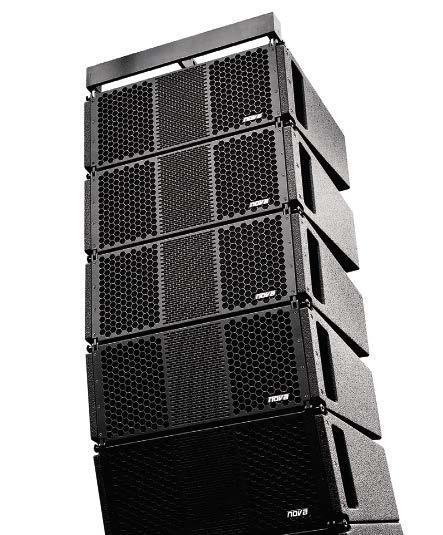
When combined with a VTX A12 system in the lower part of a line array, the VTX A12W provides a wider pattern that reportedly helps balance coverage closer to the audience. The A12W is built with many of the same components as the A12 and includes the same low-, mid- and highfrequency sections. The difference comes with the redesigned Radiation Boundary Integrator for reduced horn edge diffraction, improved LF sensitivity, lower distortion and 120° directivity down to 250Hz. The HF section integrates a phasing plug and waveguide for high sensitivity and linearity to suit high output levels, while the LF section includes Differential Drive woofers, with a dual magnet, dual voice-coil design for extended linear excursion.

The A12W is constructed with a full-face grill design, available in an array of colours, that reduces the number of exposed components,
protecting them from all manner of environmental elements and achieving an IP55 rating. JBL has manufactured the cabinet to be lightweight and easy to rig.
www.jblpro.com
AESTHETICALLY DESIGNED for indoor or outdoor applications, Community has expanded its I Series family with the addition of the IV6 Modular Vertical Array 600 system. The scalable, adaptive array features wide-dispersion IV6-1122 loudspeaker 12-inch elements that are available in both 5° and 15° vertical coverage versions. While maintaining the best qualities of long-throw line arrays, the IV6 offers up to 5° of splay between elements, thus eliminating excessive overlap or coverage gaps to overcome the physical limitations and acoustical
tuning difficulties of conventional line arrays.
single 18-inch IV6-118S subwoofer can be flown above or behind any array for low-frequency extension.
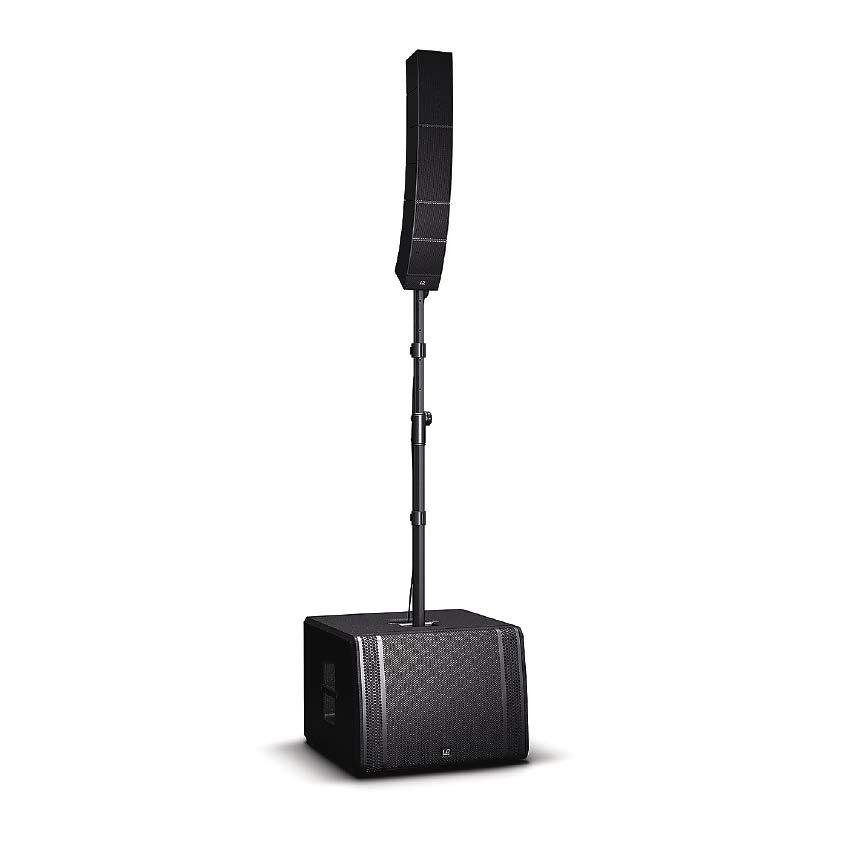
loudspeaker, integrated Passive Acoustic Optimisation (PAO) settings allow up to 55 different frequency response profiles to be independently selected for each element in the array, bypassing the requirement for additional amplifiers or DSP channels. Furthermore,
module included within EASE Focus 3 software calculates the ideal PAO
NEXT-PROAUDIO HAS unveiled the Matrix Series of passive column arrays aimed at installed and small, portable applications. With a chassis of aluminium and wood, the cabinets are described as ‘stylish and yet sturdy’ and designed for architectural integration.
The Matrix Series initially comprises two models: the Matrix M8 and the Matrix M3,
respectively. Built to offer a ‘high intelligibility at high SPL’ and ‘wider frequency response while providing constant beam-width over a user selectable vertical coverage’, the Matrix columns provide beam control that reportedly extends up to 10kHz.

In addition, the manufacturer has developed what it coins as ‘Tuned Dipolar Technology’, which promises ‘consistent low frequency
LD SYSTEMS has increased the specifications of its Curv 500 series with the release of the Curv 500 TS Touring Array

a Neutrik powerCON socket reportedly ensures a stable mains power supply.
Users are able to choose between
intended to give a flat, balanced frequency response, while Vocal mode adds a mid-range presence
Another choice presented to users is the ability to switch the vertical dispersion pattern between wide or
The internal processing board at the heart of the M3 and M8 column arrays handles array optimisation, allowing users to adjust the system requirements. Adding to the ease
a wall in architectural integrated input screw connector simplifies
sockets are available, while


The ARRI SkyPanel is a compact, ultra-bright and high-quality LED soft light that sets a new standard for the industry. Because different application areas call for different lighting needs, SkyPanel has been designed as a family of fixtures. The mid-range S60, the smaller and more portable S30, the long aperture S120, and the new S360 fills out the family with the largest aperture and a brightness four times that of the S60.
Explore
Tel. +852 2571 6288
Fax. +852 2875 9181
info@arri.asia


A SELF-POWERED version of its 1.5AM monitor, Clair Brothers’ 1.5AM+ is the latest addition to the company’s One Series of coaxial stage monitors. The 1.5AM+ has been designed for vocal monitoring and on-stage instrument reinforcement (drum fill, bass and keyboard monitors) and particularly for DJ/EDM monitors.
ONE OF the highlights of the Version 7 release of Yamaha’s CL StageMix and QL StageMix iPad applications is the addition of control and monitoring support for Shure wireless receivers that are not Dante compatible.
The units covered by this upgrade are Shure’s AXT400, QLXD4 and ULXD4. ‘By providing CL and QL StageMix control and monitoring capability for Shure network wireless products, including the Axient, QLXD4 and ULXD4 receivers, the benefits of those products become available to a wider spectrum of users,’ said Rob Fuhlbrugge, senior director of engineering and product development at Shure.
Away from the Shure side of things, with Version 7, both CL StageMix and QL StageMix acquire a new ‘Custom’ meter area and
what Yamaha describes as a more flexible fader area layout capability. The input patching function added in Version 6 has been expanded to include a multichannel input patch function that allows multiple consecutive input channels to be patched as a group.
www.shure.com
www.yamahaproaudio.com
EVOLUTION WIRELESS G4 from Sennheiser comes with a new user interface, an expanded switching bandwidth and higher RF output power for the 300 and 500 series, multichannel functionality for the 100 series and new on-camera systems. The microphone has been developed for musical performances, such as in HOWs. Based on its predecessor, the G3, Sennheiser has added new professional sets for ENG and film work in the 500 series, three base sets in the 300 series, plus upgraded vocal sets and a combo set in the 100 series.
The 100 G4 series comprises the vocal sets that include the capsules of the evolution e 835, e 845, e 865, e 935 and e 945


The monitor provides internal, factory-programmed DSP loudspeaker processing to give users Xover, EQ, Limiter and four preset options. The first two presets are 12AM Emulation Mode options (32dB gain or 38dB gain) that provide similar frequency response voicing and low-frequency phase response. The third preset, ‘Mon A’, offers a 2-way phase versus frequency
characteristic, while the fourth, ‘Mon B’, acts as an all-pass filter that aligns the low-frequency phase response with subwoofers. Like its predecessor, the 1.5AM+ contains a lightweight Powersoft amplifier module that allows users to power a passive 1.5AM with a slave output. The 1.5AM+ can be connected to a non-powered 1.5AM by a cable to create a mono configuration. The 1.5AM+ offers a coaxial design and a high-frequency rotatable horn (40°H x 60°V standard dispersion) made from Baltic birch. The horn includes wooden acoustic filters that reportedly optimise the magnitude and phase response between the coaxial components.
www.clairbrothers.com
microphones.
Also available are an instrument set, a headmic set and two lavalier sets with either the ME 2-II (omni) or ME 4 (cardioid). Up to 12 wireless systems can now be daisy-chained for simultaneous programming via an enhanced

‘Easy Set-up’ function. The ew G4 500 series reportedly provides an expanded feature set, greater range, more spectrum flexibility and the additional control options offered by the Wireless Systems Manager software. Available
systems include vocal sets with e 935, e 945 and e 965 capsules, an instrument set, a lavalier set with professional MKE 2 clip-on, as well as individual receiver and transmitter units. The switching bandwidth of the series has been expanded to rival Sennheiser’s professional 2000 series, with bandwidths of up to 88MHz and up to 32 channels. The RF output power has been increased to 50mW, switchable in three steps (10mW, 30mW and 50mW) to expand transmission range or adjust to difficult RF environments, and all bodypacks feature increased protection from humidity and moisture.
www.sennheiser.com
FOLLOWING REQUESTS from its customers, Audix has released white versions of its MicroBoom carbon fibre boom system for miking choirs and instruments. Ideal for HOWs and education
power adapter. The MicroBoom system is compatible with the manufacturer’s miniature condenser microphone series, the Micros, with integrated preamp and detachable cable. Available enabled models are also available www.audixusa.com
MIPRO HAS released the MR-24 digital wireless pedal receiver, a product that is compatible with its ACT-2400 Series and that the manufacturer claims
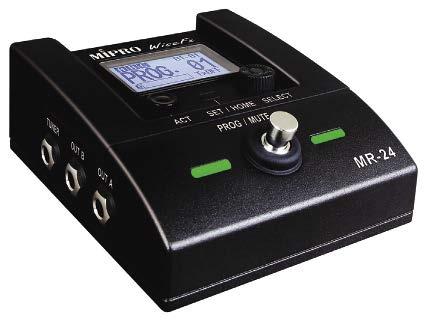
effects. The MR-24 is contained in a metal case and has a large graphic LCD screen and a built-in antenna – with a specific structure designed to prevent accidental breakage – as well as an ergonomic footswitch. The performer only needs to plug an MT-24 digital transmitter to the output jack of the instrument to replace the cable.
is ideal for musicians wanting an easy and quick setup for live stage applications, such as those common in HOW scenarios.
Performances by musicians are sometimes hampered by traditional wireless systems that have struggled to completely replace wired systems. The new pedal receiver seeks to give performers more freedom as well as convenience in playing and adjusting their sound
AUDIO-TECHNICA HAS launched the third and fourth generations of its 5000 and 3000 Series, respectively. The 5000 Series dual receiver has been updated with a tuning bandwidth from 470MHz to 700MHz and users now have the option of selecting a standard receiver with two balanced XLR outputs or a receiver that also includes a Dante output. The fullrack receiver chassis holds two independent receivers and offers antenna power, frequency scan, IR sync functionality, a ground-lift switch and a front panel headphone jack.
Other new features include an antenna cascade output that connects up to eight receivers so a single pair of antennas can feed up to 16 channels of wireless; an auto squelch feature that automatically adjusts the squelch setting to

maximise operating range while minimising potential interference; and a backup frequency that can be swapped by pressing the transmitter’s multi-function button in the event of unexpected interference.
Two transmitters are available for use with the 5000 Series: the
ATW-T5201 bodypack transmitter and the ATW-T5202 handheld transmitter. They are available in two different frequency ranges: DE1 (470MHz to 590MHz) and EG1 (580MHz to 700MHz). The compact ATW-T5201 is equipped with the manufacturer’s new cH-style, screw-down, 4-pin
Mipro also claims that the new design aims to eliminate outside interference and distortion. The Proprietary 3D diversity technology and 64 ID settings are installed with the aim of avoiding interference from Wi-Fi and 2.4GHz communication products. The digital wireless system also prevents distortion caused by an analogue system while the balanced output jack with ground lift switch for PA system connection is said to eliminate electrical noise.
www.mipro.com.tw
connector, while the ATW-T5202 offers ‘extremely low handling noise’ and includes a high-pass filter.
The new 3000 Series systems are available in four frequency bands: DE2 (470MHz to 530MHz), EE1 (530MHz to 590MHz), EF1 (590MHz to 650MHz) and FG1 (650MHz to 700MHz). Frequencies can be scanned and selected on the receiver and synced with the transmitter via IR sync functionality.
System configurations feature an ATW-R3210 receiver along with an ATW-T3201 bodypack or ATW-T3202 handheld transmitter. The ATW-T3201 is also equipped with the cH-style, screw-down, 4-pin connector, while the ATW-T3202 comes with either an ATW-C510 dynamic or ATW-C710 condenser interchangeable cardioid capsule.
www.audio-technica.com


SHURE HAS updated three models in its SE Sound Isolating in-ear monitor series with wireless connectivity via a Bluetooth cable – that is, a cable with a Bluetooth transmitter in the middle that serves to link the individual earphones to their counterpart. For those users still preferring a more traditional wired connection, the manufacturer has also introduced the new Universal 3.5mm Earphone Communication Cable (RMCE-UNI) with selectable Android and iOS capability. Featuring an integrated mic and 3-button remote, the RMCE-UNI lets users take calls, control music and activate voice commands, as well as switch between Apple iOS or Android/USB connection. Additionally, another optional earphone cable will soon be available for Android users – the USB–C Earphone Communication
KLANG:TECHNOLOGIES HAS
added parametric EQ to its 3D in-ear mixing system with the release of KOS 3. Parametric EQ provides the equalisation of each input signal when no dedicated monitor console is available. The Klang presets and fine tuning with root intensity reportedly allow users to gradually blend in the tone signature of the EQ, and even invert it. The pitch of the tonal characteristic can be adjusted. Other new features include an output mix EQ with presets and output phase invert. In the Channels Setting View, a channel can be assigned to one of up to six groups, shown with their respective colour and icon. Users can also assign a group colour to all group member channels.
Cable (RMCE-USB) – which houses an integrated DAC/amp, microphone and controls that work with all Shure SE Sound Isolating Earphones with detachable cables.
The three new models that work with the detachable Bluetooth and
WITH THE release of Dante firmware v4.0 for the Brooklyn II audio networking module, Audinate has provided critical support for Dante Domain Manager (DDM) together with performance improvements and bug fixes. As a key component in the Dante 4.0 system update, Brooklyn II v4.0 will implement DDM support across the Dante ecosystem, allowing only those products updated with the v4.0 firmware to fully participate in Dante domains.
DDM brings new functionality to Dante networks including user authentication, role-based security and audit capabilities, while allowing almost unlimited expansion and organisation of Dante systems over any network topology.

Meanwhile, Audinate has released a soft IP solution entitled Dante IP Core, said to allow OEMs working with FPGA-based designs to add Dante connectivity to A/V products at a ‘lower cost and with
Fix-i3D button. This provides users with the possibility of locking the objects on the outer orbit from spinning and placing sound sources more easily.
The Compact Device List View feature is for users working with more than one Klang device, while the Solo-Link in the Stage View means that when channels are soloed in the Fader View, the Stage View will focus those channels like a group. The Snapshot Control Everywhere feature means users do not need to switch between menus to recall, fire or save a snapshot.
www.klang.com
greater flexibility than ever before’. Dante IP Core runs alongside OEM product applications such as ASRC, audio encryption and signal processing on a range of Xilinx FPGAs, reportedly providing channel counts up to 512x512 with low-latency and sub-microsecond synchronisation. The solution also incorporates SiLabs clock synthesis, serial and parallel audio, DDR2, SRAM and a variety of standard control interfaces including UART, SPI and I2C.
www.audinate.com
a dry acoustic space more lively to facilitate natural spoken word reproduction.
ACOUSTIC SPECIALIST Wenger has recently partnered with Harman on the development of two new acoustic systems for performance venues to improve what musicians and singers can hear on stage as well as the acoustic options for facility managers seeking a more multipurpose venue. The Virtuoso and Transcend Acoustical Shells pair a Wenger processer with Lexicon’s active acoustic system technology to artificially manipulate the natural reflections and acoustics of a given space, for example, making a reverberant church sound more dead to accommodate modern musical performances or making
The Virtuoso system has been designed for those venues that lack the stage area storage space to accommodate a full, passive shell, are unable to support a hanging structure from their ceiling or lack the resources to set up and remove a shell onstage. Its focus is on improving the acoustics onstage for musicians, enabling them to hear themselves better and ultimately deliver a better performance. The Transcend system extends the same techniques out into the rest of the venue, with the two systems together creating a malleable acoustic space able to stretch from back of house to front encompassing the entire area.
The manufacturer promises the need for fewer microphones and speakers to provide a ‘more reliable and stable’ system.

www.wengercorp.com

WITH A 25,000-lumen output in a chassis weighing 12kg, Cineo Lighting’s latest Standard 410 for motion picture, television and episodic lighting is described by the company as being substantially lower in price than other fixtures in its class.

The S410 has been especially designed for lighting talent, sets and creating saturated colour effects. It has a 30cm x 60cm diffused illuminating surface and a high-CRI tunable white light in a compact size together with a full RGB lighting system. The 4-channel

DESIGNED FOR highlighting or outlining buildings and other objects with video and media-style effects, ArcLine Outdoor direct view pixel from Anolis is available in a variety of lengths that are reportedly quick to daisy-chain. The light incorporates an RGB multichip and the company’s colour mixing is said to produce a rich array of colours and streamlined transitions.
ArcPix, meanwhile, is a compact RGB LED multichip node reportedly offering versatility and scope to create kinetic and visual effects

both outdoors and indoors. The light incorporates plug-and-play electronics and a variety of mapping and media effects. According to Anolis, a single power supply can
FIILEX HAS updated its P360 lighting fixture for the LED generation with the release of the P360 Classic. The P360 Classic brings several new features and is compatible with a wide range of the manufacturer’s existing accessories. Its design has been slightly modified from the original P360.
The P360 Classic is reportedly capable of dimming to its lowest power settings without any flickering or colour shifts. It is built to maintain ‘extremely accurate colour’ throughout its extended CCT range. The LED element is
significantly brighter than previous P360 fixtures, yet draws on the same amount of power at 90W. An extended yoke and spigot enable users of the P360 Classic to manipulate the softbox and Fresnel attachments with greater ease than past P360 models, while a new

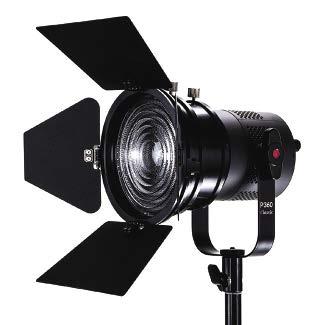
THE NEW MagicQ Stadium Wing from ChamSys has been developed to meet the expectations of lighting designers in providing high-level show control from a compact package. With its display capable of connecting directly to the DVI output of any MagicQ MQ500 or MagicQ MQ80 consoles, any MagicQ Window can be transferred to the display
on the Stadium Wing, which also features 30 playbacks, four execute encoders and a full HD multi-touch display with adjustable viewing angle and gesture support.
Furthermore, the manufacturer states that the 30 playbacks are pageable as 15 fader playbacks
accessory lock keeps them secure. Existing Fiilex accessories that are compatible include diffusers and gel holders, larger softboxes and the 5-inch Zoom Fresnel attachment that is said to increase beam intensity by up to 800%.
Making use of the manufacturer’s Dense Matrix LED array, combining multiple custommanufactured LED chips within a single glass optic, the P360 Classic has a compact form factor, better facilitating portability along with various optional travel kits.
fiilex.com
interface provides control locally via a graphical control panel, through traditional wired DMX or with the
CHURCHES AND other mid-sized venues are the target audience for Chauvet’s Ovation SP-300CW, a followspot powered by a 260W, 5,500K cool white LED engine that offers a 10° to 20° zoom. The light features a fully closeable iris to allow more precise lighting control, onboard linear dimming, manual sliders for zoom and a focus that optimises its spotlight for throw distances of 15m to 30m.
The 6-slot manual boomerang in front of the light source allows users to add gels for quick colour changes. The 2,300Hz PWM frequency reportedly results in flicker-free operation for video applications, while the light provides an illuminance rating from 7,330 to 17,296 lux at 5m depending on the zoom angle.
and 15 execute playbacks, while the four execute encoders are multipurpose and can be assigned functions from the Execute and other MagicQ Windows. The unit also houses four DMX outputs.
secure.chamsys.co.uk
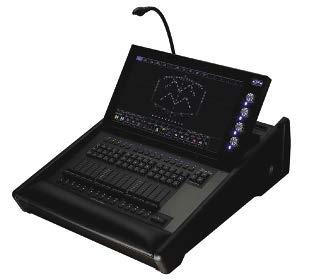
ELATION’S ARENA series of RGBW PAR lights is stepping outside with the addition of the IP65-rated Arena Zoom Q7 IP. Designed as a key light, front light or as a general light on indoor or outdoor stages, the Arena Zoom Q7 IP is a full-colour mixing wash luminaire that can also fit into a standard 12-inch truss, making it suitable as a truss warmer/ highlighter.
The luminaire houses seven 30W Osram Quad-Color RGBW LEDs that give a selection of saturated colour options including a genuine white, while a choice of colour macros and variable speed macros reportedly enable fast programming. The luminaire features a bright and well-defined beam, and the colour temperature is from 3,200K to 10,000K. The fixture also includes RGB white balance calibration, allowing users to adjust the maximum RGB values in order to set the white colour temperature default level.
Further features include a 7° to 40° motorised zoom, over 3,000 lumens

of output and a total maximum power consumption of 250W. The luminaire is controllable via six DMX channel modes (12 total channels) and is Remote Device Management ready. An auto-sensing power supply covers worldwide voltages and frequencies. Elation has also added three lighting control products. 4Cast DMX Bridge is a compact 4-universe wireless device that bridges Wi-Fi, Art-Net, sACN and E-FLY (Elation’s wireless DMX solution) signals to
wirelessly control compatible DMX devices. The 4Cast DMX Bridge creates a private, standalone 2.4GHz DSSS (Direct Sequence Spread Spectrum) Wi-Fi network, which coexists in busy RF environments alongside other wireless technologies.

eNode2 POE is a compact 2-universe Ethernet-DMX node powered over Ethernet that supports Art-Net compatible DMX control systems using a single RJ-45 auto-switching 10/100Mbps Neutrik etherCON input and two multi-configuration 5-pin Neutrik DMX data outputs. Features include DMX bilateral conversion support, a 4-button control panel, an OLED system menu display and three LED status indicators.
Finally, the IPC415 is a DMX power control centre featuring four powerCON outputs (15A maximum each), four 5-pin XLR DMX outputs, one 5-pin XLR DMX input and one 5-pin XLR DMX thru-put. The IPC415 can be mounted in a standard 19inch rack space using the included rack ears, or truss mounted using a clamp (not included) attached to the M10 rigging point in the centre of the unit. It includes a multi-voltage universal auto-switching power supply.
www.elationlighting.com
A NEW ‘low-cost’ studio solution has been announced by JVC
Professional that pairs its Ky-PZ100 robotic production cameras with Roland’s V-1SDI 3G-SDI video switcher.
‘Not everyone needs or can even accommodate a full-sized control room,’ explained JVC’s Craig Yanagi. ‘Our solution is ideal for tight spaces and tight budgets. It supports multiple cameras that can be permanently mounted or
used on tripods and controlled by one operator. For many houses of worship and other live productions, it’s all you really need.’
COMBINING THE power of its XS AV Matrix Series with the size and features of the V-1 video switchers series, Roland’s XS-1HD is a small footprint, multi-format matrix switcher with multi-screen output destinations for confidence monitor, main and side screens, and overflow rooms. The unit supports full HD, including keying and picture-inpicture (PiP) effects, and also has four HDMI inputs with scalers and scaled outputs. It accepts signals from a variety of sources such as cameras and computers, making

it ideal for worship applications. Frame synchronisation and scaling are provided on all inputs.
The 4:4:4/10-bit processing accommodates resolutions up to WUXGA/1080p. In addition to matrix switching, a split mode allows up to three inset windows to be composited into a background video for PiP applications, while switcher mode provides seamless transitions between videos, or PiP or key-compositing, with multiview preview for real-time operation. Event setups can be recalled from scene
Roland’s V-1SDI 3G-SDI video switchers allow users to connect and switch professional 3G-SDI cameras and playback sources
as well as HDMI sources including cameras, smart phones, computers, tablets and Blu-ray players. For control, the hardware interface houses a T-Fader. The switcher can also send Tally commands via RS-232 through the JVC RM-LP100 remote camera controller, further expanding the system’s functionality.

proav.roland.com
pro.jvc.com
memories, and the USB memory stores switcher settings as well as still images.
Two channels of line level audio I/Os are provided through RCA jacks. Audio can be mixed internally with HDMI audio via the built-in mixer, while audio embedding and de-embedding is also supported,

with delay control for lip-sync adjustments.
For installed use, the device supports HDCP video signals, RS-232 for controls from PC or touch panels, and EDID to auto-configure output resolutions in smart displays.
proav.roland.com
DESIGNED TO enable faster set up time, lower maintenance requirements and a lower total cost of ownership, AV Stumpfl has created a prototype projection accessory for its entire 32mm screen systems. Christened the T-32 Shift, the projection screen leg allows one person to easily adjust the mobile projection height without having to disassemble it first.

The Austrian A/V technology manufacturer has also made the Wings Vioso RX 2.0 software available for download. A key feature of this release is a HotBackup option that allows users to specify hot backup clients for multiple playout clients. By acquiring all the information needed to replace the playout client during playback, all necessary media files are also copied to the hot backup client. In the event that the playout client fails, the hot backup client replaces the playout client without the need to edit IP addresses.
www.avstumpfl.com
DESIGNED FOR rental, staging and fixed installation applications, Christie Digital has added the Crimson Series of 3DLP laser phosphor projectors to its catalogue. Capable of delivering up to 25,000 ISO lumens for up to 20,000 hours of light with 60Hz processing, the Crimson Series incorporates BoldColor Technology, TruLife Electronics for ultra-fast processing and Christie Twist warp and blend capabilities. With the addition of Christie Mystique, multiple projector calibration times can be reduced to save both time and set up costs. Housed in a compact form factor almost identical to the Christie Boxer chassis, the latest 3DLP laser phosphor projectors come with an IP5X sealed, solid-state laser light source and provide quiet operation and 360° orientation.

DIGITAL PROJECTION has introduced what it describes as the first ever commercially available 8K DLP laser projector along with a new 2D and 3D LED display solution.

The Insight Dual Laser 8K projector promises to offer ‘the ultimate solution for the most elaborate and immersive visualisation in large-venue applications’, while the Radiance LED offers fine-pitch solutions displaying bright and vivid imagery ‘thanks to a broad dynamic range and high colour bit-depth’.
The new Dual Laser Projector 8K resolution (7680x4320) performance equates to 33 million pixels and 25,000 ANSI lumens of solid-state, laser phosphor illumination. In addition to the resolution and lumen performance, it uses proven DLP technology incorporating 3x1.38 DarkChip, DMD chips and Digital Projection’s ColorMax technology. These are reportedly vital imaging characteristics when matching projectors in tiled or blended applications.

Lamp replacements are never required due to the solid-state laser illumination system. Other features include the simplification of blending multiple projectors, as laser projectors are closely matched ‘out of the box’ for colour and brightness. It also features MultiAxis orientation capability of portrait or landscape use and every angle in between, and there are optional high-performance lenses.
Meanwhile, Digital Projection’s new 2D and 3D LED videowall offers a full HD 1080p imagery and ultra-HD 4K for various installations including houses of worship as well as rental entertainment applications.
It is built on a native 16:9 aspect ratio and there are four models to choose from (Radiance LED 1.2, 1.5, 1.9 and 2.5). The new Black SMD LED range offers up to 1,000 nits of brightness, a contrast ratio of 3,000:1 and a 120Hz refresh rate. The lifetime span is rated at 50,000 hours. The wall solutions also provide a 160° viewing angle
For 3D visualisation or simulation applications, the Mirage HD25 and Mirage WU25 projectors offer higher frame rates and up to 120Hz processing. Existing Christie M Series and Christie J Series customers can upgrade to the WU25 and HD25 models without needing new lenses. The manufacturer is expanding its D Series line-up with three new singlelamp models, which are available with up to 8,100 ISO lumens and both WUXGA and HD resolutions. The projectors offer 65,000:1 contrast ratio, 3,000 hours of lamp life and simplified integration. Reportedly offering high brightness at roughly half the cost of competitive laser phosphor units, the LWU720i-D, LWU620i-D and LHD720i-D projectors have been designed as an alternative.
www.christiedigital.com
and a fanless panel design.
Radiance LED walls are also rated for 24/7 operation and can be configured with power and signal redundancy for mission critical applications. Each panel is frontservice accessible. This makes it possible to service any panel within the display without disrupting the alignment of any other panel. www.digitalprojection.com
FOLLOWING THE acquisition of Picturall, Analog Way has introduced a range of media servers based on the Picturall Linux software engine. With resolutions up to 8K, uncompressed playback and the ability to drive a large number of 4K@60 projectors or LED processors from a single server unit, the Picturall series has been designed for corporate events, live shows, high-end theatre productions or large-scale digital signage projects. The models include the Picturall Uncompressed
Pro LE, Pro, Twin and Quad. The manufacturer has also unveiled its Ascender 48 – 4K –PL, described as a high-end 4K seamless switcher designed for staging and systems integration. Forming part of Analog Way’s LiveCore series, the switcher features 4K live processing, seamless switching on all layers and a web-based user interface. It has 12 inputs, four outputs and one multi-viewer, 48 scalers and six true-seamless scaled layers, plus a native background layer per output.
Analog Way has also added HDBaseT support to its QuickMatriX – H, Pulse2 – H, SmartMatriX2 – H and Saphyr – H switchers that form part of the manufacturer’s Midra series. The models offer up to 10 seamless inputs, including two or four HDBaseT inputs supporting
inputs also support PoE+. The switchers also include two outputs with mirrored HDMI and HDBaseT connectors. Other features include real-time, ultra-low latency image processing, true seamless switching, advanced audio management and a drag-and-drop GUI.
www.analogway.com
between the unit’s two inputs as well as powering up compatible displays when a presentation device
is connected. Input switching, audio volume and display power can also be controlled via RS-232 or TCP/

RX is the manufacturer’s first HDBaseT receiver to incorporate its CrystalScale Technology (ACT).
The HDVS-SC-RX has many of the features from its 1080p-only predecessor, the HDVS-200-RX, including image adjustment capability, audio de-embedding and the ability to match incoming signals to the display’s native resolution. ACT is a core signal processing engine that reportedly optimises image quality and switching performance. It supports mirror/flip and 90° image rotation, motion-adaptive video de-interlacing, 3:2 pull-down, aspect ratio control and internal test pattern generation. The receiver also has a second HDMI input, allowing additional content from a local computer or wireless base.
www.atlona.com
ROSS VIDEO hopes to provide broadcasters with a progressive growth path to IP focusing on transport-agnostic solutions with the release of its Software Defined Production (SDP) Ecosystem. The new family of products allows broadcasters to choose the method of transport that is most appropriate for their project and offers myriad adaptability and scalability options. The SDP setup seeks to facilitate workflows with fewer pieces of equipment by offering multi-purpose tools that can be used flexibly to meet particular needs on-demand, rather than a single function.
The family comprises the Newt point-of-use IP signal converters and the Raptor Edge openGear module, high-density IP gateway, both of which are AIMS-compliant, as well as the Gator UHD-capable

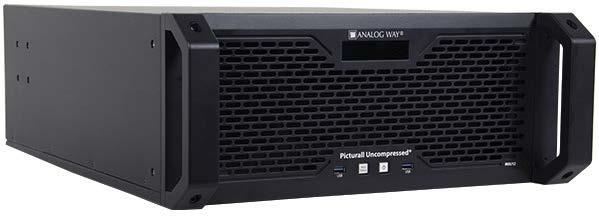
signal processing modules, the Ultrix processing platform, the XPression family of real-time motion graphics systems and the DashBoard control and monitoring ecosystem. In addition, the Bach OEM module and Swift SMPTE ST 2110 system-on-chip from Coveloz are included in the SDP
family, as are Ross’ new AcuityIP and CarboniteIP production switchers.

AcuityIP and CarboniteIP are new native IP versions of the Acuity and mid-sized Carbonite Black production switchers. With the ability to interface with standards-based SMPTE ST 2110 and ST 2022-6
infrastructures, they are able to connect to COTS IP solutions via standard 10GbE SFP+ interfaces with integrated discovery and registration of streams using open control protocols including NMOS, EmBER+ and DashBoard. An optional aggregation switch connects 40GbE or 100GbE interfaces to a core or spine switch.
‘AcuityIP and CarboniteIP retain all the I/O processing features of their SDI family members,’ noted Nigel Spratling, director of production switchers and video servers at Ross Video. ‘Users are able to mix and match IP and SDI interfaces, so each switcher may be used to connect directly to legacy SDI equipment as required, making them ideal for hybrid installations.’
www.rossvideo.com
PROVIDING CONNECTIVITY, performance and reliability for web-streaming applications, the CV502-U3 high-definition USB POV camera from Marshall Electronics incorporates adjustment settings, interchangeable lenses and secure mounting options. The camera provides plug-and-play connectivity to any Mac, PC or Linux system supporting USB 3.0 input infrastructure and uses video capture drivers that include common computer software and soft codecs. Using the same sensor and processing as the CV502, CV505 and CV565 miniature cameras, the CV502-U3 delivers
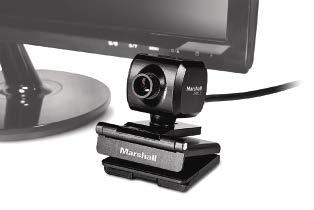
up to 1920x1080p resolution at 60/59.94/50 frame rates. The camera is also equipped with an adjustable, heavy-duty monitor/desk mount that can be adapted to any installation using a ¼-inch-20 tripod interface.
www.marshall-usa.com
CHIEF HAS unveiled its Impact On-Wall Kiosk. The depth can be adjusted to allow for a variety of display sizes, while the reversible hinges reportedly help avoid installation and service
obstructions. When open, the display remains mounted to the frame to provide users access for service and maintenance.
Chief is also continuing its focus on digital signage solutions with the TiLED Series, a modular LED mounting system designed to support creative videowall configurations. Built for the Samsung IF Series, an integrated plumb adjustment reportedly keeps everything flat, while offset mounting slots are said to protect the LEDs from friction that can occur when the display edges rub together.
Lastly, Chief’s line of heightadjustable display mounts is expanding to include electric solutions. The anti-collision technology halts and then reverses motion if it encounters an obstruction.
Chief’s
DESIGNED TO automatically translate connected SDI sources to NDI, the 3Play 3P1 from NewTek offers both NDI and SDI input, cross conversion and output. Built-in, dual-channel, ‘first replay’ telestration reportedly allows users to start, stop and scrub video in either direction.
3Play 3P1 can be integrated with NewTek’s IP Series, TriCaster TC1 and NVG1 Graphics Server to produce an ‘unparalleled’ IP production suite delivering a full IP workflow. The solution supports custom user interfaces that can be built from any browser on any networked device via NewTek LivePanel, according to the manufacturer.
Multichannel recording, internal transitions and social media publishing also feature.
With Ethernet connectivity, 3Play 3P1 is described as ideal for venues limited by conventional replay systems that wish to use networking technology and interconnected production workflows.
MEETING TODAY’S large-scale, multi-display, 1080p signal transmission, Aten’s VE8900R videoover-IP receiver and VE8900T videoover-IP transmitter deliver visually lossless 1080p A/V signals with low latency over long distances via a standard Gigabit network. According to the manufacturer, the VE8900R and VE8900T are effective, easy-to-use and economical digital
BLACKMAGIC DESIGN
added a new switcher and control panel for its Atem series that features 20 inputs, four M/Es and 16 next-generation Advanced Chroma Keyers. Called the Atem 4 M/E Broadcast Studio 4K, the switcher also offers two Ultra HD multiviewers, full 2D DVE, built-in SuperSource compositing engines with four picture-in-picture DVEs as well as full re-synchronisation on each input. A free software upgrade that adds all of the same
new features to the previous 2 M/E Broadcast Studio 4K model is also available.

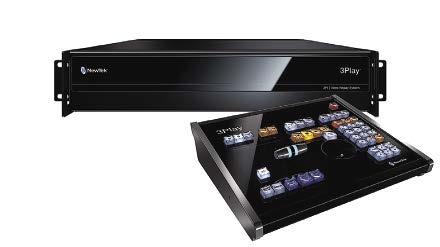
The Atem 1 M/E Advanced Panel includes amongst its features the latest broadcast technology,


address the challenges systems integrators encounter when implementing A/V over IP and reportedly offer limitless
manufacturer, users do not require any additional server PCs or software.
buttons, knobs, T-Bar fader and joystick and a built-in LCD. It has been designed to give Atem users control over their live production switcher when producing complex live television programmes with multiple cameras and sources. The unit fits in a standard equipment rack, making it suitable for use in fly-away kits, outside broadcast trucks and at live events with limited
www.blackmagicdesign.com
Rock church, The Experience is hailed as the world’s largest gospel concert and attracted a crowd of more than 750,000 to Lagos for its 2017 edition. Steve Davies, managing director of UK-based Subfrantic Production Services, has worked with his team alongside Lagos-based CyTech World Communication on this mammoth event for several years. Each year the event grows and, therefore, so must the sound setup.
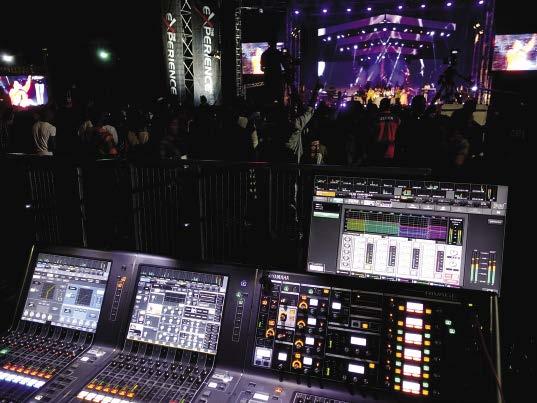
we brought over from the UK,’ says Mr Davies, discussing The Experience 2017, which occupied Tafawa Balewa Square. ‘We also brought over all of the radio mics and Radial 8 channel DIs. These were Shure ULX-D using a mix of B58/B87 and DPA d:facto heads. These then go through one of our VDC satellite box systems that also came over from the UK, and then they went into 72 channels of analogue splits, which again came over from the UK with us.’
‘Our relationship with House on the Rock goes back almost two decades,’ recalls Mr Davies. ‘We started working on and off for the London branch of the church, then through that we started working for the Lagos branch. A few years later I was asked to come and help with The Experience, and half a decade after that we are doing FOH, stage and broadcast sound, we do the LX design and operation, we do the stage video design and content, and we do the stage management – all done as part of a very close relationship with the church.’
The obvious question when planning for an event of this magnitude is where do you begin?

‘We started with a selection of mics that come from a variety of sources including House on the Rock, CyTech and then some specialist mics that

One side of the split fed a pair of Yamaha Rio3224-D I/O boxes and the Dante network that managed both the stage and broadcast audio. ‘This was a fully redundant system that involved a Yamaha CL5 and CL3 on stage, and a CL3 and CL5 handling the mix for the live broadcast, with an additional Rio1608-D running to FOH to take feeds from the audience response mics,’ Mr Davies explains. ‘The broadcast console also took record feeds from both the primary and secondary Dante feeds.
‘The other side of the split then went to the Yamaha RPio 622, which was running with 64 analogue ins, 16 analogue outs and 16 AES ins and outs,’ he continues. ‘This then ran on the TwinLANe network across dual fibres to the DSP-R10 and the PM10 surface at FOH. We then had a local Dante network at FOH that was used
for recording and virtual soundcheck at 96kHz. FOH outputs then left the console locally over AES.’

In regards to the choice of Yamaha control systems, Mr Davies explains that they have been used for The Experience year after year and have proven reliable. ‘We’ve had CLs on the gig since I first got involved five years ago,’ he says. ‘They’re solid and reliable in a difficult environment, everyone knows how they work and Yamaha’s support globally has always been second to none. Adding our PM10 was then a logical progression of that and its inclusion fitted perfectly with the church’s desire to continually make the event better and better. It’s the same with every side of the production: the stage is now much bigger and more suited to the production – five years ago we had no videowall on the stage, now we have loads and a Green Hippo media server to service it, while the LX board is an Avolites Sapphire that we also bring out with us, whereas four years ago, when we initially took on the lighting design, it was a Tiger Touch.’

As the crowds swell each year, the technical production manages to keep up. ‘Part of the success of The Experience on a technical level has been the relationships that we’ve built with local suppliers and technicians,’ Mr Davies reflects. ‘CyTech has been involved exactly as long as I have and every year they take on something new. It’s been very impressive to see how Cyril Utomoibor’s firm has grown and the addition of the Outline GTO this year was just awesome.’
On top of providing its services to ensure the show runs smoothly, Subfrantic also aims to give back to the local community in Lagos while working on The Experience. ‘One of my proudest achievements though is the training and exposure that we give to the church’s engineers and technicians,’ concludes the Subfrantic MD. ‘Everyone on my team takes time out to show groups of eager young Nigerians what we’re doing and why. We always do our best to get people involved.’
www.subfrantic.com
EM-380
EM-380





The EM-380 is a uniquely shaped and high quality condenser microphone designed for use in lecture halls, house of worship and paging applications. With power option selectable between battery or phantom power, It can be easily powered up and use.
The EM-380 is a uniquely shaped and high quality condenser microphone designed for use in lecture halls, house of worship and paging applications. With power option selectable between battery or phantom power, It can be easily powered up and use.


Try it now and feel the clarity of your voice.
Try it now and feel the clarity of your voice.
















We supply sound, not equipment.
We supply sound, not equipment.
TOAasiapacific www.toa.com.sg
TOAasiapacific www.toa.com.sg

Others dodge problems. We prefer to solve them. Of course, you can work your way around intermodulation and do some software magic but that is no real solution in the already congested and limited frequency spectrum. By design, Digital 6000 has no intermodulation artifacts. Our superior RF technology results in more channels and more flexibility for any production and any stage with no trade-off in transmission power or quality. Smarter, leaner, more efficient this is the built-in principle from user interface up to spectrum efficiency. Redundant Dante™ sockets and the command function are just two components of the recent update.
More about the next step towards the future of audio: www.sennheiser.com/digital-6000





No intermodulation. More channels. More power for your business.